Panasonic of North America PT-VW355N LCD PROJECTOR User Manual PT VW355N Part 2
Panasonic Corporation of North America LCD PROJECTOR PT VW355N Part 2
Contents
- 1. PT-VW355N_User Manual Part 1
- 2. PT-VW355N_User Manual Part 2
- 3. PT-VW355N_User Manual Part 3
- 4. PT-VW355N_User Manual Part 4
PT-VW355N_User Manual Part 2
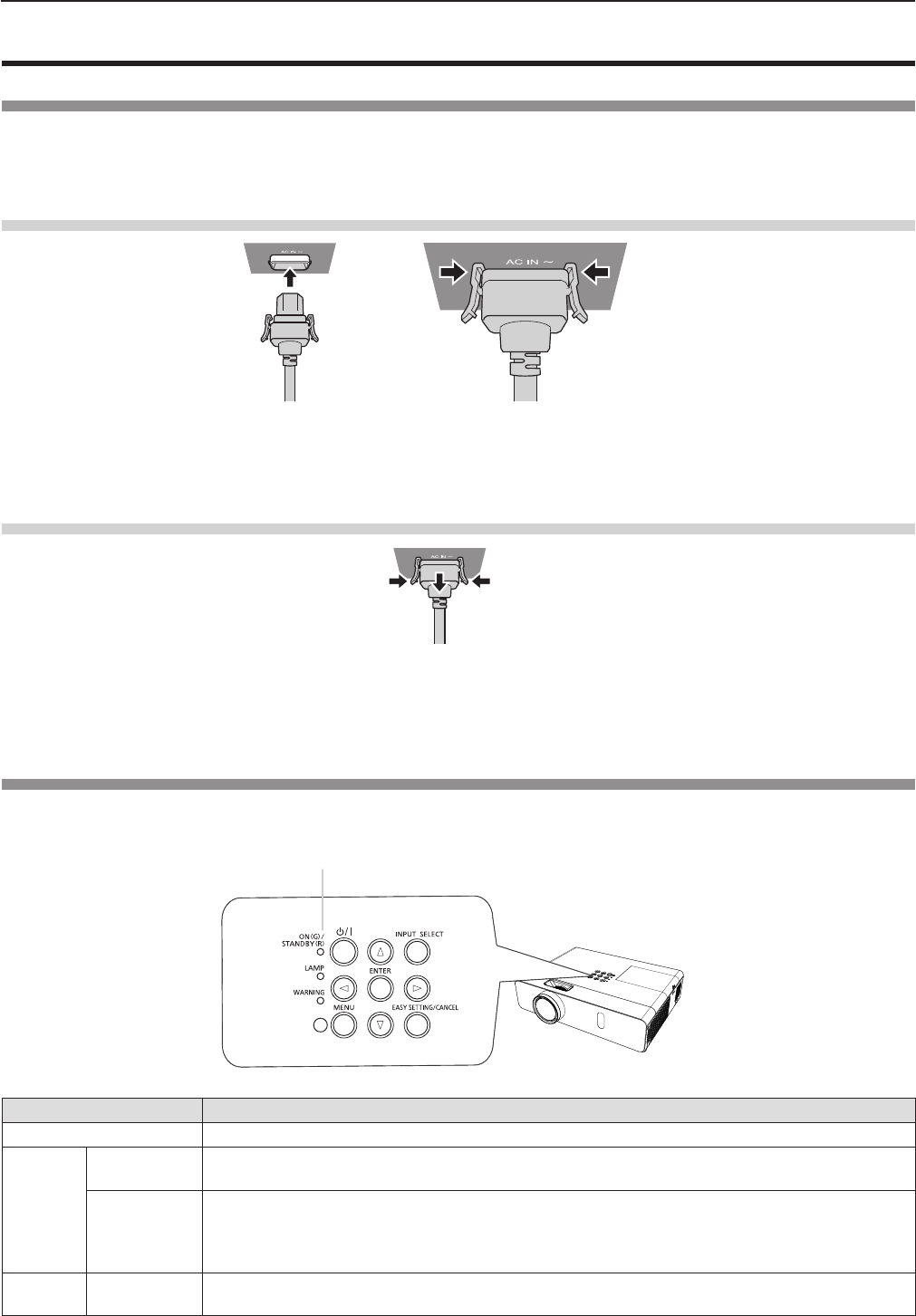
Powering on/off
Connecting the power cord
Make sure that the supplied power cord is securely xed to the projector body to prevent it from being removed
easily.
For details of power cord handling, refer to “Read this rst!” (x page 2).
Attaching
1) Check the shapes of the <AC IN> terminal on the back of the projector body and the power cord
connector and insert the plug completely in the correct direction (until you hear the side tabs click in
place).
Removing
1) Confirm that the projector is in standby mode, and remove the power plug from the outlet.
2) Remove the power cord connector from the <AC IN> terminal of the projector body while pressing the
side tabs.
Power indicator
The power indicator <ON(G)/STANDBY(R)> informs you the status of the power. Conrm the status of the power indicator
<ON(G)/STANDBY(R)> before operating the projector.
Power indicator <ON(G)/STANDBY(R)>
Indicator status Status
Off The power cord is unplugged.
Red
Lit The power is switched off (in standby mode). The
[PROJECTOR SETUP] menu
x
[ECO
MANAGEMENT] x
[STANDBY MODE] is set to [ECO].
Blinking
The power is switched off (in standby mode). The
[PROJECTOR SETUP] menu
x
[ECO
MANAGEMENT] x
[STANDBY MODE] is set to [NETWORK].*1
The power is switched off (in standby mode). The
[PROJECTOR SETUP] menu
x
[ECO
MANAGEMENT] x
[STANDBY MODE] is set to [NORMAL].*2
Orange Lit The projector is cooling down.
The power is switched off after a while. (Changes to the standby mode.)
ENGLISH - 41
Chapter 3 Basic Operations - Powering on/off
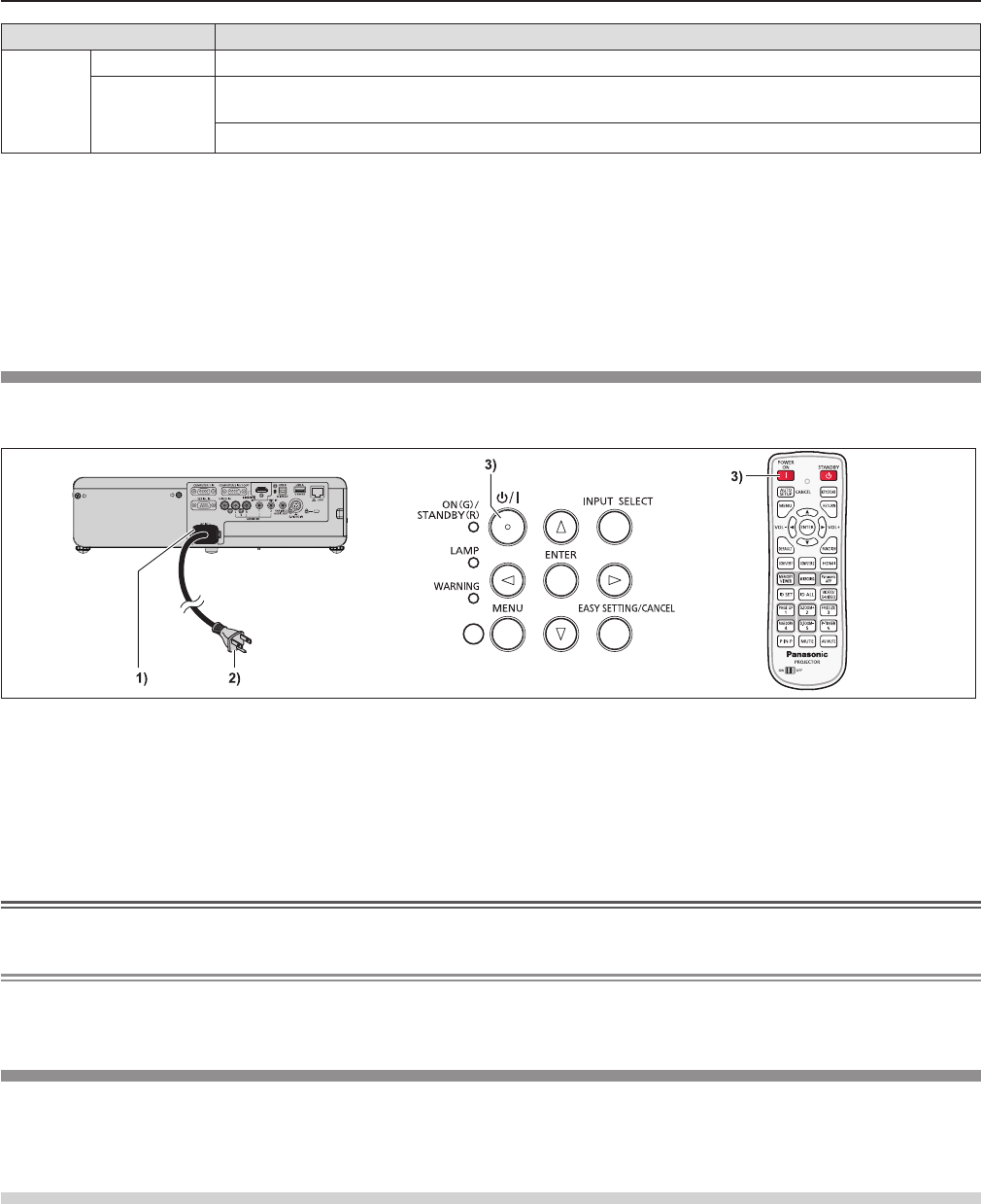
Indicator status Status
Green
Lit Projecting.
Blinking
The power is on and the lamp is not working. The
[PROJECTOR SETUP] menu
x
[ECO
MANAGEMENT] x
[POWER MANAGEMENT] is set to [READY].*3
The lamp starts work. The projector will project image after a while.*4
*1: The indicator will light as the following order:
2.75 seconds (light) → 0.25 seconds (off) → 0.75 seconds (light) → 0.25 seconds (off)
*2: The indicator will light as the following order:
2.75 seconds (light) → 0.25 seconds (off)
*3: The indicator will light as the following order:
2.0 seconds (light) → 2.0 seconds (off)
*4: The indicator will light as the following order:
0.5 seconds (light) → 0.5 seconds (off)
Powering On the Projector
Before switching on the projector, make sure all the other devices are correctly connected (x page 36) and remove the lens
cap.
1) Connect the power cord to the projector body.
2) Connect the power plug to an outlet.
fThe power indicator <ON(G)/STANDBY(R)> lights or blinks, and the projector will enter the standby mode.
3) Press the power <v/b> button on the control panel or the power on <b> button on the remote control.
fThe power indicator <ON(G)/STANDBY(R)> lights in green and the image is soon projected on the screen.
Attention
fBe sure to remove the lens cap before starting projection.
Note
fIf the [PROJECTOR SETUP] menu → [ECO MANAGEMENT] → [STANDBY MODE] is set to [ECO], it may take approx. 10
seconds longer before the projector starts projecting after the power is turned on, compared with when [NORMAL] is set.
When the initial setting screen is displayed
When the projector is switched on for the rst time after purchase as well as when [INITIALIZE ALL] in the [PROJECTOR
SETUP] menu is executed, then the initial setting screen is displayed. Set them in accordance with circumstances.
In other occasions, you can change the settings by menu operations.
Initial setting (display language)
Select the language to show on the screen.
After completed the initial setting, you can change the display language from the [LANGUAGE] menu.
1) Press asqw to select the display language.
42 - ENGLISH
Chapter 3 Basic Operations - Powering on/off
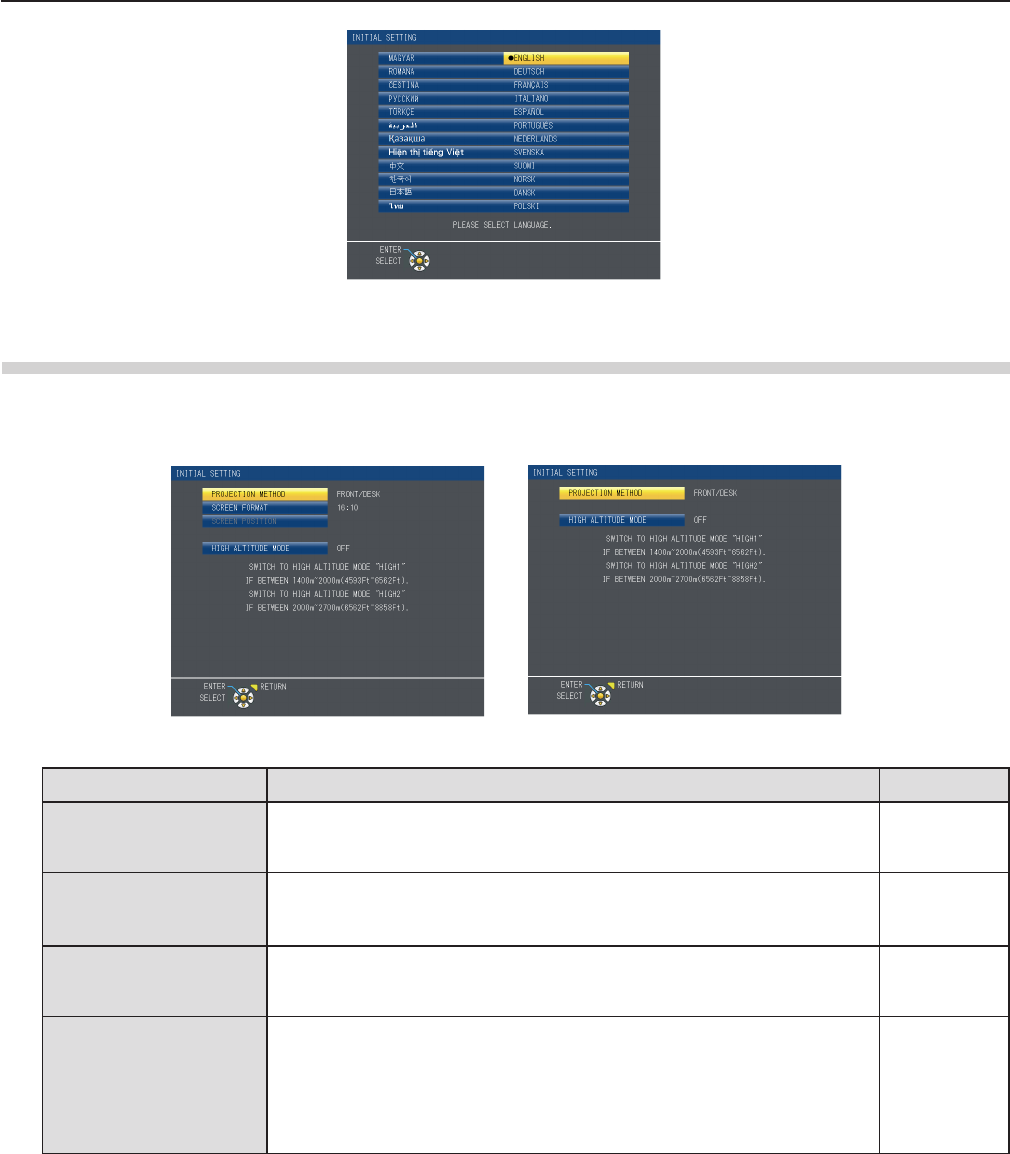
2) Press the <ENTER> button to proceed to the initial setting.
Initial setting (installation setting)
Set each item.
PT-VW355N PT-VX425N
1) Press as to select an item.
Item Description Page
[PROJECTION METHOD]
Set [PROJECTION METHOD] depending on the installation mode.
After completed the initial setting, you can change the setting from the
[PROJECTOR SETUP] menu → [PROJECTION METHOD].
78
[SCREEN FORMAT]*1
Set the screen format (aspect ratio) and display position of the image.
After completed the initial setting, you can change the settings of each
item from the [DISPLAY OPTION] menu → [SCREEN SETTING].
72
[SCREEN POSITION]*1
Set the display position of the image.
After completed the initial setting, you can change the settings of each
item from the [DISPLAY OPTION] menu → [SCREEN SETTING].
72
[HIGH ALTITUDE MODE]
Change the setting when the projector is used at high altitude.
Set it to [OFF] when using the projector at altitude lower than 1 400 m
(4 593'), set it to [HIGH1] when using the projector at altitude between
1 400 m (4 593') and 2 000 m (6 562') above sea level, and set it to
[HIGH2] when using the projector at altitude between 2 000 m (6 562')
and 2 700 m (8 858') above sea level.
78
*1 Only for PT-VW355N.
2) Press qw to switch the setting.
3) Press the <ENTER> button to perform next initial setting.
ENGLISH - 43
Chapter 3 Basic Operations - Powering on/off
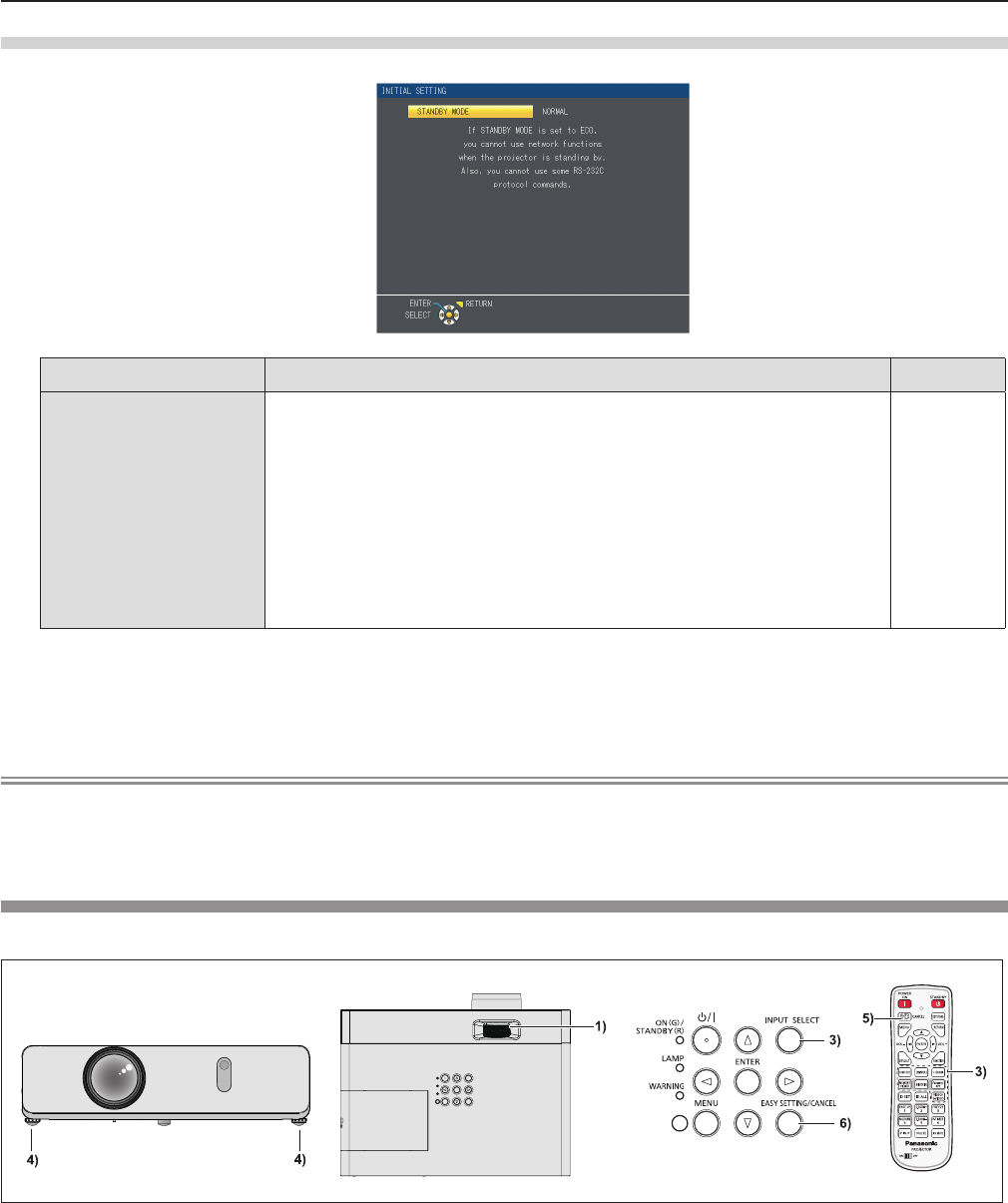
Initial setting (standby mode)
Item Description Page
[STANDBY MODE]
Set the operation mode during standby.
fThe default setting is [ECO] that keeps power consumption low during
standby.
fSet to [NORMAL] to use the network function or the serial communication
function during standby.
fSet to [NETWORK] to reduce power consumption during standby, and
to operate the projector via the wired LAN or the serial communication
function by using the Wake on LAN function.
After completed the initial setting, you can change the setting from the
[PROJECTOR SETUP] menu x [ECO MANAGEMENT] x [STANDBY
MODE].
80
1) Press qw to switch the setting.
2) Press the <ENTER> button.
fConrm the setting value and complete the initial setting.
Note
fIf you press the <RETURN> button while the initial setting screen is displayed, you can go back to the previous screen.
fThe above initial setting screen is the one displayed when the projector is switched on for the rst time after purchase.
When [PROJECTOR SETUP] menu → [INITIALIZE ALL] is executed, the setting of [STANDBY MODE] before execution is
displayed.
Making adjustments and selections
It is recommended that images are projected continuously for at least 30 minutes before the focus is adjusted.
1) Adjust the focus of the image roughly. (x page 46)
2) Change the settings of the [PROJECTOR SETUP] menu → [PROJECTION METHOD] depending on the
installation mode. (x page 78)
fRefer to “Navigating through the menu” (x page 56) for the operation of the menu screen.
3) Press the <INPUT SELECT> button on the control panel or the input selection (<COMPUTER 1>,
<COMPUTER 2>, <HDMI>, <VIDEO/S-VIDEO>) buttons on the remote control to select the input signal.
f<MEMORY VIEWER>, <MIRRORING> and <Panasonic APP> buttons on the remote control can also be used to
switch the input signal.
4) Adjust the front, back and sideway tilt of the projector with the adjustable feet. (x page 35)
5) If the input signal is an analog RGB signal, press the <AUTO SETUP/CANCEL> button.
44 - ENGLISH
Chapter 3 Basic Operations - Powering on/off
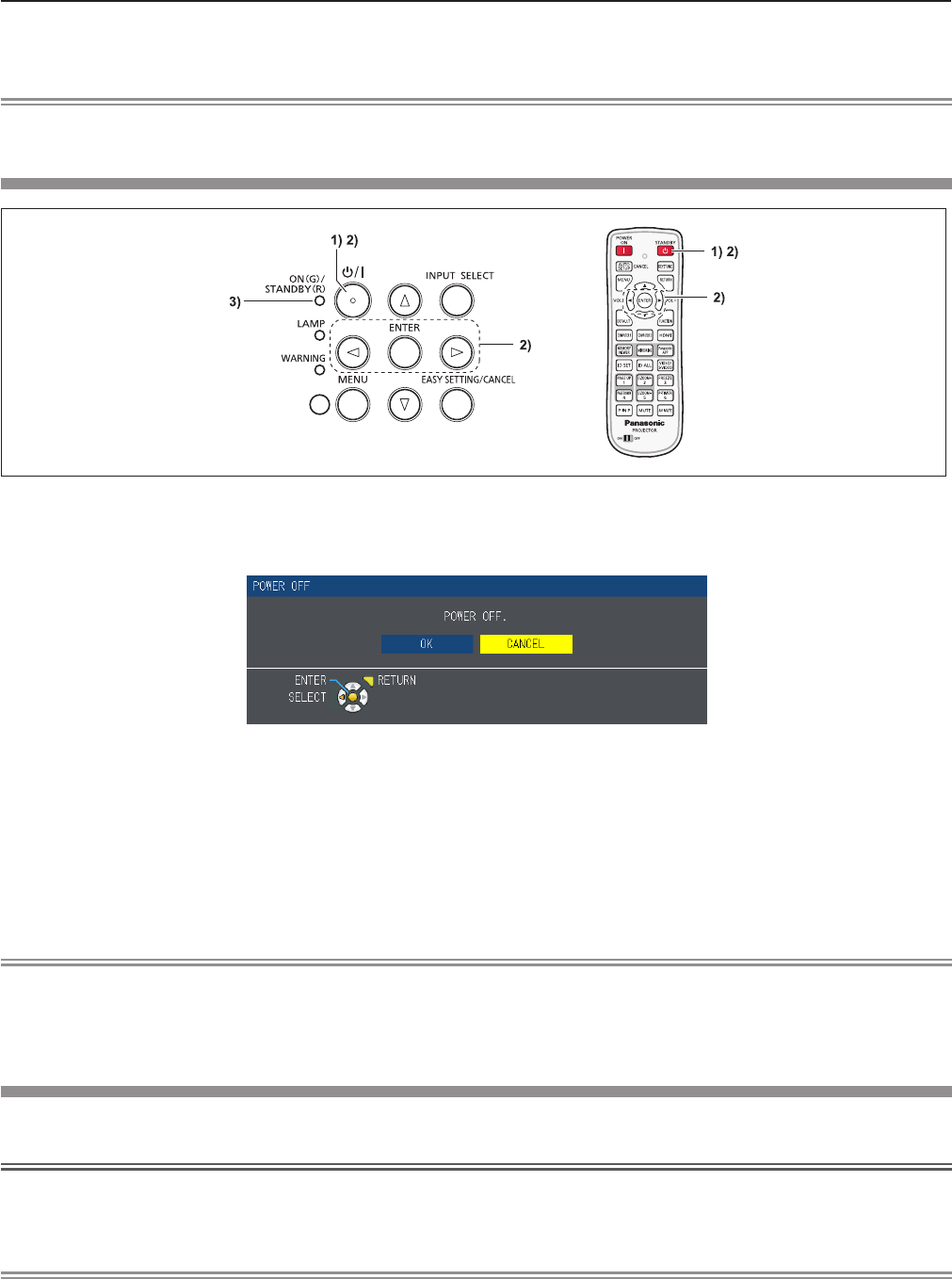
6) Press the <EASY SETTING/CANCEL> button on the control panel.
fFor details, refer to "Adjusting the projected image via EASY SETTING function". (x page 47)
Note
fWhen the projector is switched on for the rst time after purchase as well as when the [PROJECTOR SETUP] menu →
[INITIALIZE ALL] is executed, the initial setting screen is displayed after projection starts.
Powering Off the Projector
1) Press the power <v/b> button on the control panel or the power standby <v> button on the remote
control.
fThe following message appears.
2) Press qw to select [OK], and press the <ENTER> button.
(Or press the power <v/b> button on the control panel or the power standby <v> button on the
remote control again.)
fProjection of the image will stop, and the power indicator <ON(G)/STANDBY(R)> lights in orange. (The fans keep
running.)
3) Wait until the power indicator <ON(G)/STANDBY(R)> lights or blinks in red.
fThe projector enters standby mode when the power indicator <ON(G)/STANDBY(R)> lights or blinks in red.
Note
fWhile the power indicator <ON(G)/STANDBY(R)> is lighting in orange, the lamp is being cooled down and the projector
cannot be turned on. Wait until the power indicator <ON(G)/STANDBY(R)> starts lighting or blinking in red to turn on the
projector again.
fWhen packing the projector for transportation and storage, please make sure that each indicator is off.
Direct Power Off function
You can disconnect the power cord from the wall outlet or turn off the power breaker switch even during projection.
Attention
fDo not disconnect the power cord from the wall outlet or turn off the power breaker switch in a short time (about 1 minute)
after the lamp is lit. Doing so may cause the lamp fail to light while you powering on the projector next time, or result in
premature deterioration of the lamp.
Note
fWhen using the Direct Power Off function, you cannot restart the projector immediately after disconnecting the power cord
from the wall outlet or turning off the power breaker switch. The lamp remains high temperature and needs to cool down, so
it sometimes takes a longer time than usual for the lamp to light up again.
ENGLISH - 45
Chapter 3 Basic Operations - Powering on/off
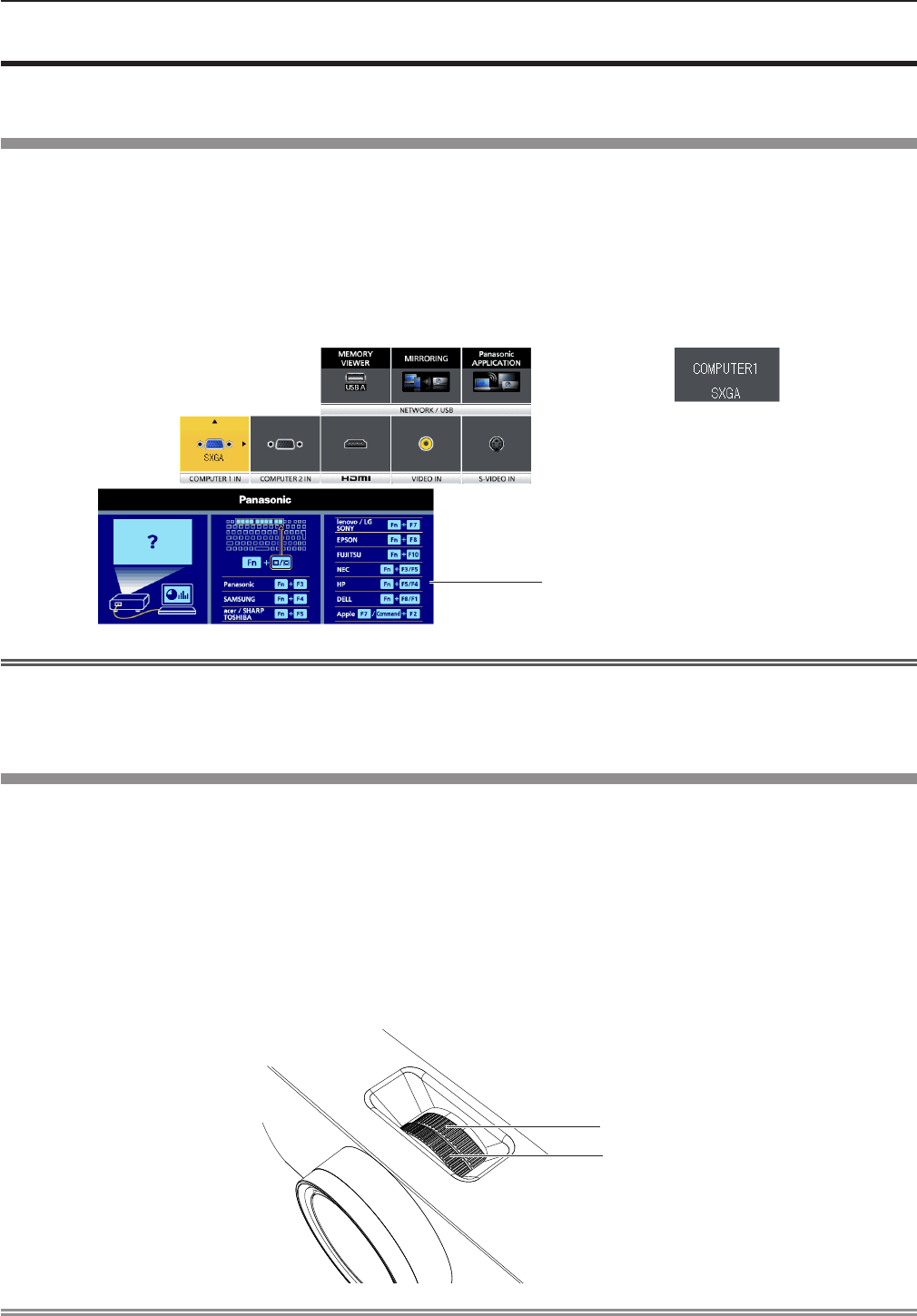
Projecting
Check the connections of the peripheral devices (x page 36) and connection of the power cord (x page 41) and switch
on the power (x page 42) to start the projector. Select the image and adjust the state of the image.
Selecting the input signal
Select an input signal.
1) Press <COMPUTER 1>, <COMPUTER 2>, <HDMI>, <VIDEO/S-VIDEO>, <MEMORY VIEWER>, <MIRRORING> or
<Panasonic APP> button on the remote control or <INPUT SELECT> button on the control panel.
fThe image of the signal being input in the selected terminal is projected.
fYou can check the input source through [DETAILED] / [SIMPLE] under the [DISPLAY OPTION] → [ON-SCREEN
DISPLAY] → [INPUT GUIDE] menu.
fYou can also select the input source by pressing asqw on the [DETAILED] screen.
[DETAILED] input guide [SIMPLE] input guide
If there is no signal input
([COMPUTER1], [COMPUTER2] or
[HDMI]), this screen will be displayed.
Check the output settings of your
computer.
Attention
fImages may not be projected properly depending on the connected device and DVD, video tape, etc. to be played. Set the
[PICTURE] menu → [RGB/YCBCR] or [RGB/YPBPR] (x page 64).
fCheck the aspect ratio of the screen and the image and select the optimum aspect ratio under the [POSITION] menu
(x page 68).
How to adjust the state of the image
If the projected image or the position is not correct when the positioning of the projector and the screen is correctly installed,
adjust the focus and zoom.
1) Adjust the projection angle.
fInstall the projector on a at surface and parallel to the screen so that the projected screen is rectangular.
fIf the screen is tilted downward, extend the adjustable feet and adjust the projection screen so that the projected screen
is rectangular.
fFor details, see “Adjusting adjustable feet” (x page 35).
2) Adjust the zoom and the focus.
fRotate the zoom ring to zoom in and out the image.
fRotate the focus ring to adjust the focus of the projected image.
Focus ring
Zoom ring
Note
fIt is recommended that the images are projected continuously for at least 30 minutes before the focus is adjusted.
fIf you adjust the focus, you may need to adjust the size of the image by turning the zoom ring again.
fIf keystone distortion occurs, see the [POSITION] menu → [KEYSTONE] (x page 65).
46 - ENGLISH
Chapter 3 Basic Operations - Projecting
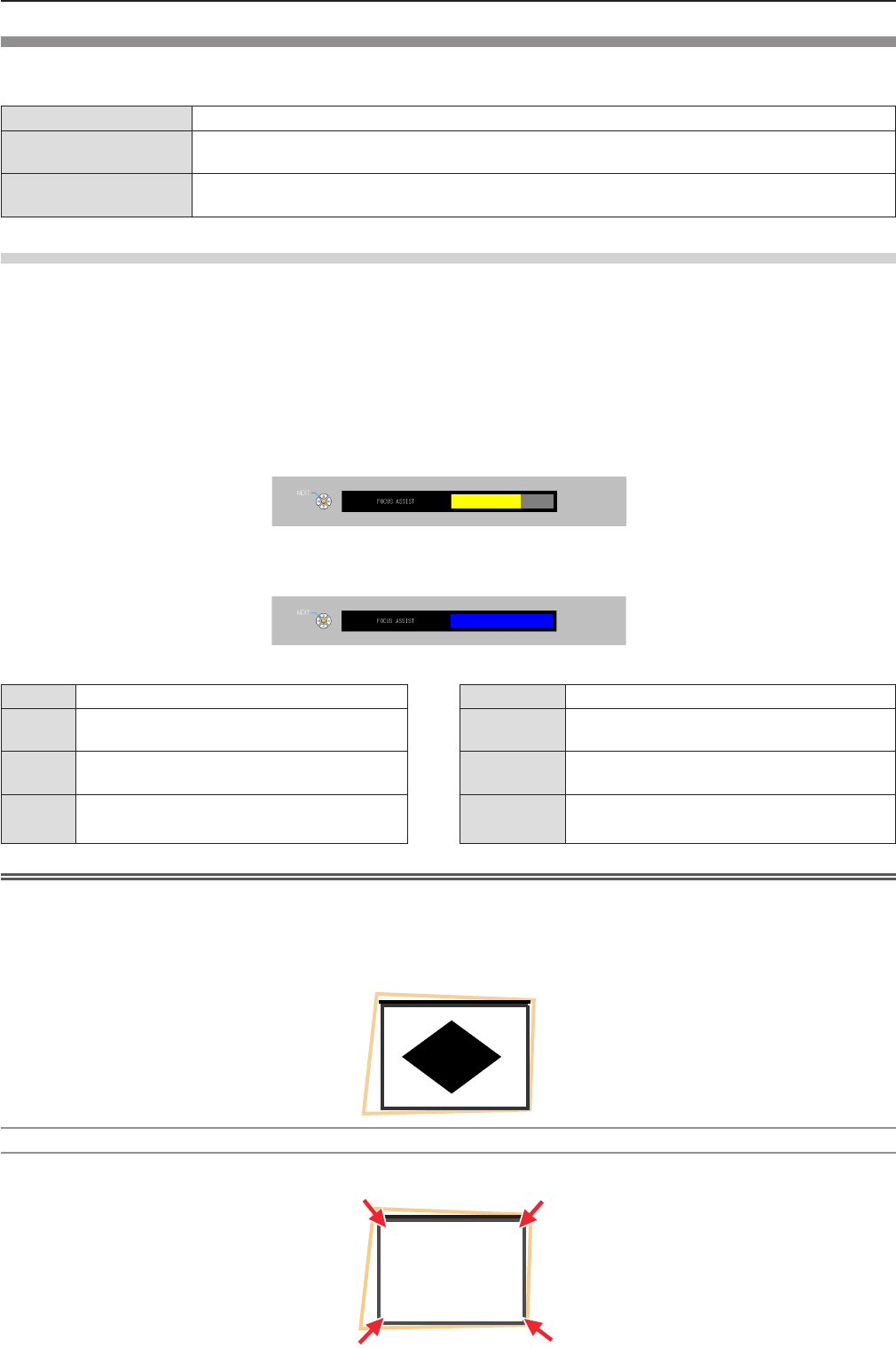
Adjusting the projected image via EASY SETTING function
EASY SETTING function makes the semi-automatically adjustment possible, so that to get the optimal image.
EASY SETTING function including these following setting items:
[FOCUS ASSIST] The color and the length of the bar assists the focus adjustment.
[SCREEN FIT] Detect and correct the image automatically to t the frame. If you can not detect the frame of the
screen, Keystone executes automatically.
[COLORBOARD] The color values will change automatically to reach the optimal white balance according to the
color of screen.
Executing the EASY SETTING function
When all of the above mentioned functions are set to [ON] (However, [SCREEN FIT] is set to [FULL] or [ORIGINAL]), the
adjustment orders are as follows.
1) Project an image.
2) Adjust the zoom ring so that the image is larger than the screen frame.
3) Press the <EASY SETTING/CANCEL> button on the control panel during projection.
fA test pattern for [FOCUS ASSIST] appears on the screen and the focus assist bar appears in the center bottom of the
screen.
4) Rotate the focus ring until the bar changes to the maximum level.
fThe focus assist bar will display different colors and different lengths according to the clarity of image.
Color State Length State
Red The projected image is turning unclear. Short The focus of the projected image is shifting
greatly.
Yellow The projected image is turning clear. Long The focus of the projected image is shifting
slightly.
Blue The projected image is optimal. Maximum
length The projected image is optimal.
Attention
fWhen the EASY SETTING function is started, the focus assist bar does not display blue color, even if the focus adjustment
is optimal. So readjust the focus with rotating the focus ring.
5) Press the <ENTER> button on the remote control or the control panel.
fThe adjustment image of [SCREEN FIT] appears.
Screen frame detected
If it detects a screen frame, the projected image is corrected to t the screen frame automatically.
ENGLISH - 47
Chapter 3 Basic Operations - Projecting
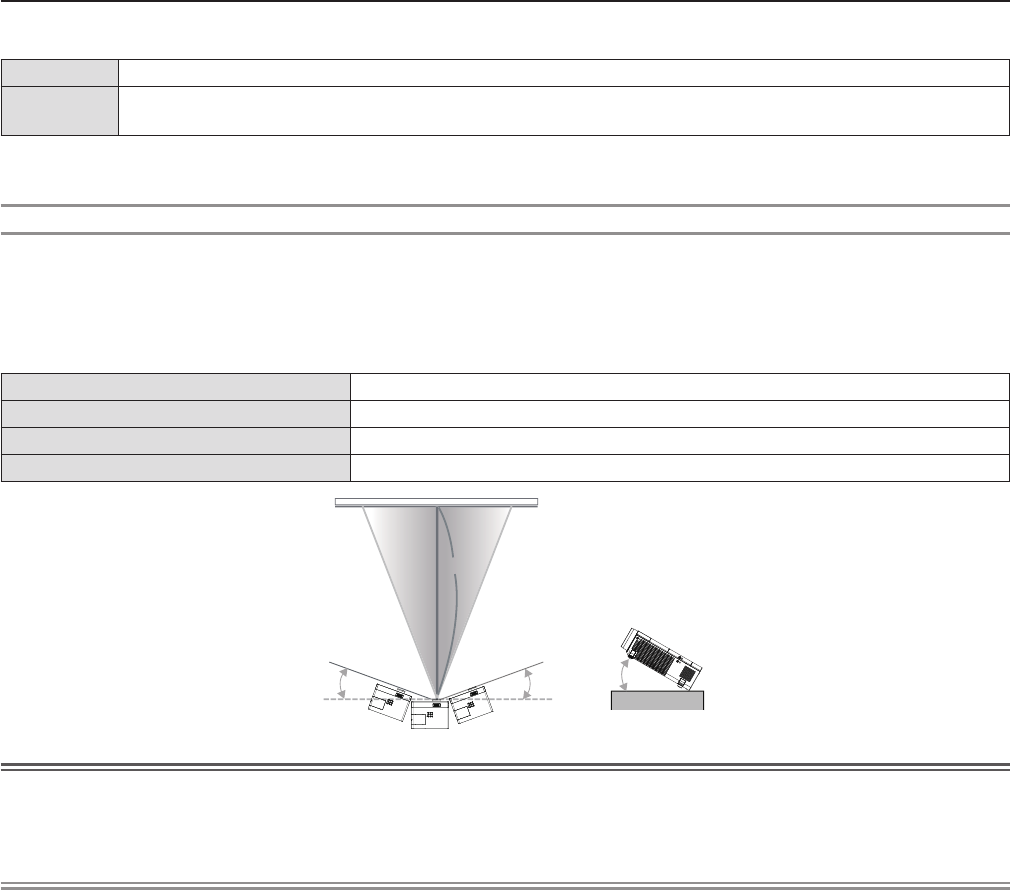
Adjust the image to t the screen according to the SCREEN FIT function's different states.
[FULL] The aspect ratio will change to t the screen frame.
[ORIGINAL] The aspect ratio will maintain to t the screen frame. The image may be displayed with the left and right/ top
and bottom parts cut off.
Then the COLORBOARD function is activated to get an optimal image. [CORNER CORRECTION] appears and it can be
adjusted manually if it is necessary (x page 66). It will exit without any operation in few seconds.
Screen frame undetected
If it does not detect a screen frame, the KEYSTONE function starts to work automatically and the keystone can be adjust
horizontally and vertically.
Then the COLORBOARD function is activated to get an optimal image. [KEYSTONE] appears and it can be adjusted manually
if it is necessary
(x page 65)
. It will exit without any operation in few seconds.
The conditions of SCREEN FIT function to adjust the projected image as follows.
Items Conditions
Projected image 40" - 100" (after correction)
Distance between projector and screen approx. 0.9 m to 3.5 m (when execute the keystone function, less than 2.5 m)
Correction angle approx. 20° right and left /approx. 30° up and down
30°
20°20°
0.9 m ~3.5 m
Attention
fIf the FOCUS ASSIST / SCREEN FIT / COLORBOARD function is working, please do not block some or all of the projected
image to interfere with the projected image, such as putting things before the camera which is on the front of the projector
body. Otherwise, the projected image will not be corrected properly.
Note
f[SCREEN FIT] corrects the projected image when it detects two or more sides inside the projected area, and ts the
detected frame.
f[SCREEN FIT] may not work well in bright environments and the projected image is in low contrast. In this case, make the
room darker, and then try executing [SCREEN FIT] again.
fBecause [SCREEN FIT] uses a sensor, it may not work properly depending on the condition of the projection surface
(deections, patterns, and so on), the distance between projector and screen, or the effects of outside light such as
uorescent. In this case, make the adjustments manually.
fIt is recommended to use a black frame screen when using SCREEN FIT function.
fWhen the EASY SETTING function does not complete, [Projection situation is out of condition.] message will be displayed.
Please reconrm the setting status of the projector.
fWhen the EASY SETTING function is executing, press the <EASY SETTING/CANCEL> button to exit, and then the next
function will execute.
fWhen the EASY SETTING function is executing, press the power <v/b> button to exit, and then return to the previous state
of the running EASY SETTING function.
fWhen the projector is mounted on a ceiling, do not use the EASY SETTING function. Otherwise it may not be adjusted
correctly.
fWhen the COLORBOARD function is executed, [PICTURE MODE] will be switched to [EASY SETTING] mode automatically.
When you want to cancel the status of the running EASY SETTING function, please set from [EASY SETTING] mode to any
other mode of [PICTURE MODE].
(x page 60)
fWhen the SCREEN FIT function is executed, [KEYSTONE] or [CORNER CORRECTION] will be adjusted automatically.
When you want to ne-tune the keystone or cancel the status of the running EASY SETTING function, please adjust
[KEYSTONE] or [CORNER CORRECTION] manually.
(x page 65)
48 - ENGLISH
Chapter 3 Basic Operations - Projecting
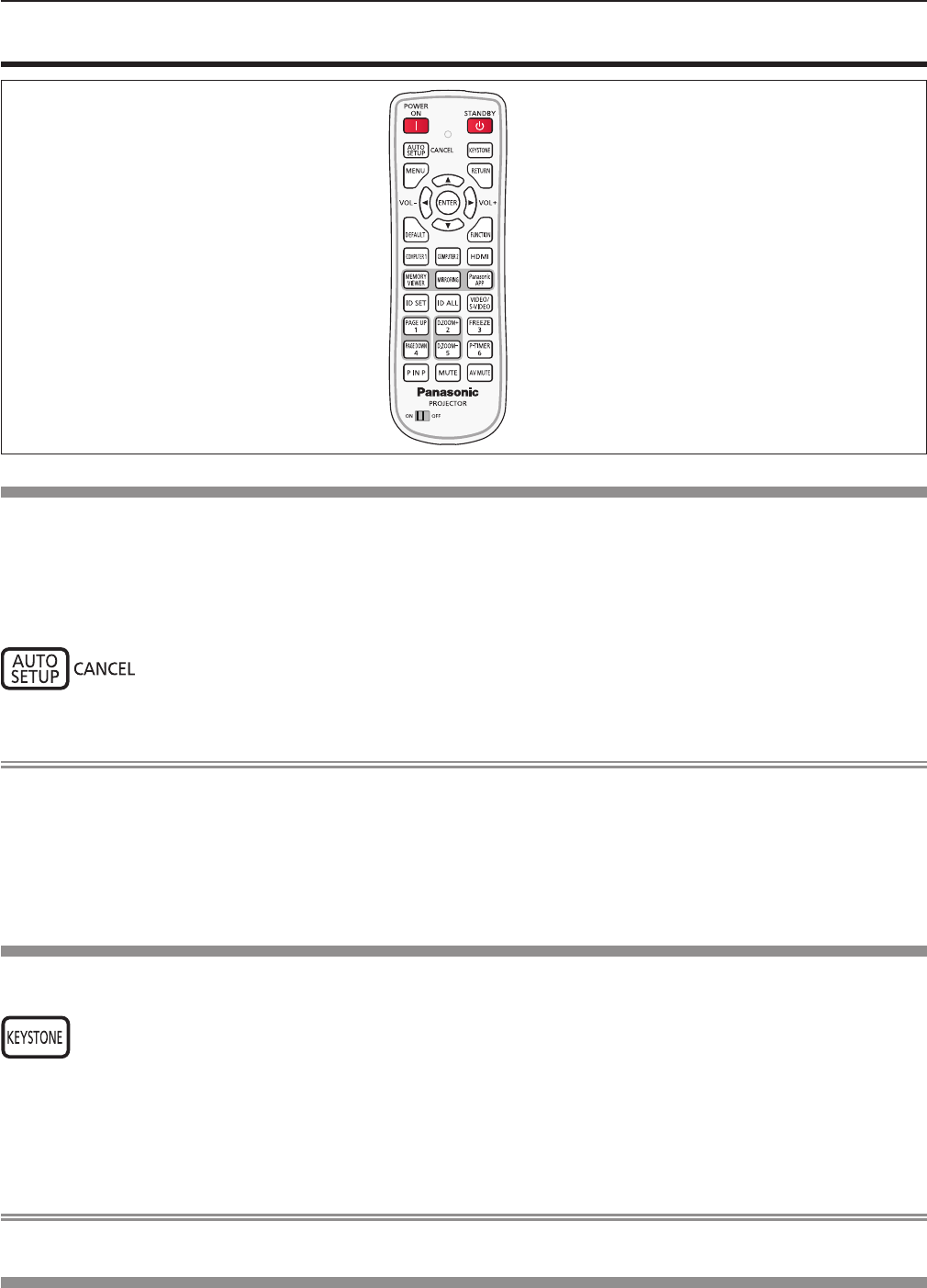
Basic operations by using the remote control
Using the AUTO SETUP function
The automatic setup function can be used to automatically adjust the resolution, clock phase, and image position when
analog RGB signals consisting of bitmap images such as computer signals are being input. Supplying images with bright
white borders at the edges and high-contrast black and white characters is recommended when the system is in automatic
adjustment mode.
Avoid supplying images that include halftones or gradation, such as photographs and computer graphics.
button
1) Press the <AUTO SETUP/CANCEL> button on the remote control.
Note
fThe [CLOCK PHASE] may shift even if it has completed without any incident. In such cases, adjust the [POSITION] menu →
[CLOCK PHASE] (x page 67).
fAutomatic adjustment may not work depending on the model of the computer and the input signal.
fImages may be disrupted for a few seconds during automatic adjustment, but it is not a malfunction.
fIf you press any button on the remote control during the automatic adjustment, the automatic adjustment will be canceled.
fIf the automatic setup function is used while moving images are being input, the adjustment may not be performed properly
even for an RGB signal that can use automatic setup.
Using the KEYSTONE button
You can correct the trapezoidal distortion that occurs when the projector is installed tilted or when the screen is tilted.
button
1) Press the <KEYSTONE> button to select [KEYSTONE] or press the <KEYSTONE> button again to
select [CORNER CORRECTION].
fThe [KEYSTONE] or [CORNER CORRECTION] individual adjustment screen is displayed.
2) Press asqw to adjust the item.
Note
fFor more details, refer to the [POSITION] menu → [KEYSTONE] (x page 65).
Controlling the volume of the speaker
You can control the volume of the projector’s speaker or audio output.
ENGLISH - 49
Chapter 3 Basic Operations - Basic operations by using the remote control
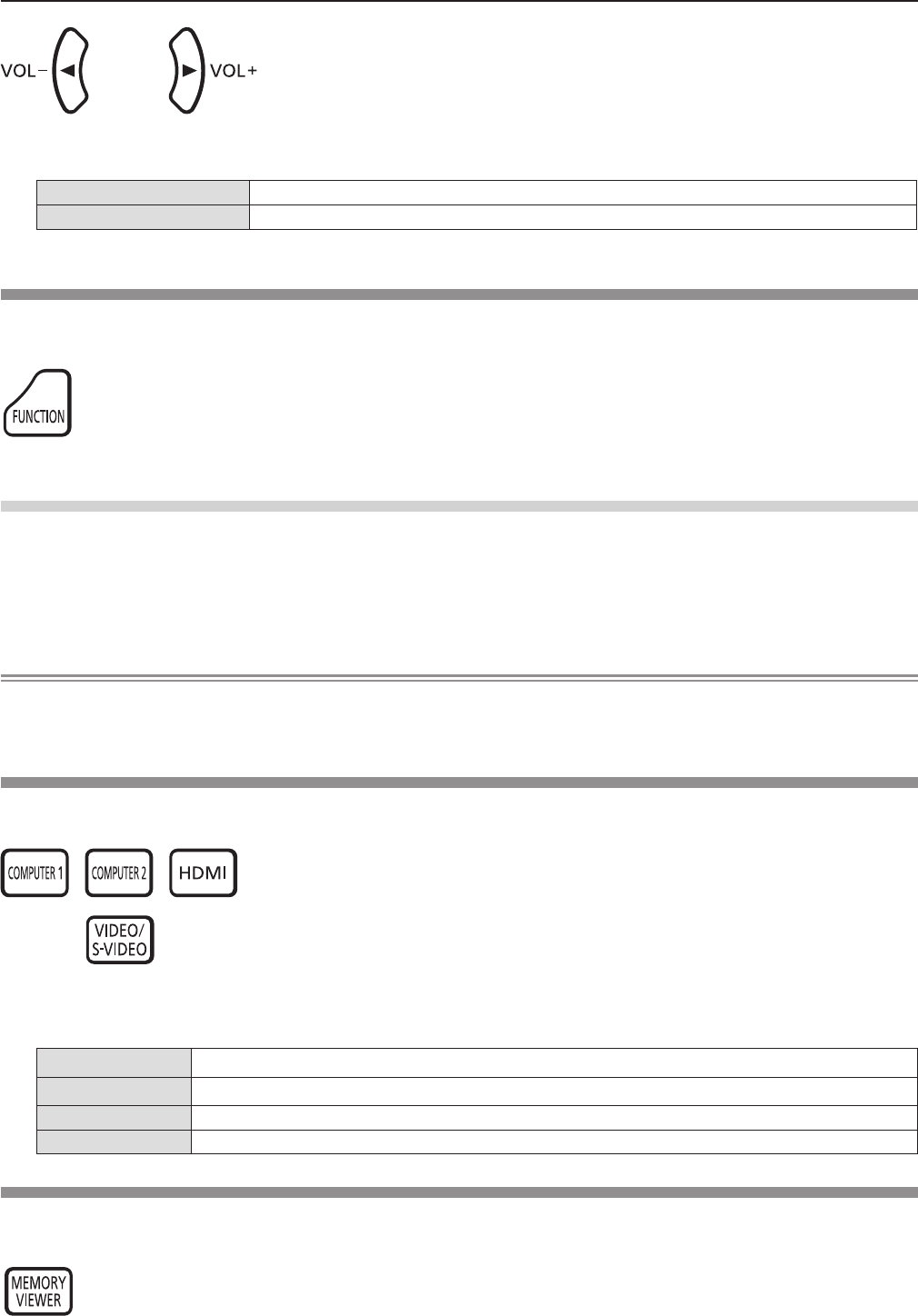
buttons
1) Press the <VOL -> button or <VOL +> button on the remote control.
fThis operation can be also performed using the qw buttons on the control panel.
<VOL -> Decreases the volume.
<VOL +> Increases the volume.
Using the FUNCTION button
Some operations in the menu can be assigned to the <FUNCTION> button on the remote control so that it can be used as an
easy shortcut button.
button
1) Press the <FUNCTION> button on the remote control.
To assign functions to the <FUNCTION> button
1) Press the <MENU> button on the control panel or the remote control to display the menu items (main
menu, sub-menu or details menu) you want to assign.
fRefer to “Navigating through the menu” (x page 56) for the operation of the on-screen menu.
2) Press and hold the <FUNCTION> button for 3 seconds or more.
Note
fAfter settings have been completed, the assigned menu item (main menu, sub-menu or details menu) will be displayed in
[ASSIGNED FUNCTION] of the operation guide under the menu.
fPerform the [PROJECTOR SETUP] menu → [FUNCTION BUTTON] (x page 81) when deallocating functions.
Switching the input signal
You can switch the input signals to project.
buttons
1) Press the <COMPUTER 1>, <COMPUTER 2>, <HDMI> or <VIDEO/S-VIDEO> button on the remote
control.
fYou can also press the <INPUT SELECT> button on the control panel.
<COMPUTER 1> Switch to COMPUTER1 input.
<COMPUTER 2> Switch to COMPUTER2 input.
<HDMI > Switch to HDMI input.
<VIDEO/S-VIDEO> Press this button to switch the input signal between VIDEO and S-VIDEO.
Using the MEMORY VIEWER function
It is possible to project the video and pictures which are stored in the USB memory when the USB memory inserted into the
projector.
button
1) Press the <MEMORY VIEWER> button on the remote control.
fSwitches the input to MEMORY VIEWER.
50 - ENGLISH
Chapter 3 Basic Operations - Basic operations by using the remote control
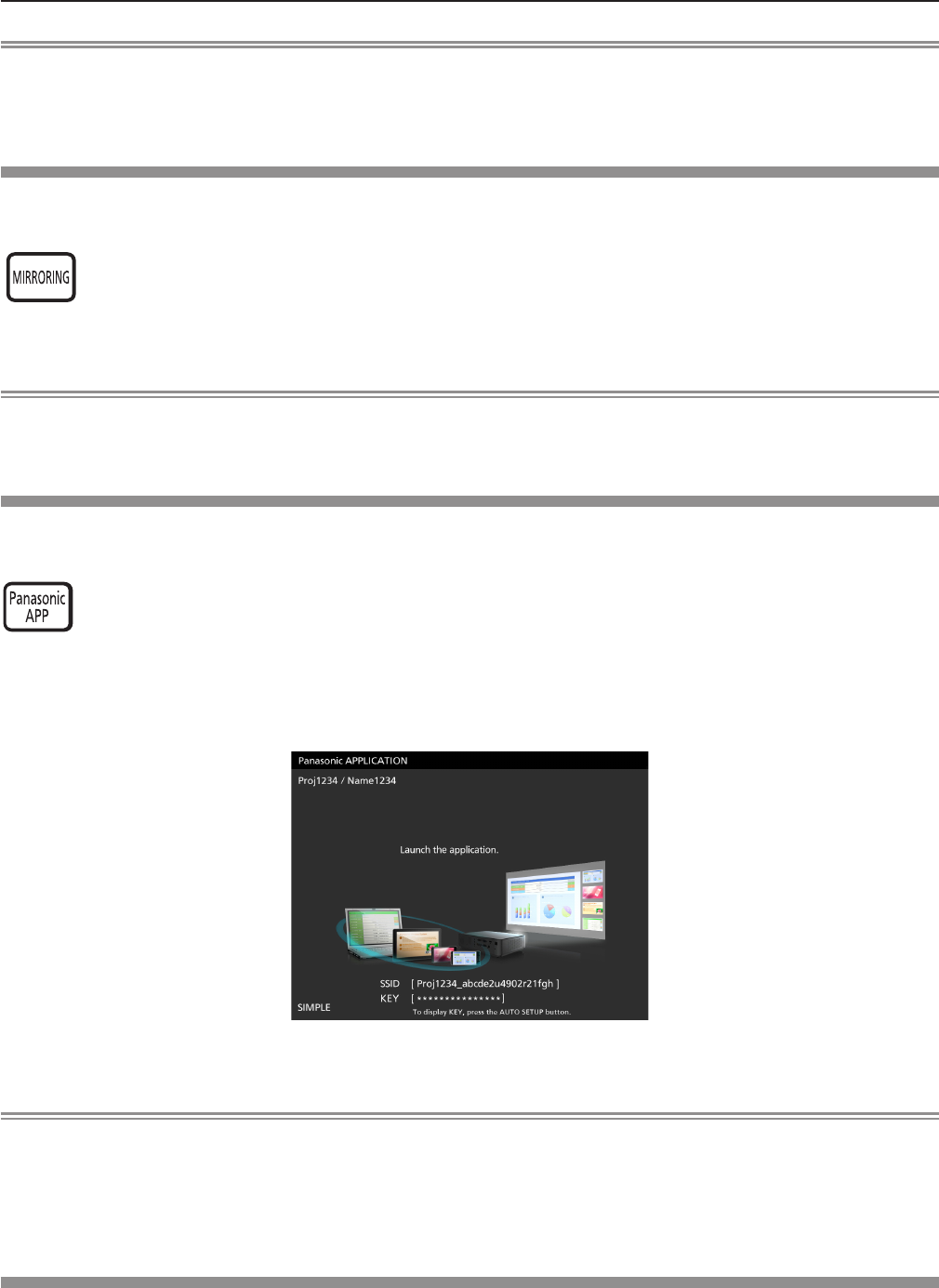
Note
fIf you want to use this function, insert the USB memory directly into the <USB A/VIEWER> port. For details, please refer to "
Memory Viewer function" (x page 116).
fWhen [MIRRORING] or [Panasonic APPLICATION] is selected in [CONNECTION LOCK], [KEY NOT APPLICABLE] screen
will be displayed (x page 92).
Using the MIRRORING function
The MIRRORING is a function to project the same images as the displayed images on the device with the projector. The
MIRRORING function connects the Intel® WiDi / Intel® Pro WiDi / Miracast compatible device to the projector via wireless LAN.
button
1) Press the <MIRRORING> button on the remote control.
fSwitches the input to MIRRORING.
Note
fFor details, please refer to "About MIRRORING" (x page 123).
fWhen [MEMORY VIEWER] or [Panasonic APPLICATION] is selected in [CONNECTION LOCK], [KEY NOT APPLICABLE]
screen will be displayed (x page 92).
Using the Panasonic APPLICATION function
This function can be used to project still images or video to the projector through the supplied software "Wireless Manager
ME6.3" with CD-ROM. In addition, the iOS application and Android application can also make it possible.
button
1) Press the <Panasonic APP> button on the remote control.
fSwitches the input to Panasonic APPLICATION, then the idle screen is displayed.
Panasonic APPLICAION idle screen
2) Press the <AUTO SETUP/CANCEL> button.
fIf you select [SIMPLE] in [WIRELESS LAN], the SSID and KEY will be displayed.
Note
fFor details, please refer to the "Operating Instructions-Wireless Manager ME6.3" in CD-ROM.
fWhen [MEMORY VIEWER] or [MIRRORING] is selected in [CONNECTION LOCK], [KEY NOT APPLICABLE] screen will be
displayed (x page 92).
fFor details about how to use the application for iOS/Android, refer to the application guide described in the following URL.
[iOS support site] http://panasonic.net/avc/projector/ios/
[Android support site] http://panasonic.net/avc/projector/android/
Using the PAGE UP/PAGE DOWN buttons
Scroll back and forth when viewing les such as PowerPoint which are projected through Wireless Manager.
ENGLISH - 51
Chapter 3 Basic Operations - Basic operations by using the remote control
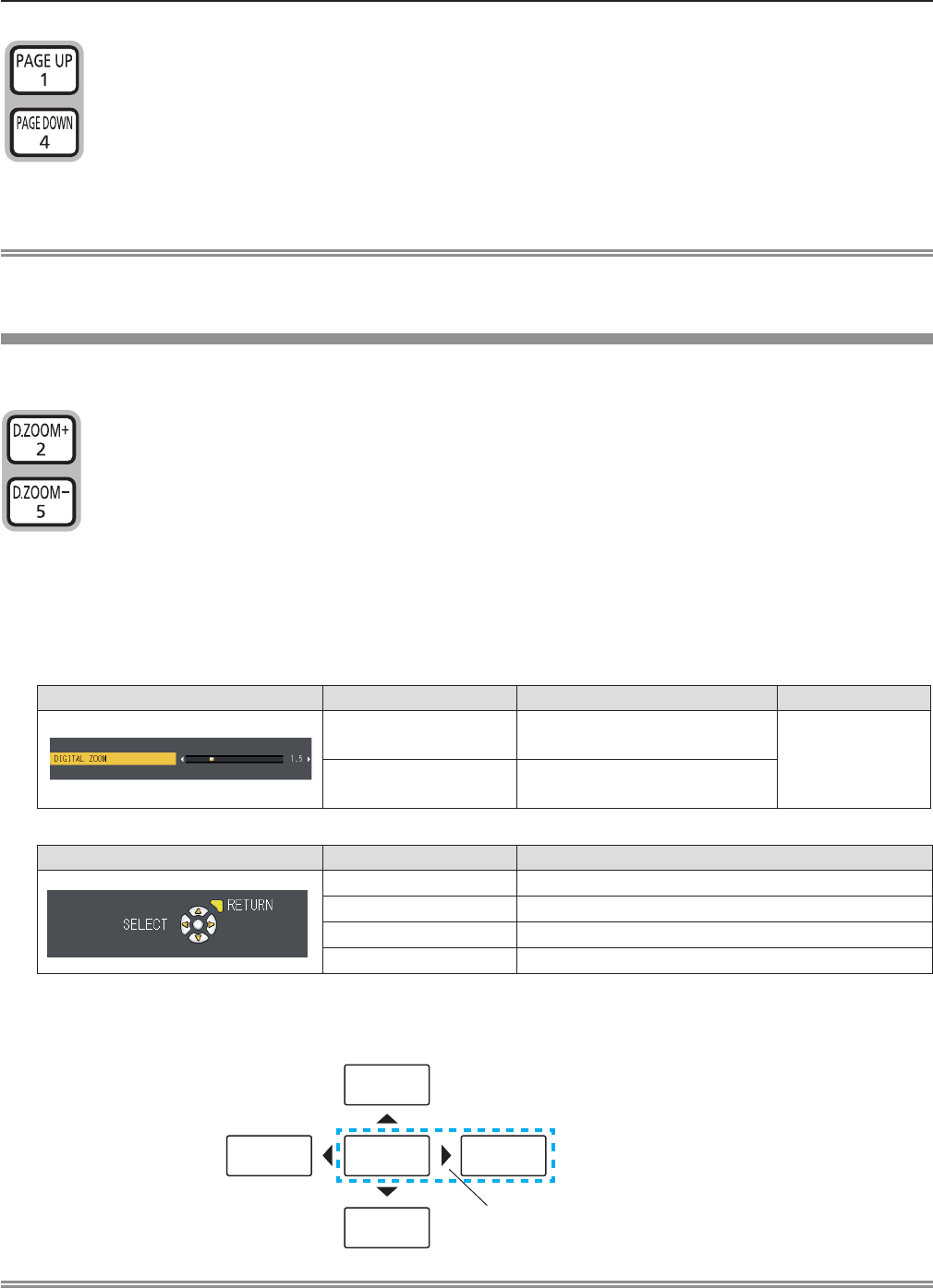
buttons
1) Press the <PAGE UP/PAGE DOWN> buttons on the remote control.
Note
fTo use these buttons, connect with Wired LAN or Wireless LAN, connect <USB B/DISPLAY> port of the projector and your
computer with a USB cable.
Using the DIGITAL ZOOM function
(Only for still image-based computer (RGB) and still image-based HDMI signals input)
You can enlarge the center area. You can also change the location of the area to be enlarged.
buttons
1) Press the <D.ZOOM +> button or < D.ZOOM -> button on the remote control.
fThe moving screen is displayed.
fThe [DIGITAL ZOOM] individual adjustment screen is displayed when executing the menu operation. For details, refer
to [DISPLAY OPTION] → [OTHER FUNCTIONS] (x page 75).
fYou can press the <RETURN> button to cancel the function.
rButton functions during [DIGITAL ZOOM]
Operation menu Operation Adjustment Adjustment range
Press the <D.ZOOM +>
button or w button. Increases magnication.
1.0 ~ 3.0
Press the <D.ZOOM ->
button or q button. Decreases magnication.
rButton functions of moving screen
Operation menu Operation Adjustment
Press the a button. The display position moves down.
Press the s button. The display position moves up.
Press the q button. The display position moves right.
Press the w button. The display position moves left.
fWhen you have executed the operation of remote control directly, the individual adjustment screen is not be displayed
and the operation menu of the moving screen is displayed. At this time, you can adjust the magnication by using the
<D.ZOOM +> button or <D.ZOOM -> button on the remote control.
Note
fMagnication can be set from 1.0x to 3.0x in 0.1 increments.
fWhen press the <MENU> button during [DIGITAL ZOOM], the adjustment value of DIGITAL ZOOM will be cancelled.
fWhen the input signals change during [DIGITAL ZOOM], the adjustment value of DIGITAL ZOOM will be cancelled.
fWhen [DIGITAL ZOOM] is active, the FREEZE function is not available.
fThe digital zoom function may not work properly for some still image-based signals.
ABC
ABC
ABC
ABC
ABC
図1
E.g. When you press the w
button, the display position
moves to the left.
52 - ENGLISH
Chapter 3 Basic Operations - Basic operations by using the remote control
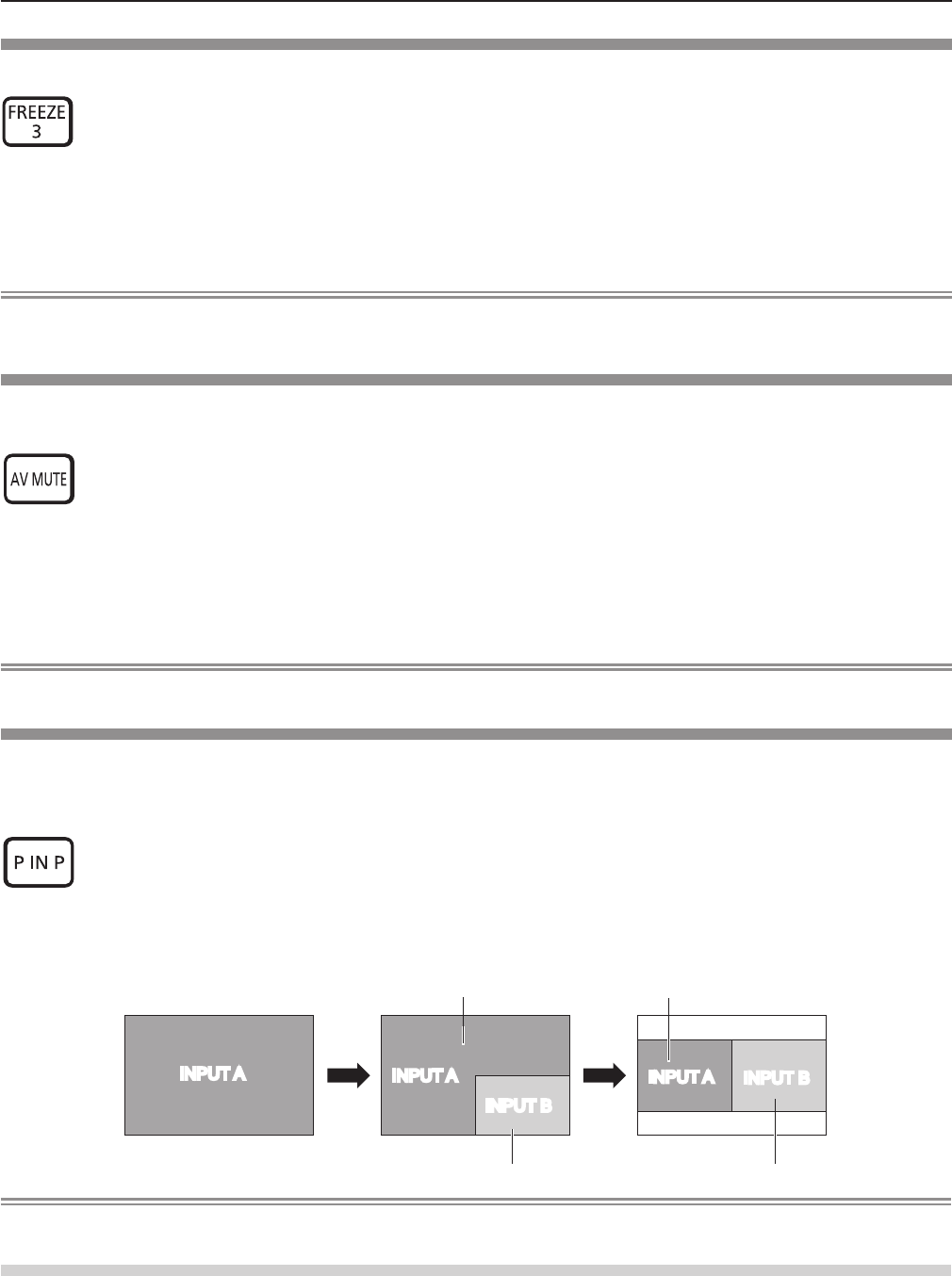
Using the FREEZE function
You can freeze the projected image and stop the sound temporarily, regardless of the playing condition of the external device.
button
1) Press the <FREEZE> button on the remote control.
fThe video is paused and the audio is muted. [FREEZE] is displayed on the lower left of the screen during FREEZE.
2) Press the <FREEZE> button again.
fThe video playback resumes and the audio is unmuted.
Note
fWhen no signal input, [KEY NOT APPLICABLE] message will appear.
fWhen [MIC] is set to [ON], the audio of MIC can be output even during FREEZE.
Using the AV MUTE function
If the projector is not used for a certain period of time during the meeting intermission, for example, it is possible to turn off the
audio and image temporarily.
button
1) Press the <AV MUTE> button on the remote control.
fThe audio and image turn off.
2) Press the <AV MUTE> button again.
fThe audio and image turn on.
Note
fWhen [MIC] is set to [ON], the audio of MIC can be output even during AV MUTE.
Using the P IN P function
(Only for PT-VW355N)
Two images can be projected simultaneously in form of projection mode (a small sub screen in the main screen [P IN P] / a
small sub screen side by side with the main screen [SIDE BY SIDE]).
button
1) Press the <P IN P> button on the remote control.
fPress this button to switch the mode ([P IN P]/[SIDE BY SIDE]).
INPUT A INPUT A
INPUT B
INPUT A INPUT B
Main screen
Sub screen
Main screen
Sub screen
Note
fFor details, refer to [P IN P] (x page 75).
Switch the input source
You can switch the input source of the main screen and sub screen while the P IN P function is operating.
rSwitch the input source of the main screen
Switch the input source as the same operation as the single screen.
rSwitch the input source of the sub screen
When two screens are displayed (when no menu is displayed), press the <ENTER> button, the red frame of the sub screen
will be displayed. Switch the input source as the same operation as the single screen.
ENGLISH - 53
Chapter 3 Basic Operations - Basic operations by using the remote control
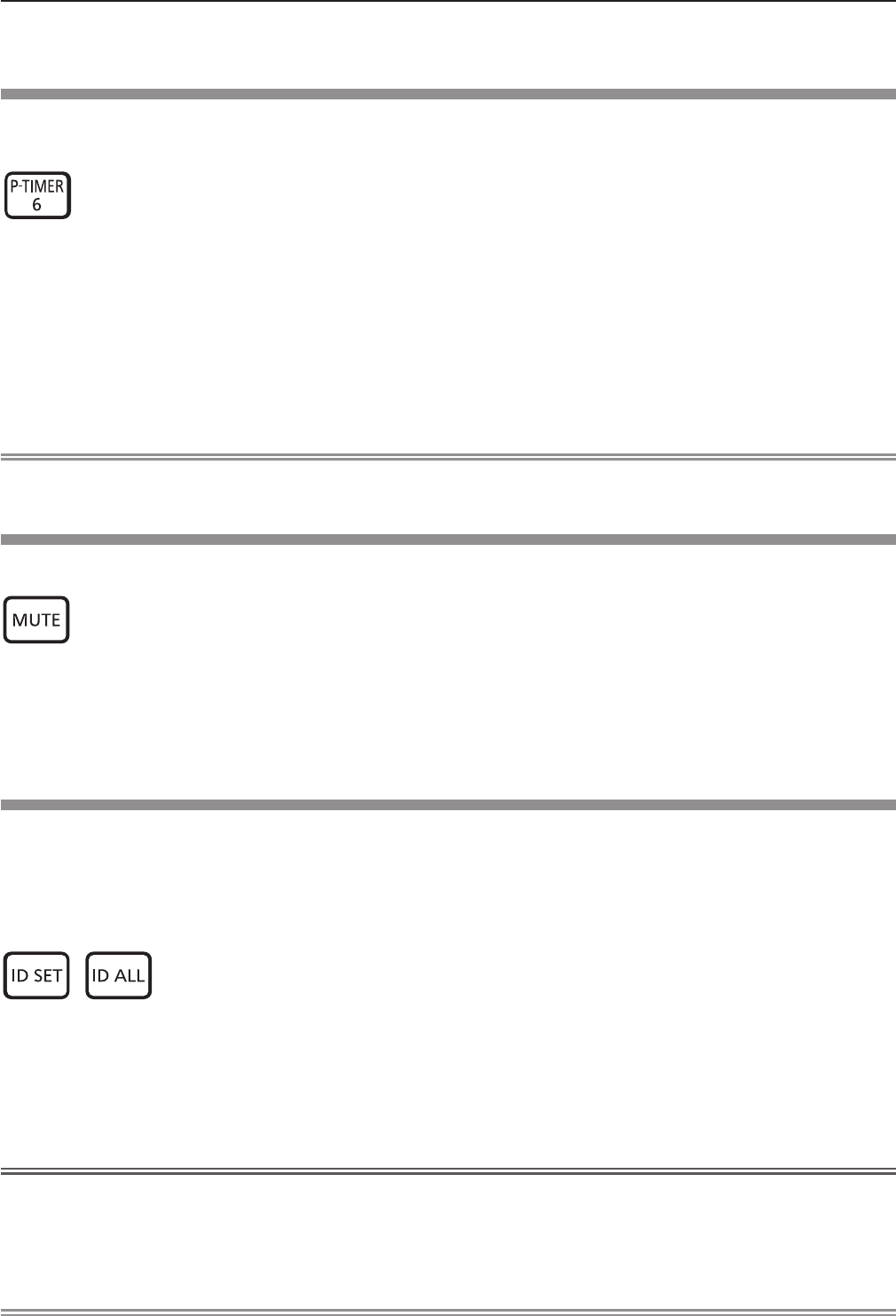
Press the <ENTER> button again, the red frame of the sub screen will disappear and then return to switch the input source of
the main screen.
Using the P-TIMER function
You can operate the presentation timer function.
Presentations, etc. can be performed while checking the elapsed time or time remaining in the preset time.
button
1) Press the <P-TIMER> button on the remote control.
fThe count is started.
fThe elapsed time or the remaining time is displayed at the bottom right of the projected image.
2) Press the <P-TIMER> button again.
fThe count is stopped.
3) Press the <P-TIMER> button again.
fThe count is resumed.
Note
fPressing the <P-TIMER> button for at least 3 seconds to release the P-TIMER function.
fFor details, please refer to the [DISPLAY OPTION] menu → [P-TIMER] (x page 74).
Using the MUTE function
This button allows you to turn off the audio output temporarily.
button
1) Press the <MUTE> button on the remote control.
fThe audio turns off.
2) Press the <MUTE> button again.
fThe audio turns on.
Setting the ID number of the remote control
When you use the system with multiple projectors, you can operate all the projectors simultaneously or each projector
individually by using single remote control, if unique ID number is assigned to each projector.
After setting the ID number of the projector, set the same ID number to the remote control.
The factory default ID number of the projector is set to [ALL]. When using a single projector, press the <ID ALL> button on
the remote control. Also, you can control a projector by pressing the <ID ALL> button on the remote control even if you do not
know the projector ID.
buttons
1) Press the <ID SET> button on the remote control.
2) Within five seconds, press the one-digit ID number set on the projector using the number (<1> - <6>)
buttons.
fIf you press the <ID ALL> button, you can control the projectors regardless of the ID number setting of the projector.
Attention
fSince the ID number of the remote control can be set without the projector, do not press the <ID SET> button on the remote
control carelessly. If the <ID SET> button is pressed and no number (<1> - <6>) buttons are pressed within ve seconds, the
ID number returns to its original value before the <ID SET> button was pressed.
fThe ID number set on the remote control will be stored unless it is set again. However, it will be erased if the remote control
is left with dead batteries. Set the same ID number again when the batteries are replaced.
Note
fSet the ID number of the projector from the [PROJECTOR SETUP] menu → [PROJECTOR ID]. (x page 78)
54 - ENGLISH
Chapter 3 Basic Operations - Basic operations by using the remote control

Chapter 4 Settings
This chapter describes the settings and adjustments you can make using the on-screen menu.
ENGLISH - 55
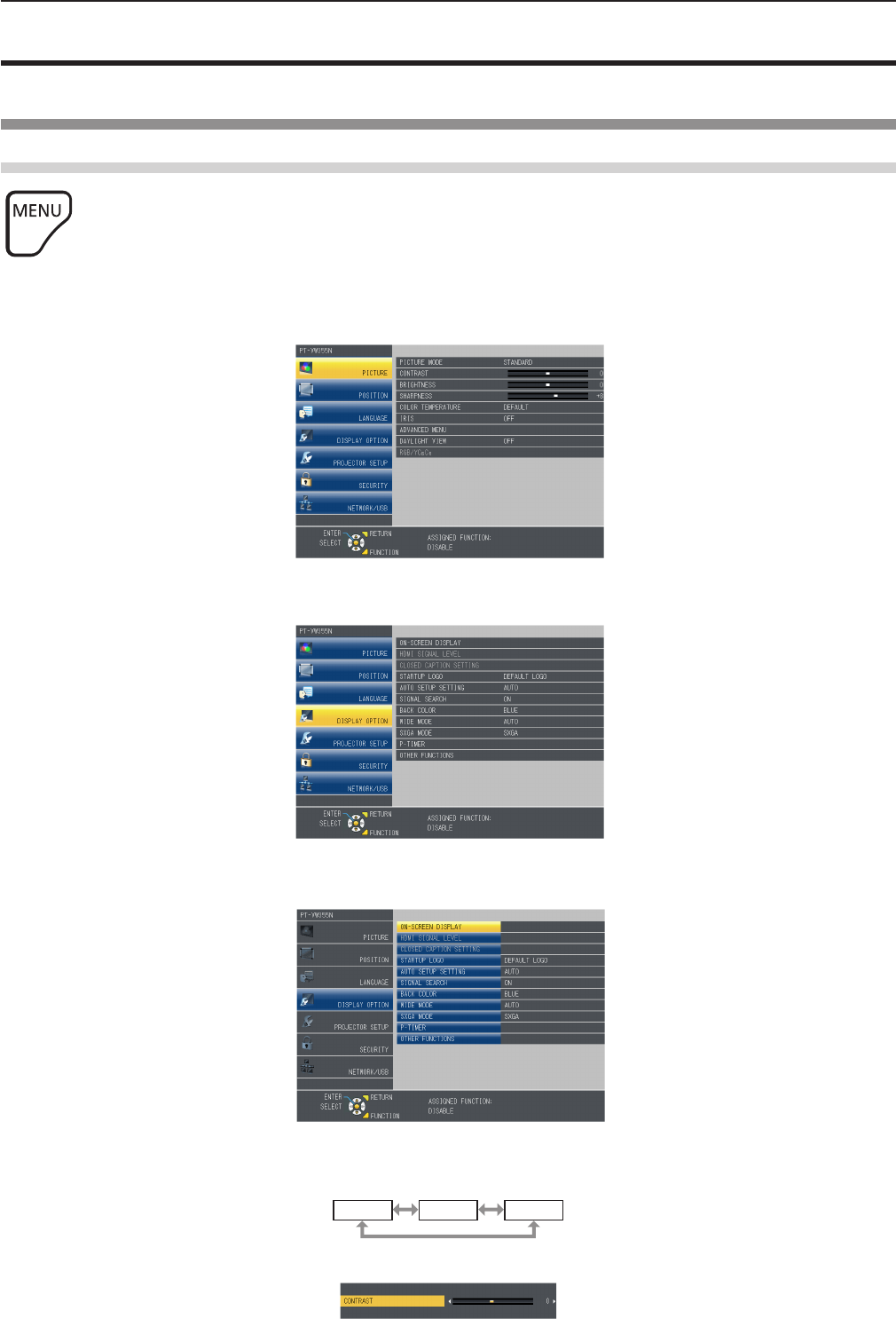
Menu Navigation
The on-screen menu (Menu) is used to perform various settings and adjustments of the projector.
Navigating through the menu
Operating procedure
button
1) Press the <MENU> button on the remote control or the control panel.
fThe main menu screen appears.
2) Press as to select an item from the main menu.
fThe selected item is highlighted in yellow.
3) Press the <ENTER> button.
fThe sub-menu is displayed, and sub-menu items become selectable.
4) Press as to select the desired sub-menu item, press qw or the <ENTER> button to set or adjust settings.
fSome items will switch in order as follows each time you press qw.
ABC
fFor some items, press qw to display an individual adjustment screen with a bar scale as shown below.
56 - ENGLISH
Chapter 4 Settings - Menu Navigation
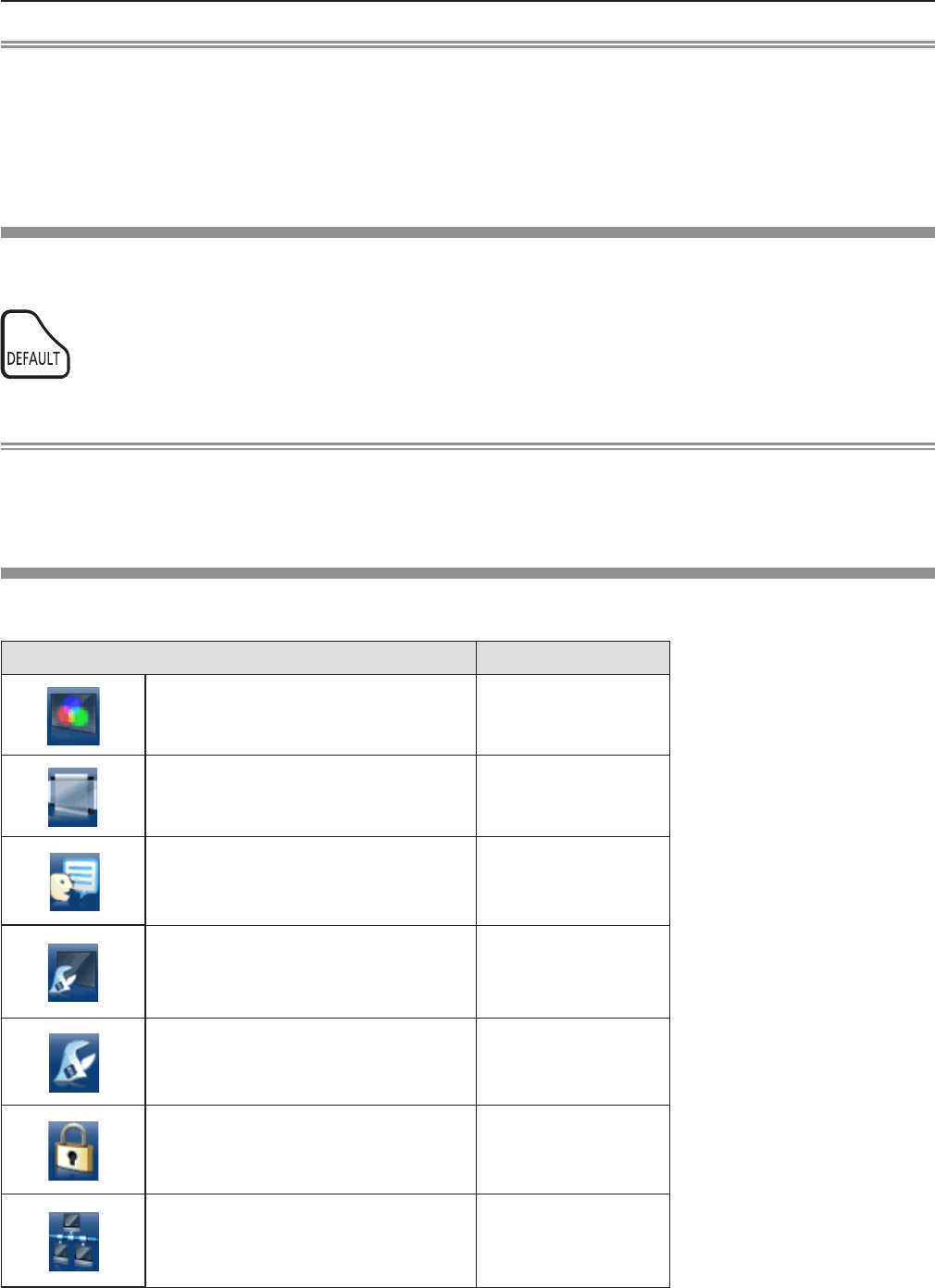
Note
fPressing the <MENU> button or <RETURN> button while the menu screen is displayed returns to the previous menu.
fSome items may not be adjusted or used for certain signal formats to be input to the projector. The menu items that cannot
be adjusted or used are shown in gray characters, and they cannot be selected. [DIGITAL CINEMA REALITY] and [FRAME
LOCK] may not be displayed depending on the input signal.
fSome items can be adjusted even if signals are not input.
fIndividual adjustment screen is cleared automatically if no operation is performed for approximately ve seconds.
fFor menu items, refer to “Main menu” (x page 57) and “Sub-menu” (x page 58).
Resetting adjustment values to the factory default
If the <DEFAULT> button on the remote control is pressed, the values adjusted in the menu items are restored to the factory
default settings.
button
1) Press the <DEFAULT> button on the remote control.
Note
fYou cannot reset all the settings to the factory default at a time.
fTo reset all the settings adjusted in the sub-menu item to the factory default one at a time, execute the [PROJECTOR
SETUP] menu → [INITIALIZE ALL] (x page 84).
fSome items cannot be reset by pressing the <DEFAULT> button. Adjust each item manually.
Main menu
The main menu consists of the following 7 menu items.
When a main menu item is selected, the screen changes to a sub-menu selection screen.
Main-menu item Page
[PICTURE] 60
[POSITION] 65
[LANGUAGE] 69
[DISPLAY OPTION] 70
[PROJECTOR SETUP] 77
[SECURITY] 85
[NETWORK/USB] 88
ENGLISH - 57
Chapter 4 Settings - Menu Navigation
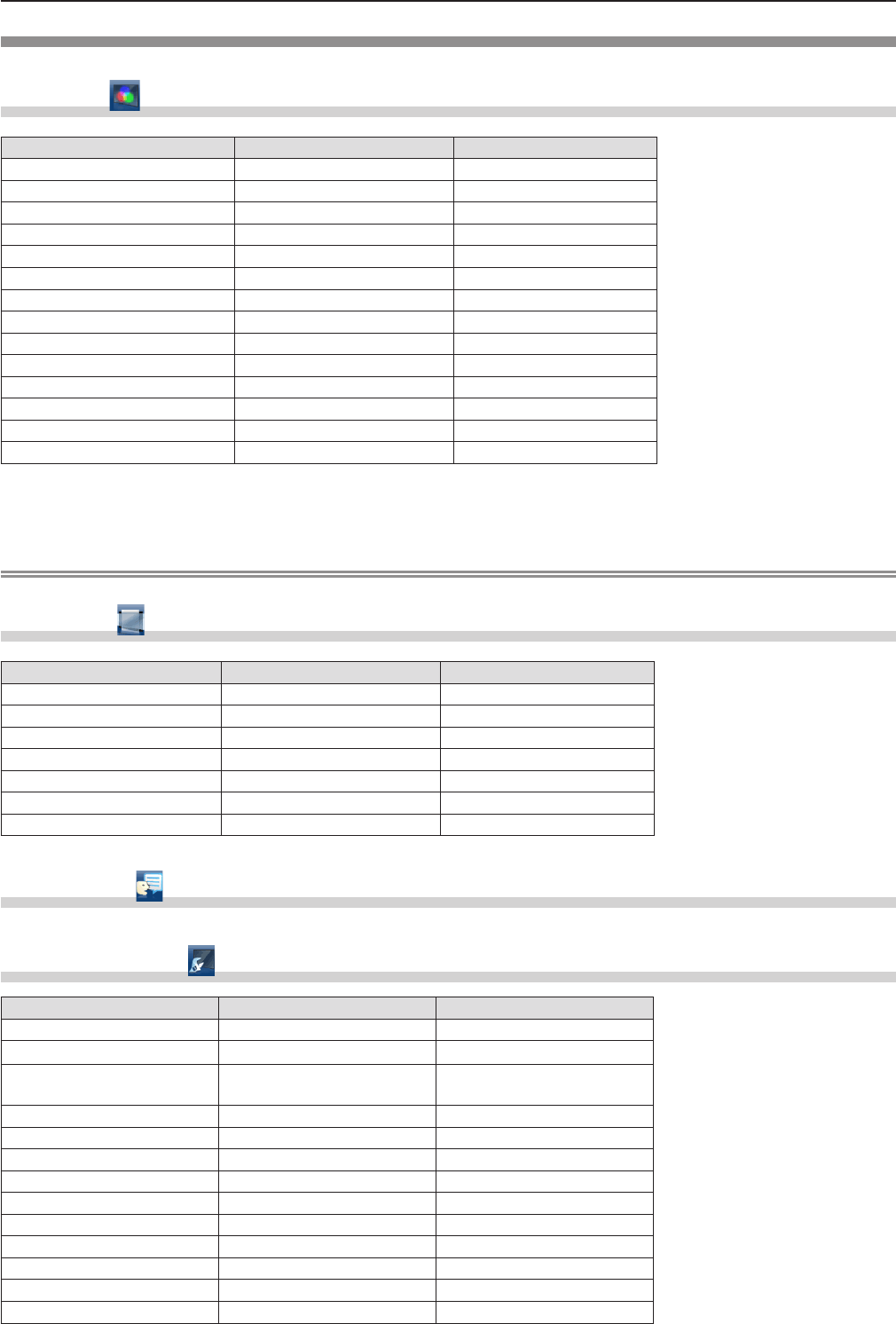
Sub-menu
The sub-menu screen of the selected main menu appears, and you can set and adjust the various items in the sub-menu.
[PICTURE]
Sub-menu item Factory default Page
[PICTURE MODE] [STANDARD] 60
[CONTRAST] [0] 60
[BRIGHTNESS] [0] 61
[COLOR]*1[0] 61
[TINT]*1[0] 61
[SHARPNESS] [8] 61
[COLOR TEMPERATURE] [DEFAULT] 62
[IRIS] [OFF]*262
[ADVANCED MENU] - 62
[DAYLIGHT VIEW] [AUTO] 63
[DIGITAL CINEMA REALITY] [ON] 63
[NOISE REDUCTION]*3[OFF] 63
[TV-SYSTEM]*3[AUTO] 64
[RGB/YPBPR]/[RGB/YCBCR]*4[AUTO] 64
*1 Only for movie-based signals.
*2 It may be different depending on the input signal.
*3 Only when the <S-VIDEO IN >/<VIDEO IN> terminal is selected.
*4 Only when the <COMPUTER 1 IN>/<HDMI IN> terminal is selected.
Note
fThe factory default settings may vary depending on the picture mode.
[POSITION]
Sub-menu item Factory default Page
[KEYSTONE] - 65
[SHIFT] - 66
[DOT CLOCK]*1[0] 67
[CLOCK PHASE]*1[0] 67
[OVER SCAN] - 67
[ASPECT] - 68
[FRAME LOCK]*1[OFF] 68
*1 Only for still image signals.
[LANGUAGE]
Details (x page 69)
[DISPLAY OPTION]
Sub-menu item Factory default Page
[ON-SCREEN DISPLAY] - 70
[HDMI SIGNAL LEVEL] [AUTO] 71
[CLOSED CAPTION
SETTING] -71
[SCREEN SETTING]*1-72
[STARTUP LOGO] [DEFAULT LOGO] 72
[AUTO SETUP SETTING] [AUTO] 73
[SIGNAL SEARCH] [ON] 73
[BACK COLOR] [BLUE] 73
[WIDE MODE] - 73
[SXGA MODE] - 73
[P-TIMER] - 74
[P IN P]*1- 75
[OTHER FUNCTIONS] - 75
*1 Only for PT-VW355N.
58 - ENGLISH
Chapter 4 Settings - Menu Navigation
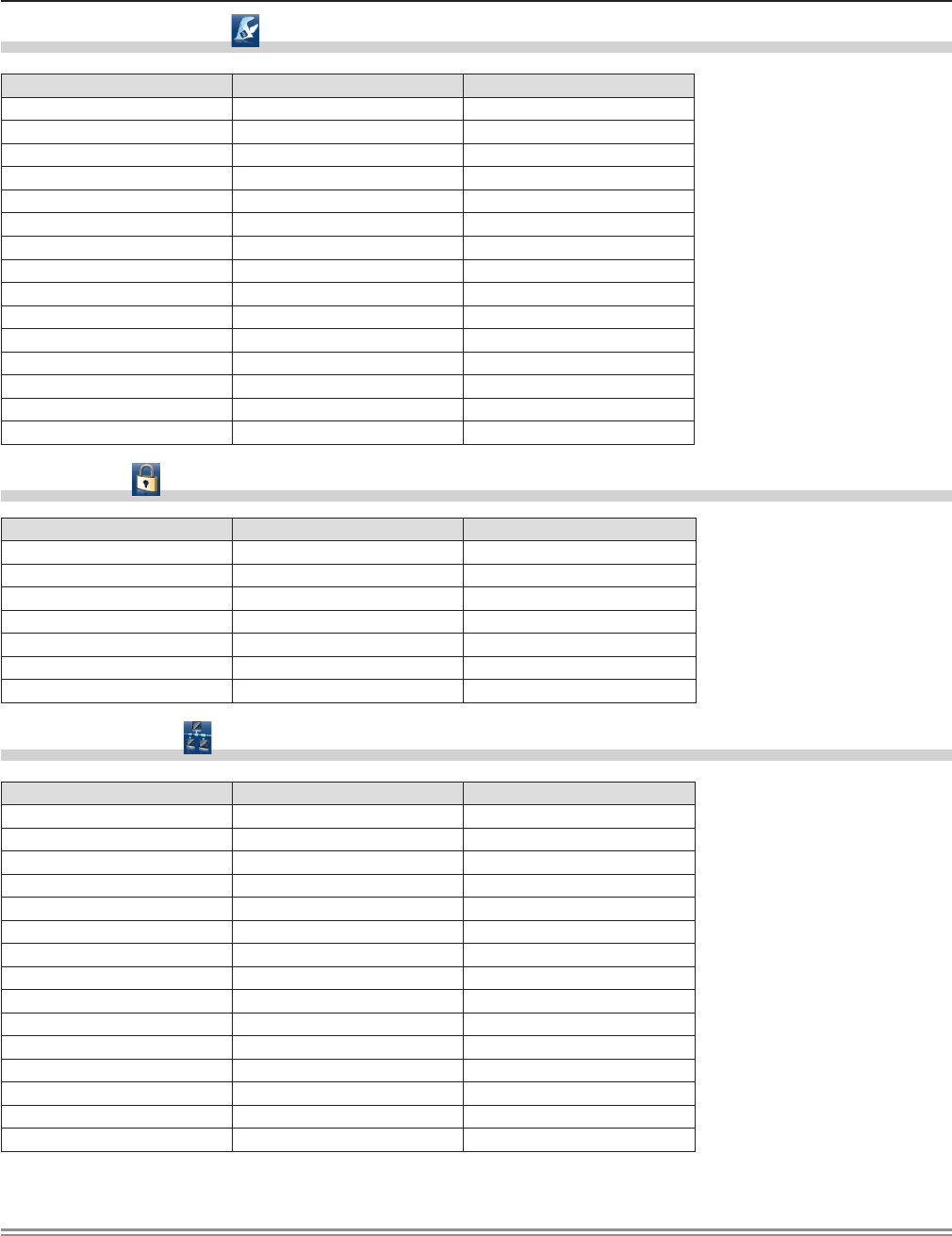
[PROJECTOR SETUP]
Sub-menu item Factory default Page
[STATUS] - 77
[COMPUTER2 SELECT] [COMPUTER2 IN] 77
[PROJECTOR ID] [ALL] 78
[INITIAL START UP] [LAST MEMORY] 78
[PROJECTION METHOD] [FRONT/DESK] 78
[HIGH ALTITUDE MODE] [OFF] 78
[LAMP POWER] [NORMAL] 79
[ECO MANAGEMENT] - 79
[EMULATE] [DEFAULT] 80
[FUNCTION BUTTON] - 81
[AUDIO SETTING] - 81
[EASY SETTING] - 83
[TEST PATTERN] - 83
[FILTER COUNTER] - 83
[INITIALIZE ALL] - 84
[SECURITY]
Sub-menu item Factory Default Page
[PASSWORD] [OFF] 85
[PASSWORD CHANGE] - 85
[TEXT DISPLAY] [OFF] 86
[TEXT CHANGE] - 86
[MENU LOCK] [OFF] 86
[MENU LOCK PASSWORD] - 86
[CONTROL DEVICE SETUP] - 87
[NETWORK/USB]
Sub-menu item Factory default Page
[WIRED LAN] - 88
[WIRELESS LAN] [SIMPLE] 89
[CONNECTION LOCK] [OFF] 92
[NAME CHANGE] - 92
[PASSWORD] [OFF] 92
[PASSWORD CHANGE] - 93
[NETWORK CONTROL] [ON] 93
[AMX D.D.] [OFF] 93
[Crestron Connected(TM)] [OFF] 93
[LIVE MODE CUT IN] [OFF] 93
[MULTI-LIVE]*1- 94
[MEMORY VIEWER] - 94
[MIRRORING] - 95
[STATUS] - 95
[INITIALIZE] - 96
*1 Only for [Panasonic APPLICATION] signals input.
Note
fSome items may not be adjusted or used for certain signal formats to be input to the projector.
The menu items that cannot be adjusted or used are shown in gray characters, and they cannot be selected.
fSub-menu items and factory default settings differ depending on the selected input terminal.
ENGLISH - 59
Chapter 4 Settings - Menu Navigation
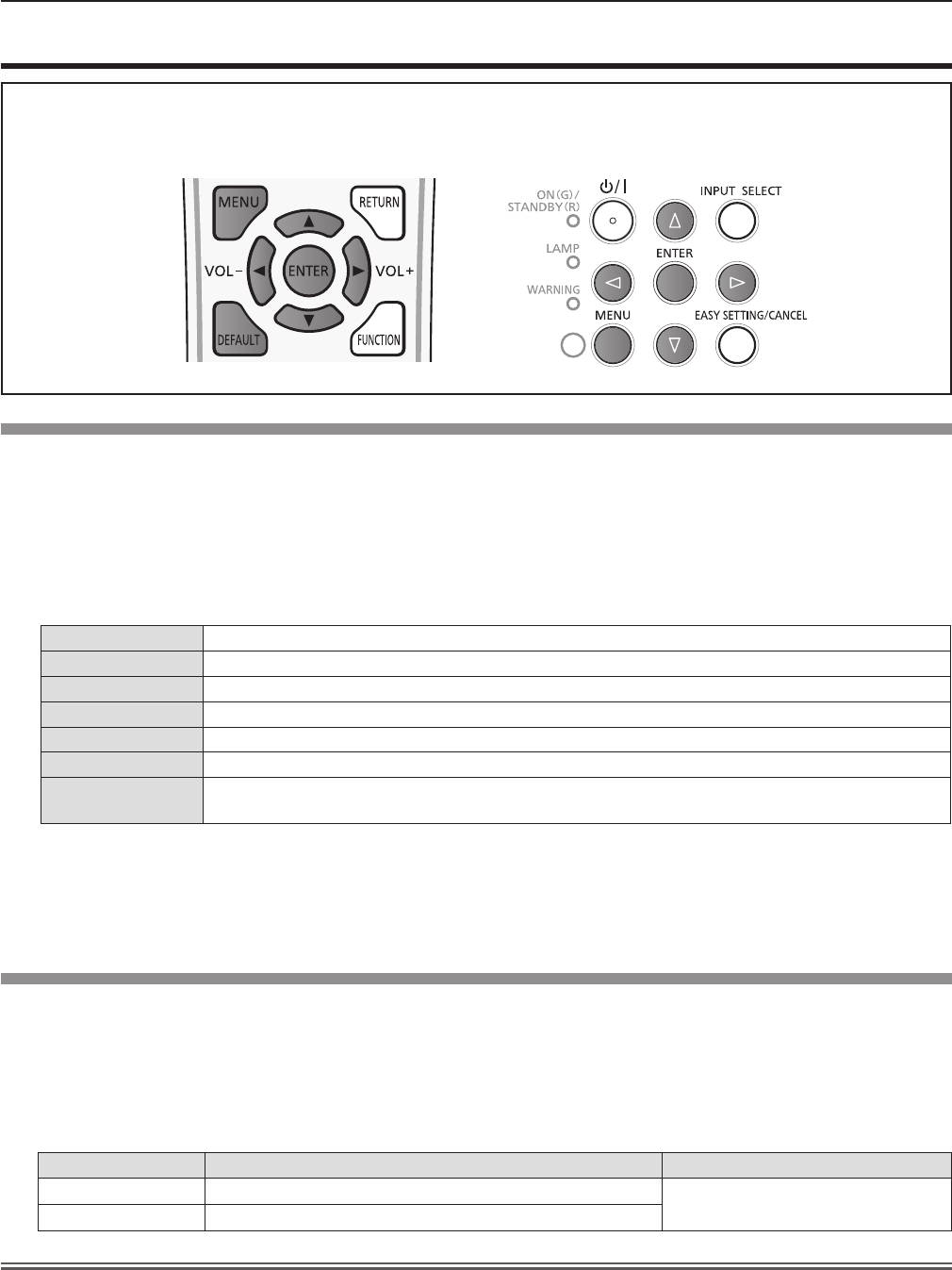
[PICTURE] menu
On the menu screen, select [PICTURE] from the main menu, and select an item from the sub-menu.
Refer to "Navigating through the menu" (x page 56) for the operation of the menu screen.
fAfter selecting the item, press asqw to set.
[PICTURE MODE]
You can switch to the desired picture mode suitable for the image source and the environment in which the projector is used.
1) Press as to select [PICTURE MODE].
2) Press qw or the <ENTER> button.
fThe [PICTURE MODE] individual adjustment screen is displayed.
3) Press qw to switch the item.
fThe items will switch each time you press the button.
[STANDARD] The picture becomes suitable for moving images in general.
[DYNAMIC] The light output is maximized for use in bright areas.
[BLACKBOARD] The picture becomes suitable for projecting on a black board.
[WHITE BOARD] The picture becomes suitable for projecting on a white board.
[CINEMA]*1The picture becomes suitable for movie sources.
[NATURAL]*2The picture becomes suitable for use in low-light areas.
[EASY SETTING]*3When executing the EASY SETTING function, it will be the optimal hue for the projected image
according to the projection environment.*4
*1 Only for the movie-based signals.
*2 Only for the still image signals.
*3 When the projector leaves the factory, [EASY SETTING] does not appear. When execute the EASY SETTING function
by setting [COLORBOARD] to [ON] in [EASY SETTING], [EASY SETTING] is added to the items.
*4 If you use the projector in different environment, the screen may change. Please execute the EASY SETTING function
again by setting [COLORBOARD] to [ON] in [EASY SETTING].
[CONTRAST]
You can adjust the contrast of the colors.
1) Press as to select [CONTRAST].
2) Press qw or the <ENTER> button.
fThe [CONTRAST] individual adjustment screen is displayed.
3) Press qw to adjust the level.
Operation Adjustment Adjustment range
Press the w button. Brightens the screen and makes the color of image deeper. -32 ~ +32
Press the q button. Darkens the screen and makes the color of image lighter.
Attention
fAdjust [BRIGHTNESS] rst when you need to adjust [BRIGHTNESS] and [CONTRAST].
60 - ENGLISH
Chapter 4 Settings - [PICTURE] menu
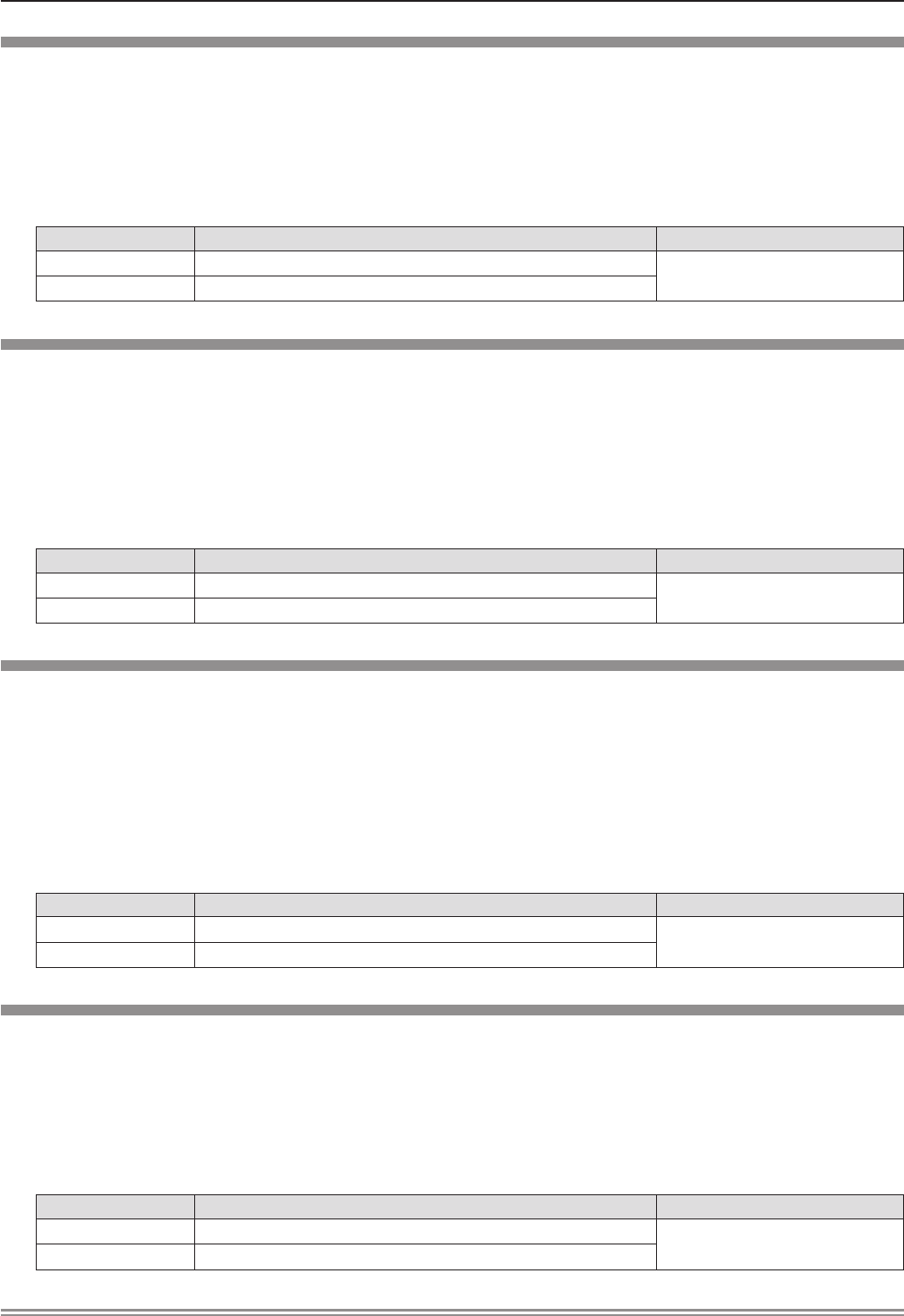
[BRIGHTNESS]
You can adjust the dark (black) part of the projected image.
1) Press as to select [BRIGHTNESS].
2) Press qw or the <ENTER> button.
fThe [BRIGHTNESS] individual adjustment screen is displayed.
3) Press qw to adjust the level.
Operation Adjustment Adjustment range
Press the w button. Increases the brightness of the dark (black) parts of the screen. -32 ~ +32
Press the q button. Reduces the brightness of the dark (black) parts of the screen.
[COLOR]
(Only for movie-based signal input)
You can adjust the color saturation of the projected image.
1) Press as to select [COLOR].
2) Press qw or the <ENTER> button.
fThe [COLOR] individual adjustment screen is displayed.
3) Press qw to adjust the level.
Operation Adjustment Adjustment range
Press the w button. Deepens colors. -32 ~ +32
Press the q button. Weakens colors.
[TINT]
(Only for NTSC/NTSC4.43 signal, when inputting movie-based signal to the <S-VIDEO IN> terminal or the <VIDEO IN>
terminal.)
You can adjust the skin tone in the projected image.
1) Press as to select [TINT].
2) Press qw or the <ENTER> button.
fThe [TINT] individual adjustment screen is displayed.
3) Press qw to adjust the level.
Operation Adjustment Adjustment range
Press the w button. Adjusts skin tone toward greenish color. -32 ~ +32
Press the q button. Adjusts skin tone toward reddish purple.
[SHARPNESS]
You can adjust the sharpness of the projected image.
1) Press as to select [SHARPNESS].
2) Press qw or the <ENTER> button.
fThe [SHARPNESS] individual adjustment screen is displayed.
3) Press qw to adjust the level.
Operation Adjustment Adjustment range
Press the w button. Contours become sharper. 0 ~ +15
Press the q button. Contours become softer.
Note
f[SHARPNESS] will be invalid when [DAYLIGHT VIEW] is set to [AUTO] or [ON].
ENGLISH - 61
Chapter 4 Settings - [PICTURE] menu
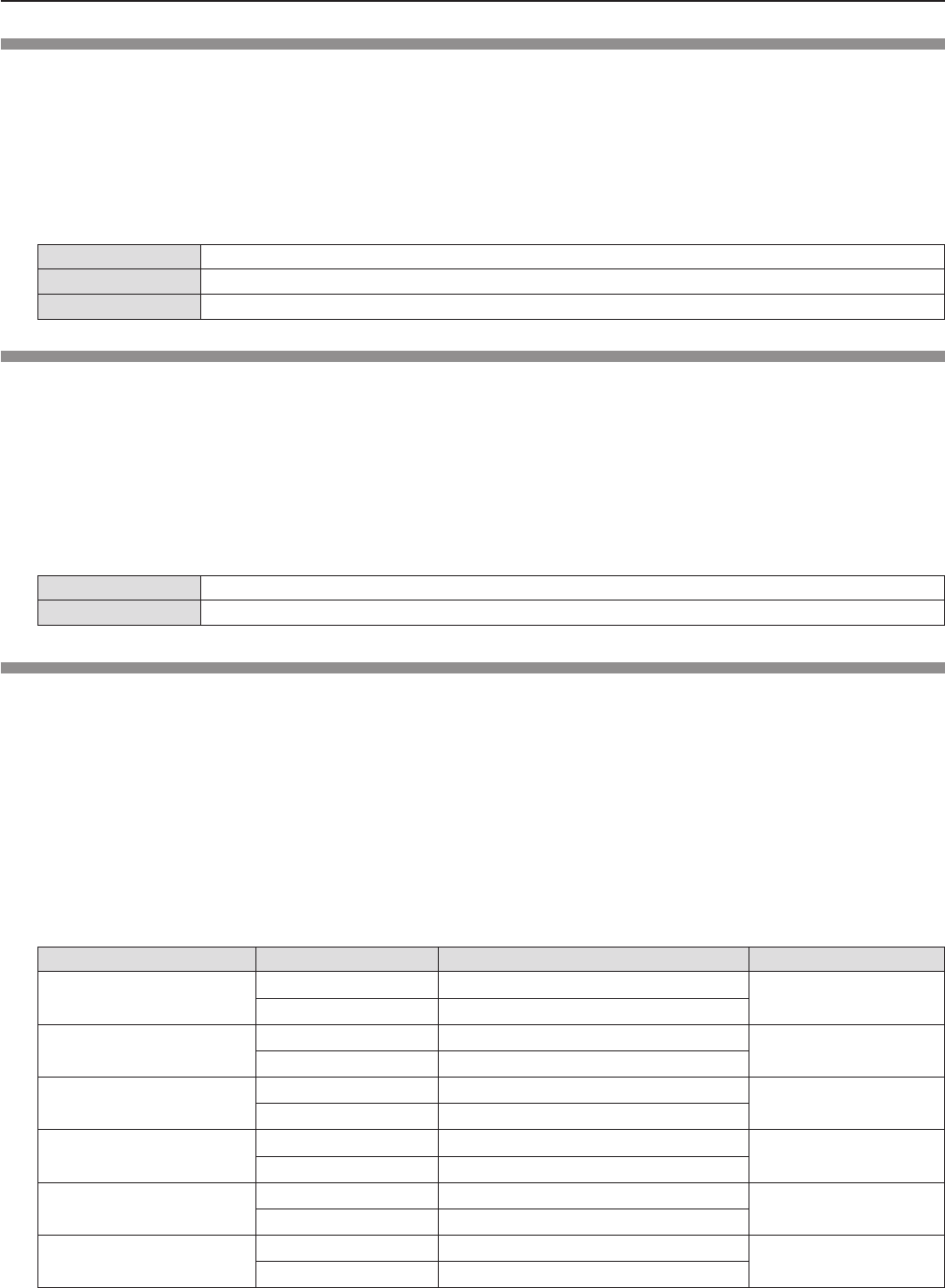
[COLOR TEMPERATURE]
You can switch the color temperature if the white areas of the projected image are bluish or reddish.
1) Press as to select [COLOR TEMPERATURE].
2) Press qw or the <ENTER> button.
fThe [COLOR TEMPERATURE] individual adjustment screen is displayed.
3) Press qw to switch the item.
fThe items will switch each time you press the button.
[DEFAULT] Factory default setting.
[HIGH] Becomes a bluish image. Select this when the white areas of the projected image are reddish.
[LOW] Becomes a reddish image. Select this when the white areas of the projected image are bluish.
[IRIS]
Aperture correction and signal compensation are performed automatically based on the image to result in an image of optimum
contrast.
1) Press as to select [IRIS].
2) Press qw or the <ENTER> button.
fThe [IRIS] individual adjustment screen is displayed.
3) Press qw to switch the item.
fThe items will switch each time you press the button.
[OFF] No correction.
[ON] Corrects the aperture.
[ADVANCED MENU]
You can perform more advanced image adjustment.
1) Press as to select [ADVANCED MENU].
2) Press the <ENTER> button.
fThe [ADVANCED MENU] screen is displayed.
3) Press as to select one item among [CONTRAST R] ~ [BRIGHTNESS B].
4) Press qw or the <ENTER> button.
fThe individual adjustment screen of items are displayed.
5) Press qw to adjust the value.
Items Operation Adjustment Adjustment range
[CONTRAST R] Press the w button. Emphasizes red in highlight areas. -32 ~ +32
Press the q button. Deemphasizes red in highlight areas.
[CONTRAST G] Press the w button. Emphasizes green in highlight areas. -32 ~ +32
Press the q button. Deemphasizes green in highlight areas.
[CONTRAST B] Press the w button. Emphasizes blue in highlight areas. -32 ~ +32
Press the q button. Deemphasizes blue in highlight areas.
[BRIGHTNESS R] Press the w button. Emphasizes red in shadow areas. -32 ~ +32
Press the q button. Deemphasizes red in shadow areas.
[BRIGHTNESS G] Press the w button. Emphasizes green in shadow areas. -32 ~ +32
Press the q button. Deemphasizes green in shadow areas.
[BRIGHTNESS B] Press the w button. Emphasizes blue in shadow areas. -32 ~ +32
Press the q button. Deemphasizes blue in shadow areas.
62 - ENGLISH
Chapter 4 Settings - [PICTURE] menu
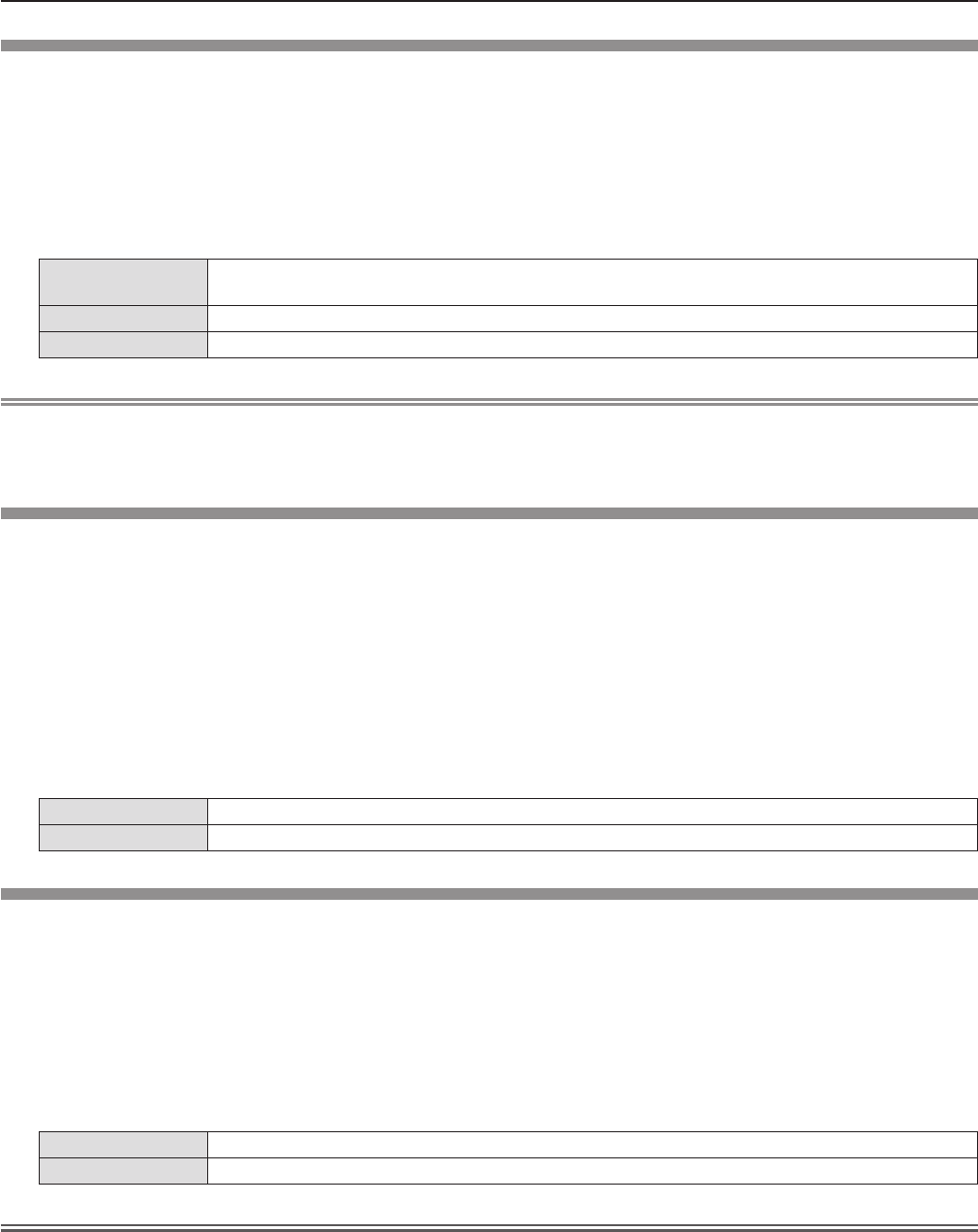
[DAYLIGHT VIEW]
You can correct the image to the optimal vividness even if it is projected under a bright light.
1) Press as to select [DAYLIGHT VIEW].
2) Press qw or the <ENTER> button.
fThe [DAYLIGHT VIEW] individual adjustment screen is displayed.
3) Press qw to switch the item.
fThe items will switch each time you press the button.
[AUTO] Enables auto correction of [DAYLIGHT VIEW]. The brightness of the room is detected by the
luminance sensor, and the vividness of the image is automatically corrected.
[ON] Enables [DAYLIGHT VIEW].
[OFF] Disables [DAYLIGHT VIEW].
Note
f[DAYLIGHT VIEW] cannot be set to [AUTO] when the [PROJECTOR SETUP] menu → [PROJECTION METHOD] is set to
[REAR/DESK] or [REAR/CEILING].
fThe [AUTO] mode may not function properly if an object is placed on the top of the projector.
[DIGITAL CINEMA REALITY]
(Only for movie-based signal input)
You can improve the vertical resolution of 2-2 and 2-3 pull down video.
This function is available only with the following signal inputs.
525i (480i), 625i (576i), 1125 (1080)/60i, 1125 (1080)/50i, S-VIDEO signal, VIDEO signal.
1) Press as to select [DIGITAL CINEMA REALITY].
2) Press qw or the <ENTER> button.
fThe [DIGITAL CINEMA REALITY] individual adjustment screen is displayed.
3) Press qw to switch the item.
fThe items will switch each time you press the button.
[OFF] Disables [DIGITAL CINEMA REALITY].
[ON] Enables [DIGITAL CINEMA REALITY].
[NOISE REDUCTION]
(Only when the <S-VIDEO IN >/<VIDEO IN> terminal is selected)
You can reduce noises when the input image is degraded and noise is occurring in the image signal.
1) Press as to select [NOISE REDUCTION].
2) Press qw or the <ENTER> button.
fThe [NOISE REDUCTION] individual adjustment screen is displayed.
3) Press qw to switch the item.
fThe items will switch each time you press the button.
[OFF] Disables [NOISE REDUCTION].
[ON] Enables [NOISE REDUCTION].
Attention
fWhen this is set for an input signal with less noise, the image may look different from what it originally was. In such a case,
set it to [OFF].
ENGLISH - 63
Chapter 4 Settings - [PICTURE] menu
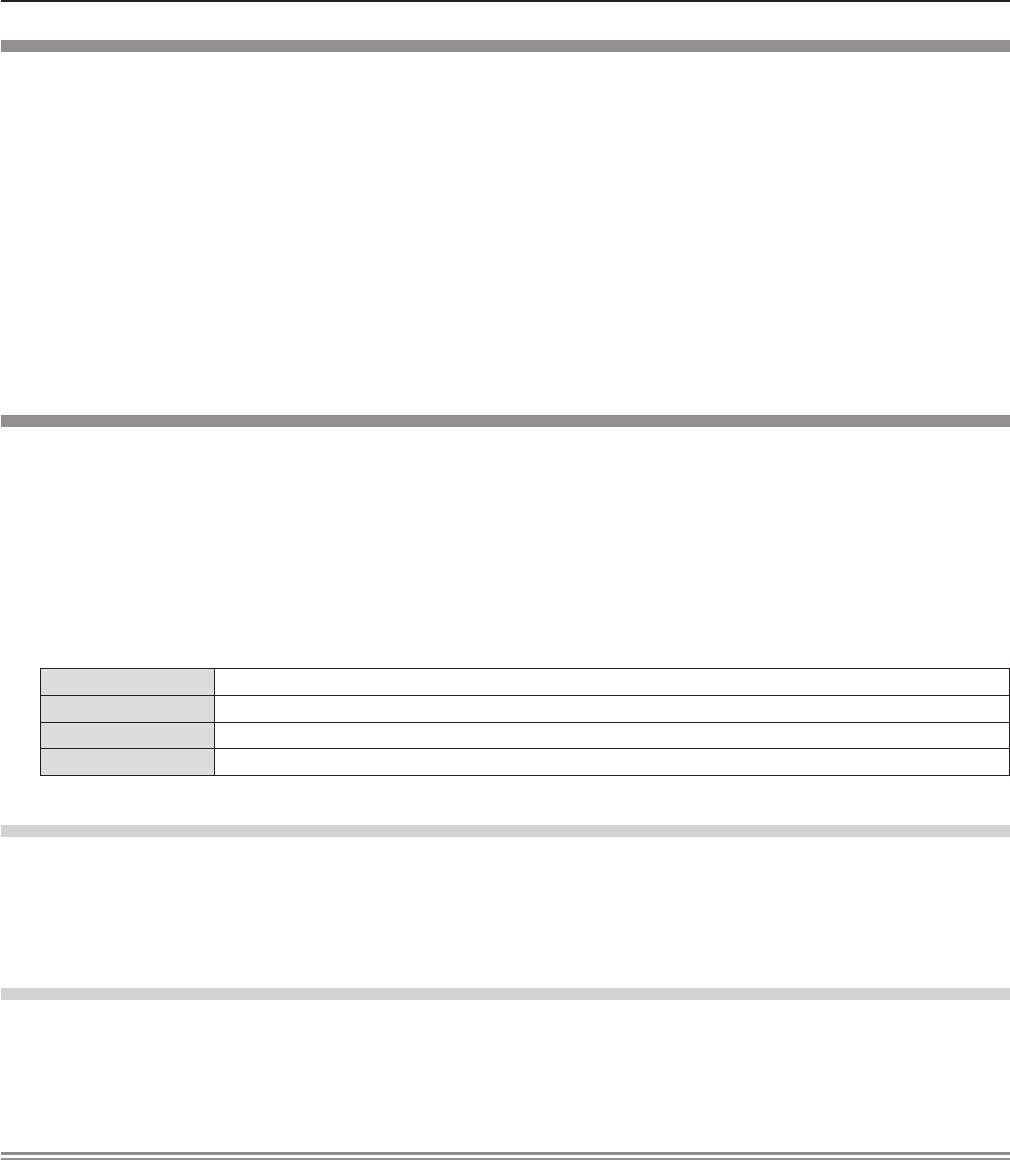
[TV-SYSTEM]
(Only when the <S-VIDEO IN >/<VIDEO IN> terminal is selected)
The projector will automatically detect the input signal, but you can set the color system manually when an unstable signal is
input. Set the color system matching the input signal.
1) Press as to select [TV-SYSTEM].
2) Press qw or the <ENTER> button.
fThe [TV-SYSTEM] individual adjustment screen is displayed.
3) Press qw to select the color system.
fThe items will switch each time you press the button.
fSelect among [AUTO], [NTSC], [NTSC4.43], [PAL], [PAL-M], [PAL-N], [PAL60] and [SECAM].
fSet it to [AUTO] normally. (Setting [AUTO] will automatically select [NTSC], [NTSC4.43], [PAL], [PAL-M], [PAL-N],
[SECAM] or [PAL60].)
[RGB/YPBPR] / [RGB/YCBCR]
Set it to [AUTO] normally. If images are not displayed correctly when this is set to [AUTO], set either [RGB], [YCBCR] or [YPBPR]
in accordance with the input signal.
1) Press as to select [RGB/YPBPR] or [RGB/YCBCR].
2) Press qw or the <ENTER> button.
fThe [RGB/YPBPR] or [RGB/YCBCR] individual adjustment screen is displayed.
3) Press qw to switch the item.
fThe items will switch each time you press the button.
[AUTO] The sync signal automatically selects the signal [RGB] / [YPBPR] / [YCBCR].
[RGB] Select it for RGB signal input.
[YPBPR]Select it for YPBPR signal input.
[YCBCR]Select it for YCBCR signal input.
When the <COMPUTER 1 IN> terminal is selected
fFor 525i (480i), 625i (576i), 525p (480p) and 625p (576p) input
Select [AUTO], [RGB] or [YCBCR].
fFor other movie-based signal input
Select [AUTO], [RGB] or [YPBPR].
When the <HDMI IN > terminal is selected
fFor 525p (480p) and 625p (576p) input
Select [AUTO], [RGB] or [YCBCR].
fFor other movie-based signal input
Select [AUTO], [RGB] or [YPBPR].
Note
fRefer to “List of compatible signals” (x page 141) for the signal details.
fThe signal selection may not function properly depending on connected devices.
64 - ENGLISH
Chapter 4 Settings - [PICTURE] menu
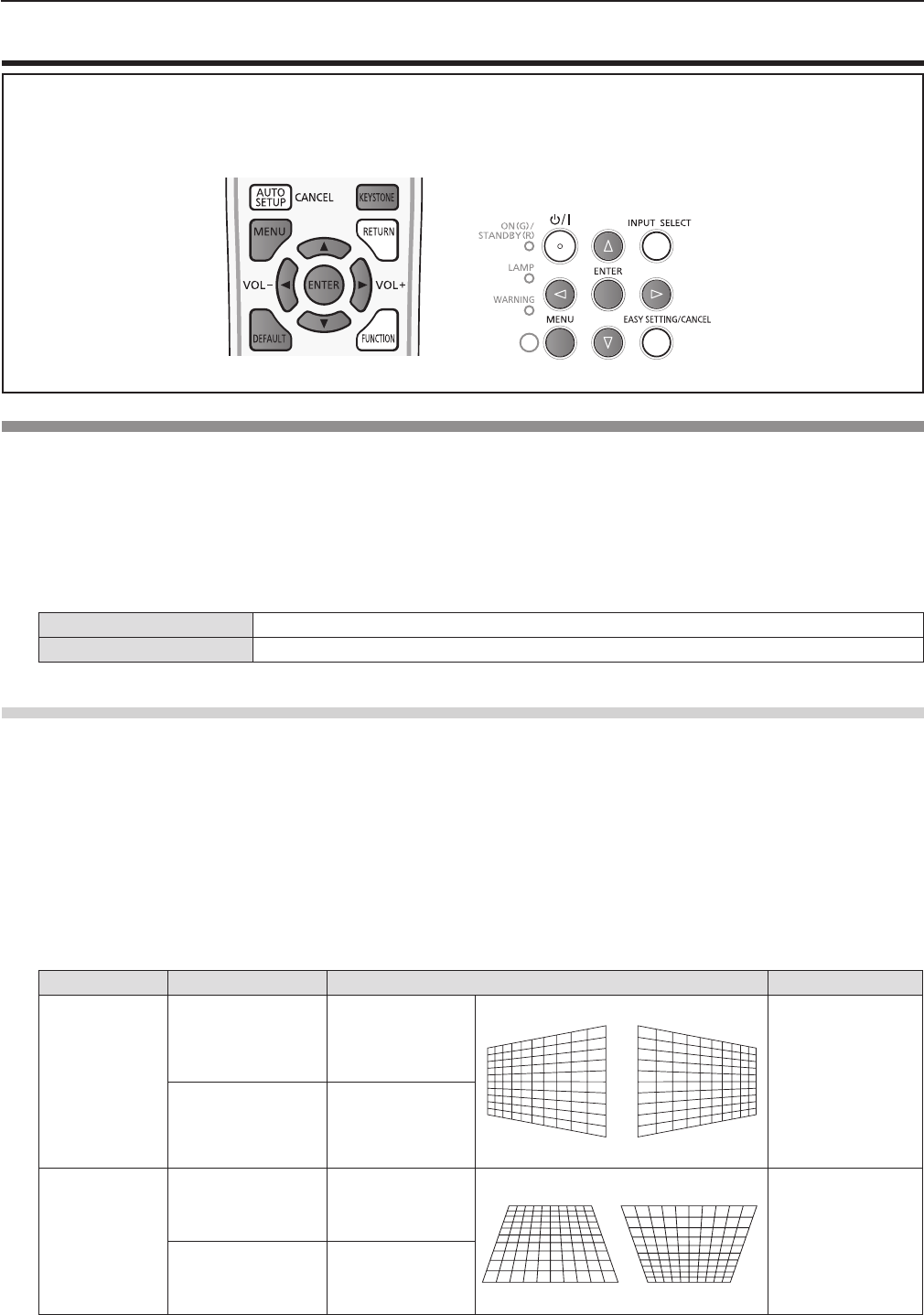
[POSITION] menu
On the menu screen, select [POSITION] from the main menu, and select an item from the sub-menu.
Refer to "Navigating through the menu" (x page 56) for the operation of the menu screen.
fAfter selecting the item, press asqw to set.
[KEYSTONE]
You can correct the trapezoidal distortion that occurs when the projector is installed tilted or when the screen is tilted.
1) Press as to select [KEYSTONE].
2) Press the <ENTER> button.
fThe [KEYSTONE] screen is displayed.
3) Press as to select one item to adjust.
[KEYSTONE] Adjusts when the trapezoid of the projected image is distorted.
[CORNER CORRECTION] Adjusts when the four corners of the projected image are distorted.
[KEYSTONE]
1) Press as to select [KEYSTONE].
2) Press the <ENTER> button.
fThe [KEYSTONE] screen is displayed.
3) Press as to select [KEYSTONE].
4) Press the <ENTER> button.
fThe [KEYSTONE] individual adjustment screen is displayed.
5) Press asqw to adjust the item.
Items Operation Adjustment Adjustment range
[H]
Press the w button. Adjusts the right of
the keystone.
-60 ~ +60
Press the q button. Adjusts the left of
the keystone.
[V]
Press the a button. Adjusts the upper
of the keystone.
-80 ~ +80
Press the s button. Adjusts the bottom
of the keystone.
ENGLISH - 65
Chapter 4 Settings - [POSITION] menu
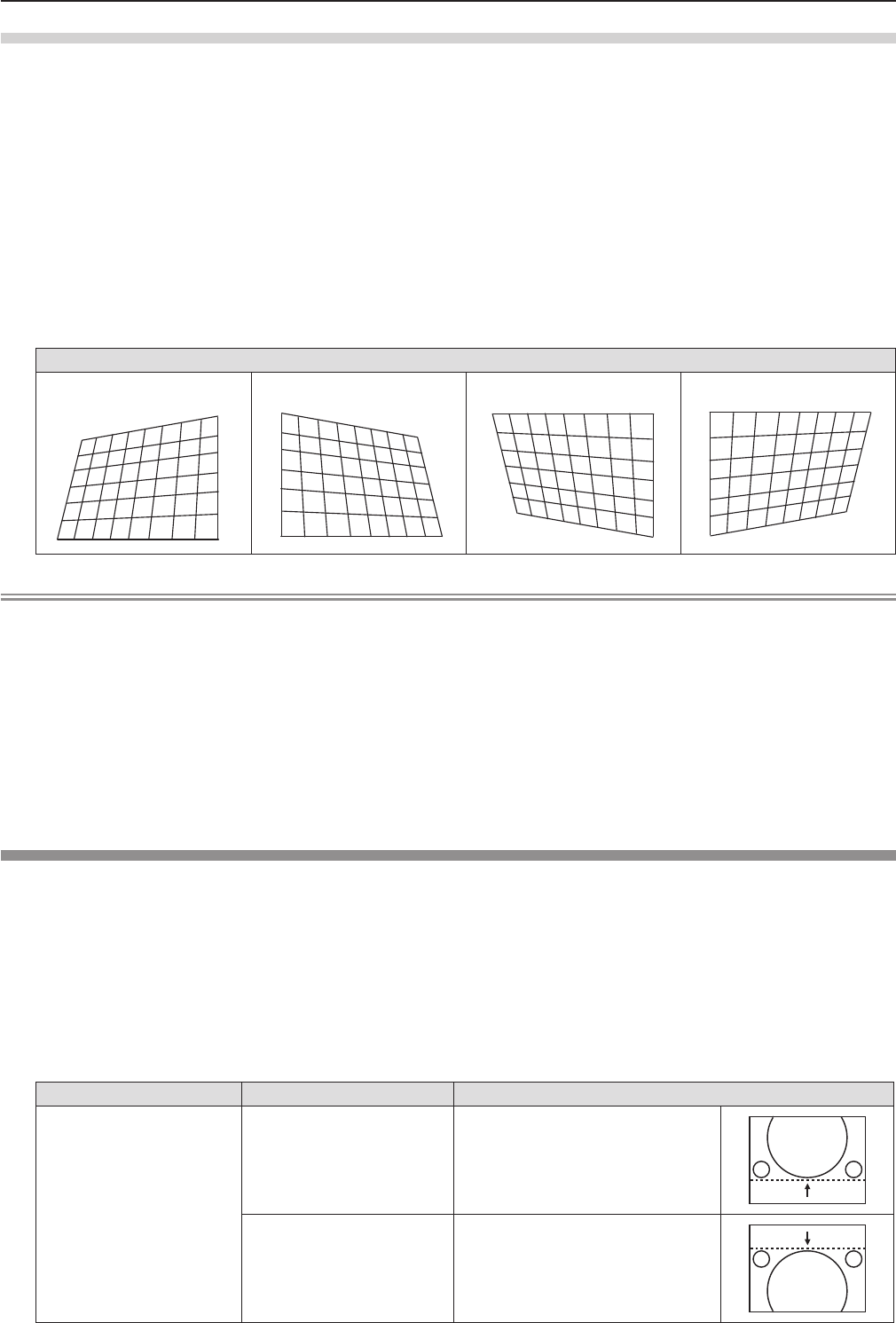
[CORNER CORRECTION]
1) Press as to select [KEYSTONE].
2) Press the <ENTER> button.
fThe [KEYSTONE] screen is displayed.
3) Press as to select [CORNER CORRECTION].
4) Press the <ENTER> button.
fThe [CORNER CORRECTION] screen is displayed.
5) Press as to select the item to adjust, then press the <ENTER> button.
fThe [CORNER CORRECTION] individual adjustment screen is displayed.
6) Press asqw to adjust.
[CORNER CORRECTION]
[UPPER LEFT] [UPPER RIGHT] [LOWER LEFT] [LOWER RIGHT]
Note
fEither [KEYSTONE] or [CORNER CORRECTION] setting value is valid. When [KEYSTONE] or [CORNER CORRECTION]
adjustment is nished, you adjust the other one, the adjusted value will be reset.
fPress the <KEYSTONE> button on the remote control when the [KEYSTONE] or [CORNER CORRECTION] screen is
displaying, it will switch to the other adjustment screen.
fWhen the [CORNER CORRECTION] individual adjustment screen is displaying, the individual adjustment screen of the next
corner can also be displayed by pressing the <ENTER> button.
fCorrecting up to ±40° for the tilt in the vertical direction and ±30° for the tilt in the horizontal are available for adjustments
with [KEYSTONE]. However, the image quality will degrade and it will get harder to focus with more correction. Install the
projector so that the correction will be as small as possible.
fScreen size will also change when [KEYSTONE] is used to perform various adjustments.
fAspect ratio of the image size may shift depending on the correction.
[SHIFT]
(Only for computer signal input)
Move the image position vertically or horizontally if the image position projected on the screen is shifted even when the relative
position of the projector and the screen is installed correctly.
1) Press as to select [SHIFT].
2) Press the <ENTER> button.
fThe [SHIFT] screen is displayed.
3) Press asqw to adjust the position.
Orientation Operation Adjustment
Vertical (up and down)
adjustment.
Press the a button. The image position moves up.
Press the s button. The image position moves down.
66 - ENGLISH
Chapter 4 Settings - [POSITION] menu
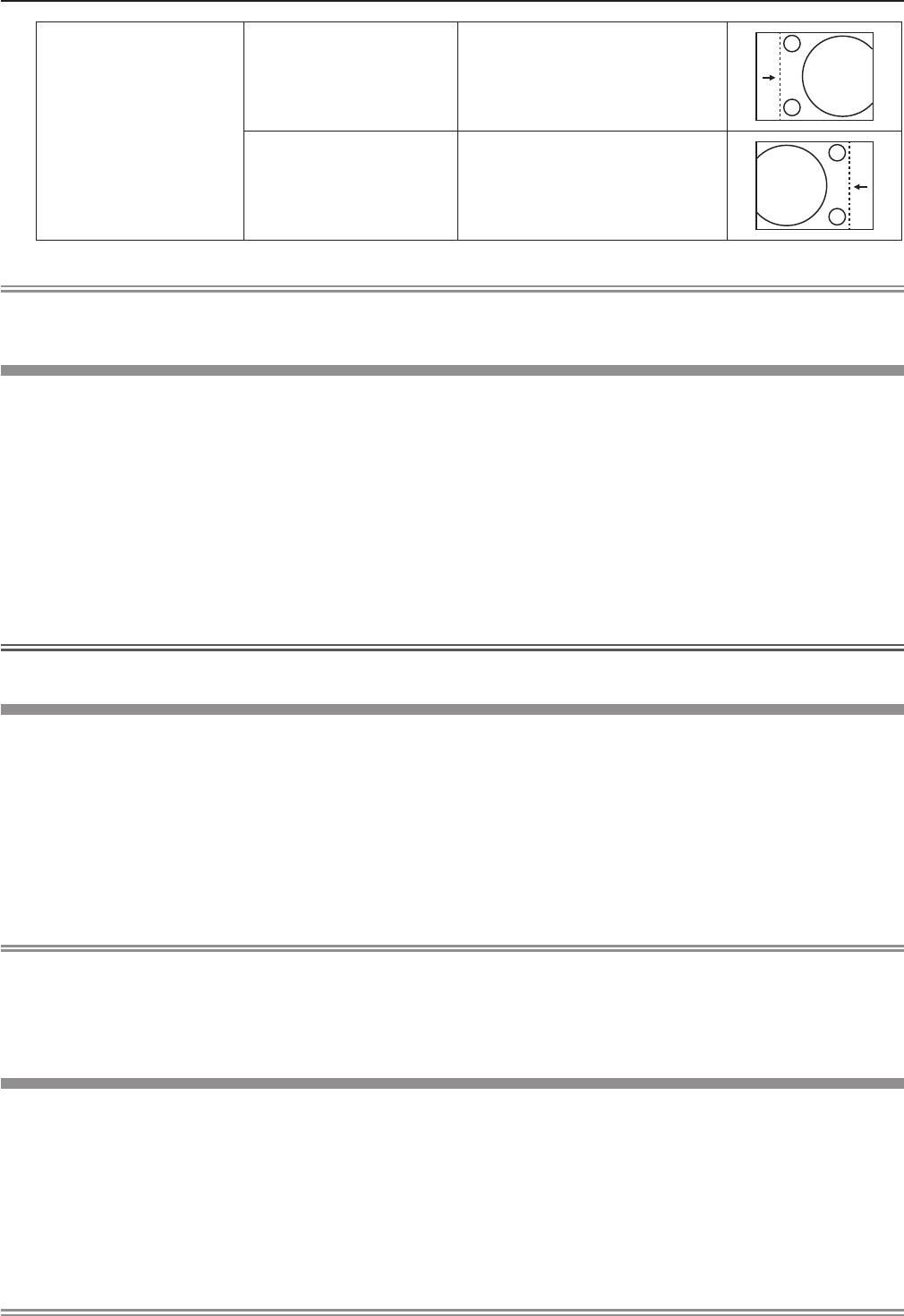
Horizontal (right and left)
adjustment.
Press the w button. The image position moves to the
right.
Press the q button. The image position moves to the
left.
Note
fDepending on the input signal, if the adjustment of [SHIFT] exceeds the effective adjustment range of the input signal, the
position of the image cannot be changed. Please adjust [SHIFT] within an effective adjustment range.
[DOT CLOCK]
(Only for computer (RGB) signals input)
Use this function to adjust and minimize the effect of interference caused by projection of patterns consisting of vertical stripes.
The projection of the striped pattern may cause cyclic patterns (noise). Adjust so that the amount of interference is at a
minimum. You can adjust the dot clock of image.
1) Press as to select [DOT CLOCK].
2) Press qw or the <ENTER> button.
fThe [DOT CLOCK] individual adjustment screen is displayed.
3) Press qw to adjust the value.
fThe adjustment values are [-32] to [+32].
Attention
fSet it before adjusting [CLOCK PHASE].
[CLOCK PHASE]
(Only for computer (RGB) signals input)
You can adjust to achieve an optimal image when there is a ickering image or smeared outlines.
1) Press as to select [CLOCK PHASE].
2) Press qw or the <ENTER> button.
fThe [CLOCK PHASE] individual adjustment screen is displayed.
3) Press qw to adjust the value.
fThe adjustment values are [-16] to [+16]. Adjust so that the amount of interference is at a minimum.
Note
fCertain signals may not be adjustable.
fOptimal value may not be achieved if the output from the input computer is unstable.
fTo project a signal with dot clock frequency with 162 MHz or higher, noise may not disappear even if [CLOCK PHASE] is
adjusted.
f[CLOCK PHASE] cannot be adjusted when a digital signal is input.
[OVER SCAN]
Use this function when characters or pictures are cropped near the periphery of the projected image.
1) Press as to select [OVER SCAN].
2) Press qw or the <ENTER> button.
fThe [OVER SCAN] individual adjustment screen is displayed.
3) Press qw to adjust the level.
fThe adjustment values are [0] to [+3].
Note
fIt is unavailable for still image computer (RGB) signals, still image HDMI signals and [NETWORK/USB].
ENGLISH - 67
Chapter 4 Settings - [POSITION] menu
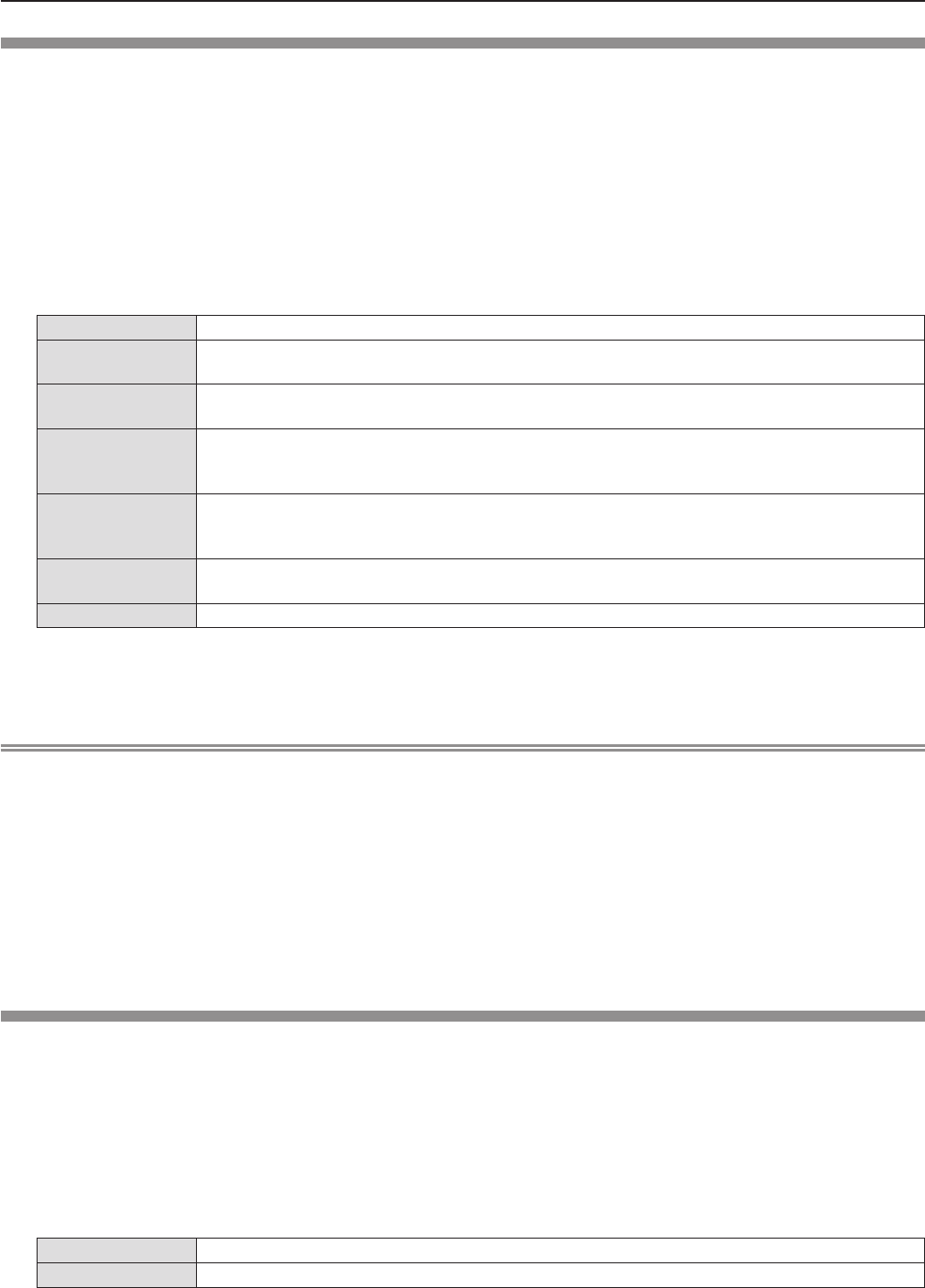
[ASPECT]
You can switch the aspect ratio of the image.
The aspect ratio is switched within the screen range selected in [SCREEN SETTING]. Set [SCREEN SETTING] rst.
(x page 72)
[SCREEN SETTING] is only for PT-VW355N.
1) Press as to select [ASPECT].
2) Press qw or the <ENTER> button.
fThe [ASPECT] individual adjustment screen is displayed.
3) Press qw to switch the item.
fThe items will switch each time you press the button.
[NORMAL] Displays images without changing the aspect ratio of the input signals.
[AUTO]*1The aspect ratio is automatically switched to the optimum aspect ratio when an aspect ratio
identier is included in the input signal.
[WIDE] Displays images with the aspect ratio converted to 16:9 when standard signals*2 are input.
Display images without changing the aspect ratio when wide-screen signals*3 are input.
[H FIT]
Displays images using the entire width of the screen. When signals have the aspect ratio vertically
longer than the aspect ratio of the screen selected in [SCREEN FORMAT]*4, the images are
displayed with the top and bottom parts cut off.
[V FIT]
Displays the height of the panel pixels vertically without changing the aspect ratio when wide-
screen signals are input. When signals have the aspect ratio horizontally longer than the aspect
ratio of the screen, the images are displayed with the right and left parts cut off.
[FULL] The image is projected using all the panel (screen) pixels. The input signals are converted to the
aspect ratio of the panel (screen).
[NATIVE] Displays images without changing the resolution of the input signals.
*1 Only for Video (NTSC) and 480i (YCBCR) signals input
*2 Standard signals are input signals with an aspect ratio of 4:3 or 5:4.
*3 Wide-screen signals are input signals with an aspect ratio of 16:10, 16:9 or 15:9.
*4 [SCREEN FORMAT] is only for PT-VW355N.
Note
fThe image size may be switched abnormally when [AUTO] is selected, please set to [NORMAL] or [WIDE] according to the
input signal.
fSome size modes are not available for certain types of input signals.
fIf an aspect ratio which is different from the aspect ratio for the input signals is selected, the images will appear differently
from the originals. Be careful of this when selecting the aspect ratio.
fIf using the projector in places such as cafes or hotels to display programs for a commercial purpose or for public
presentation, note that adjusting the aspect ratio or using the zoom function to change the screen images may be an
infringement of the rights of the original copyright owner for that program under copyright protection laws. Take care when
using a function of the projector such as the aspect ratio adjustment and zoom function.
fIf conventional (normal) 4:3 images which are not wide-screen images are displayed on a wide screen, the edges of the
images may not be visible or they may become distorted. Such images should be viewed as with an aspect ratio of 4:3 in the
original format intended by the creator of the images.
[FRAME LOCK]
(Only for still image signals input)
This setting is available for specic computer signals. Set when the movie is distorted.
1) Press as to select [FRAME LOCK].
2) Press qw or the <ENTER> button.
fThe [FRAME LOCK] individual adjustment screen is displayed.
3) Press qw to switch the [FRAME LOCK].
fThe items will switch each time you press the button.
[OFF] Disables the frame lock.
[ON] Enables the frame lock.
68 - ENGLISH
Chapter 4 Settings - [POSITION] menu
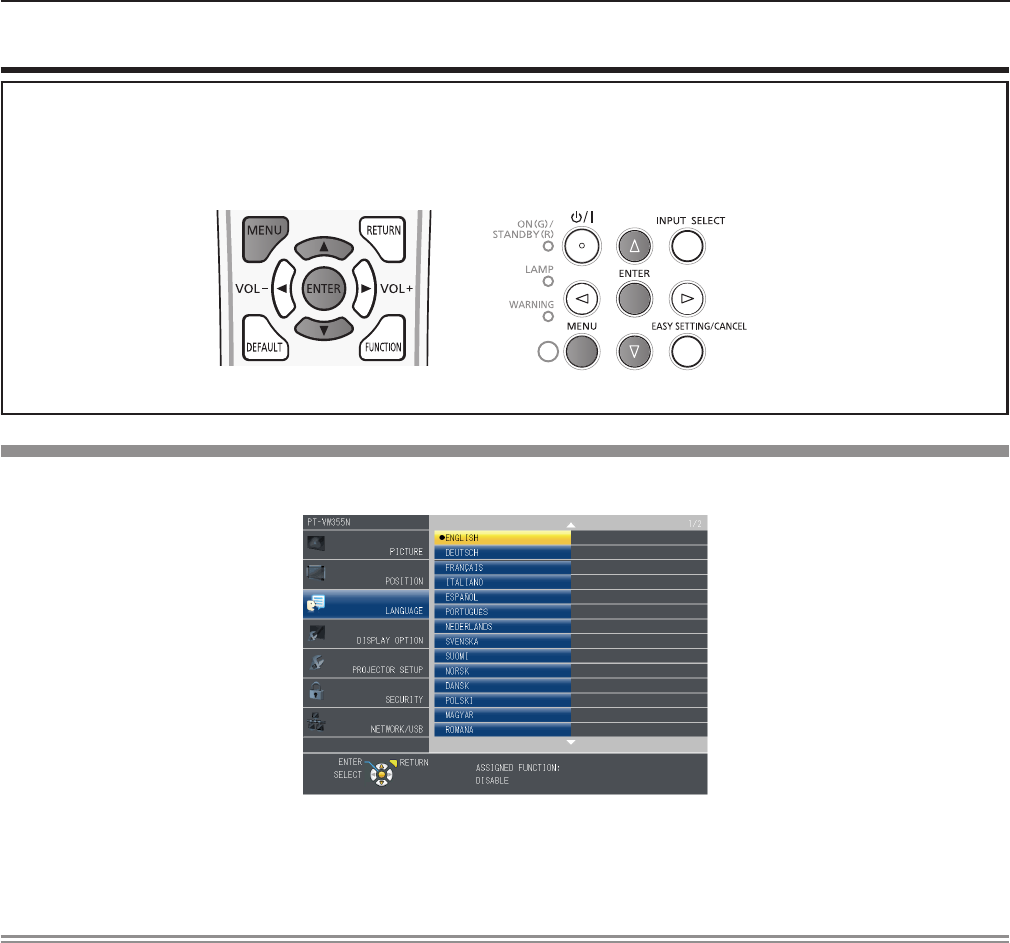
[LANGUAGE] menu
On the menu screen, select [LANGUAGE] from the main menu, and select an item from the sub-menu.
Refer to "Navigating through the menu" (x page 56) for the operation of the menu screen.
fPress as to select a language, and press <ENTER> button to set.
[LANGUAGE]
You can select the language of the on-screen display.
fVarious menus, settings, adjustment screens, control button names, etc., are displayed in the selected language.
fThe language can be changed to English, German, French, Italian, Spanish, Portuguese, Dutch, Swedish, Finnish,
Norwegian, Danish, Polish, Hungarian, Romanian, Czech, Russian, Turkish, Arabic, Kazakh, Vietnamese, Chinese, Korean,
Japanese and Thai.
Note
fThe on-screen display language of the projector is set to English by default and when [INITIALIZE ALL] (x page 84) in
[PROJECTOR SETUP] is executed.
ENGLISH - 69
Chapter 4 Settings - [LANGUAGE] menu
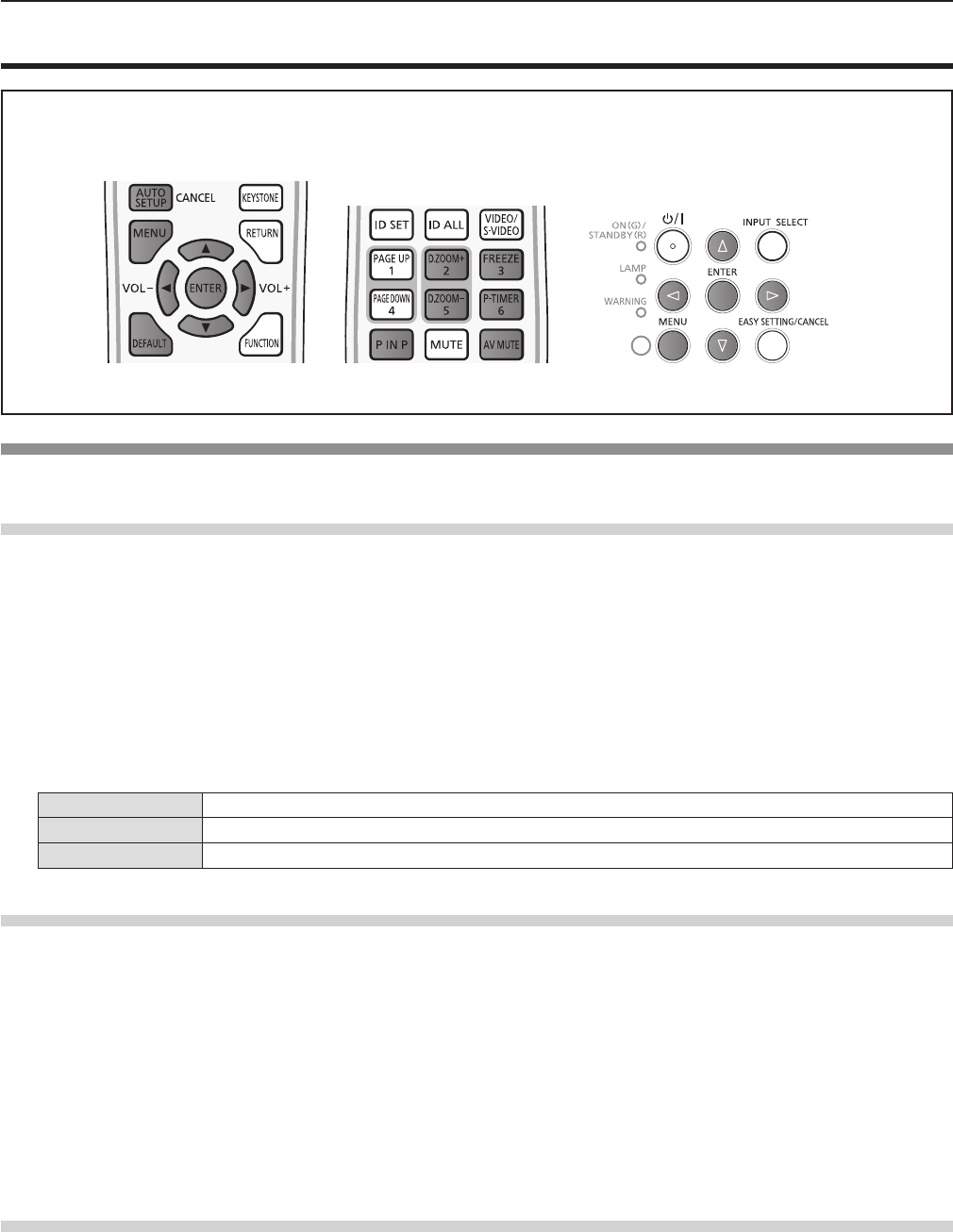
[DISPLAY OPTION] menu
On the menu screen, select [DISPLAY OPTION] from the main menu, and select an item from the sub-menu.
Refer to "Navigating through the menu" (x page 56) for the operation of the menu screen.
fAfter selecting the item, press asqw to set.
[ON-SCREEN DISPLAY]
Set the on-screen display and position.
[INPUT GUIDE]
Set whether to display the input guide when switching the input source.
1) Press as to select [ON-SCREEN DISPLAY].
2) Press the <ENTER> button.
fThe [ON-SCREEN DISPLAY] screen is displayed.
3) Press as to select [INPUT GUIDE].
4) Press qw to switch the item.
fThe items will switch each time you press the button.
[DETAILED] Displays the name of input terminal and input signal graphically.
[OFF] Disables the input guide.
[SIMPLE] Displays the name of input terminal and input signal.
[OSD POSITION]
Set the position of the menu screen (OSD).
1) Press as to select [ON-SCREEN DISPLAY].
2) Press the <ENTER> button.
fThe [ON-SCREEN DISPLAY] screen is displayed.
3) Press as to select [OSD POSITION].
4) Press qw to switch the item.
fThe items will switch each time you press the button as following:
[CENTER] → [UPPER LEFT] → [UPPER RIGHT] → [LOWER LEFT] → [LOWER RIGHT] → [CENTER] → ...
[WARNING MESSAGE]
Set the display/hide of the warning message.
1) Press as to select [ON-SCREEN DISPLAY].
2) Press the <ENTER> button.
fThe [ON-SCREEN DISPLAY] screen is displayed.
3) Press as to select [WARNING MESSAGE].
70 - ENGLISH
Chapter 4 Settings - [DISPLAY OPTION] menu
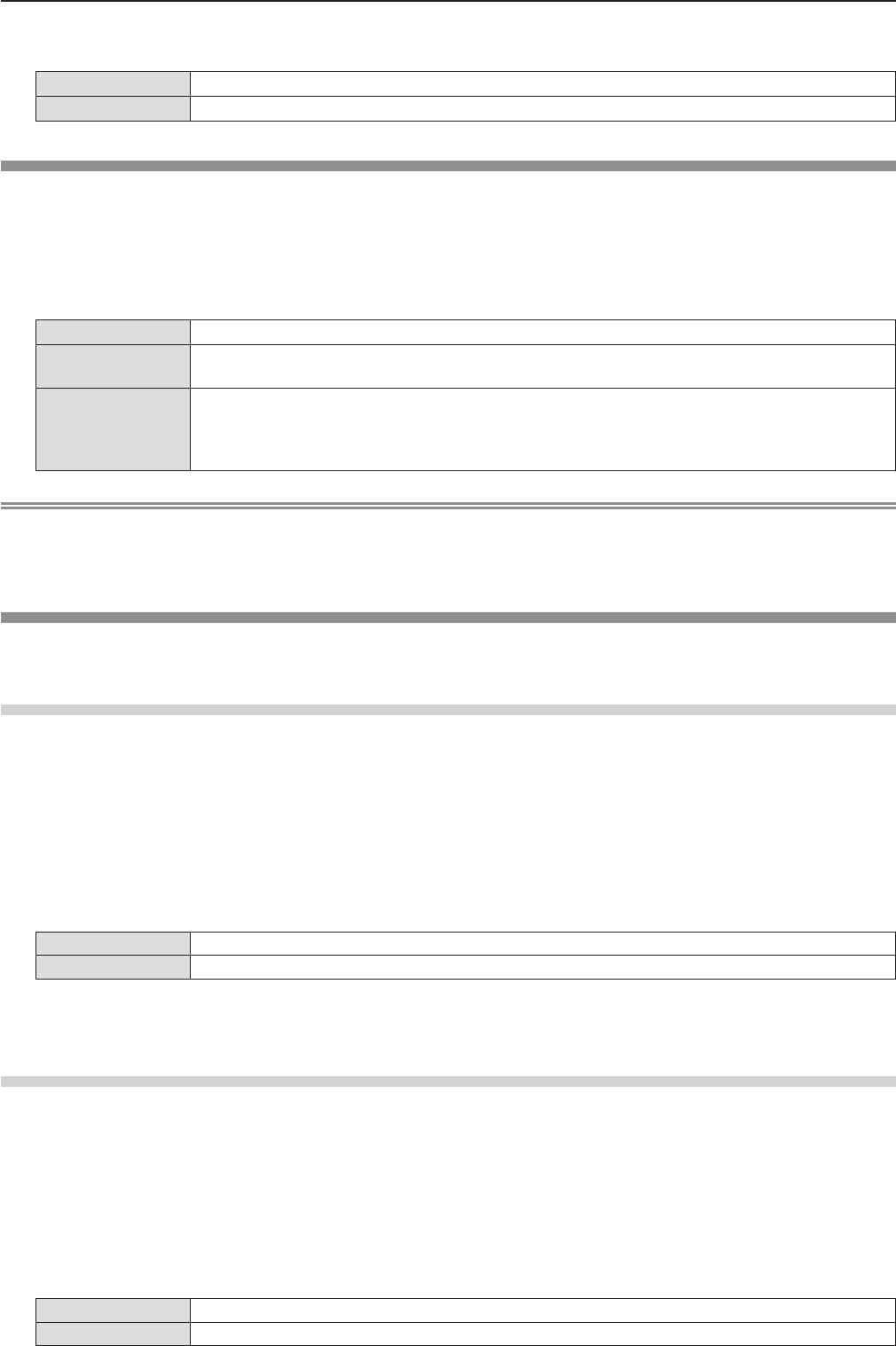
4) Press qw to switch the item.
fThe items will switch each time you press the button.
[OFF] Hides the warning message.
[ON] Displays the warning message.
[HDMI SIGNAL LEVEL]
Switch the setting when the external equipment is connected to the <HDMI IN> terminal of the projector and the image is not
projected correctly.
1) Press as to select [HDMI SIGNAL LEVEL].
2) Press qw to switch the item.
fThe items will switch each time you press the button.
[AUTO] Sets the signal level automatically.
[64-940] Select when the HDMI terminal of an external device (such as a blu-ray player) is connected to the
<HDMI IN> terminal.
[0-1023]
Select when the DVI terminal output of an external device (such as a computer) is connected to
the <HDMI IN> terminal via a conversion cable or similar cable.
Select also when the HDMI terminal output of a computer or other device is connected to the
<HDMI IN> terminal.
Note
fThe optimal setting varies depending on the output setting of the connected external device. Refer to the operation
instruction of the external device regarding the output of the external device.
fThe displayed signal level is assumed when the input is 30 bits.
[CLOSED CAPTION SETTING]
(Only for NTSC, 480i YCBCR input)
Set the closed caption.
Selecting the closed caption display
1) Press as to select [CLOSED CAPTION SETTING].
2) Press the <ENTER> button.
fThe [CLOSED CAPTION SETTING] screen is displayed.
3) Press as to select [CLOSED CAPTION].
4) Press qw to switch the item.
fThe items will switch each time you press the button.
[OFF] Closed captions are not displayed.
[ON] Closed captions are displayed.
fWhen [ON] is selected, proceed to Step 5).
5) When the confirmation is displayed, select [OK], and press the <ENTER> button.
Setting the closed caption mode
1) Press as to select [CLOSED CAPTION SETTING].
2) Press the <ENTER> button.
fThe [CLOSED CAPTION SETTING] screen is displayed.
3) Press as to select [MODE].
4) Press qw to switch the item.
fThe items will switch each time you press the button.
[CC1] Displays CC1 data.
[CC2] Displays CC2 data.
ENGLISH - 71
Chapter 4 Settings - [DISPLAY OPTION] menu
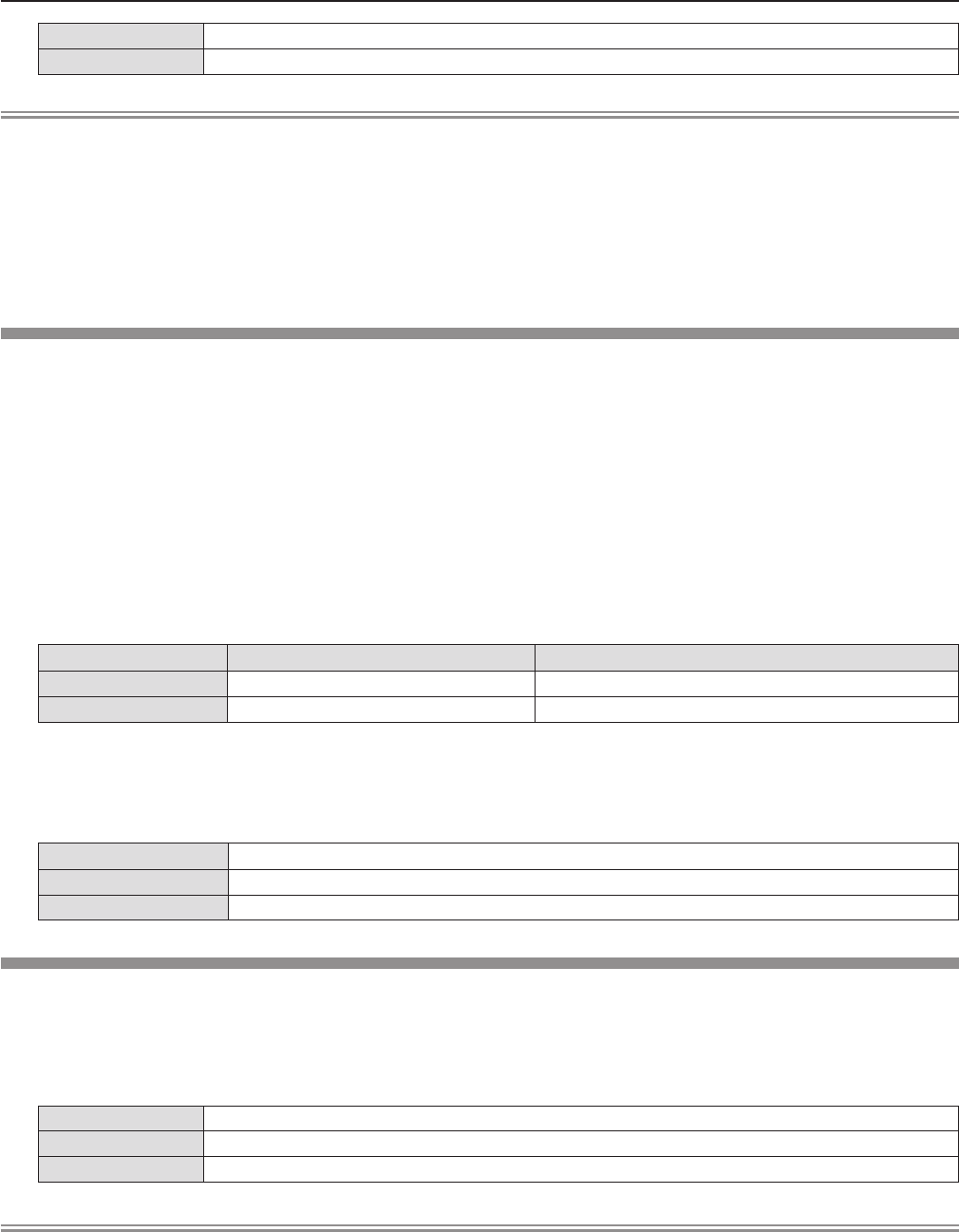
[CC3] Displays CC3 data.
[CC4] Displays CC4 data.
Note
fClosed caption is a function that displays text information of video signals mainly used in North America. Captions may not
be displayed depending on the connected devices or contents being played back.
f[CLOSED CAPTION SETTING] can only be selected if an NTSC or 480i YCBCR signal is input.
fIf [CLOSED CAPTION SETTING] is set to [ON], the brightness of image may be changed according to the external devices
or the used content of the closed caption corresponding connection.
fIf a closed caption signal of the selected mode is input, the text is not displayed even when the [SECURITY] menu → [TEXT
DISPLAY] (x page 86) is set to [ON].
fClosed captions are not displayed when the menu screen is displayed.
[SCREEN SETTING]
(Only for PT-VW355N)
Set the screen size.
When changing the aspect of a projected image, correct to the optimum image position for the set screen. Set as necessary
for the screen in use.
1) Press as to select [SCREEN SETTING].
2) Press the <ENTER> button.
fThe [SCREEN SETTING] screen is displayed.
3) Press as to select [SCREEN FORMAT].
4) Press qw to switch the [SCREEN FORMAT] item.
fThe items will switch each time you press the button.
[SCREEN FORMAT] Description Range when [SCREEN POSITION] is selected
[16:10] The projected aspect ratio is 16:10. Cannot be adjusted.
[16:9] The projected aspect ratio is 16:9. Adjusts the vertical position.
5) Press as to select [SCREEN POSITION].
fIf [SCREEN FORMAT] is set to [16:10], adjustment of [SCREEN POSITION] is not available.
6) Press qw to adjust the [SCREEN POSITION].
fThe items will switch each time you press the button.
[HIGH] The image which aspect ratio is 16:9 will displayed at the top.
[CENTER] The image which aspect ratio is 16:9 will displayed in the center.
[LOW] The image which aspect ratio is 16:9 will displayed at the bottom.
[STARTUP LOGO]
Set the logo display when the power is turned on.
1) Press as to select [STARTUP LOGO].
2) Press qw to switch the item.
fThe items will switch each time you press the button.
[DEFAULT LOGO] Displays the Panasonic logo.
[USER LOGO] Displays the image registered by the user.
[OFF] Disables the startup logo display.
Note
fThe startup logo will disappear in approximately 30 seconds.
fTo create/register the [USER LOGO] image, use “Logo Transfer Software” included in the supplied CD-ROM.
fIf you do not register the image of the [USER LOGO], the startup logo will not be displayed even if the [STARTUP LOGO] is
set to [USER LOGO].
72 - ENGLISH
Chapter 4 Settings - [DISPLAY OPTION] menu
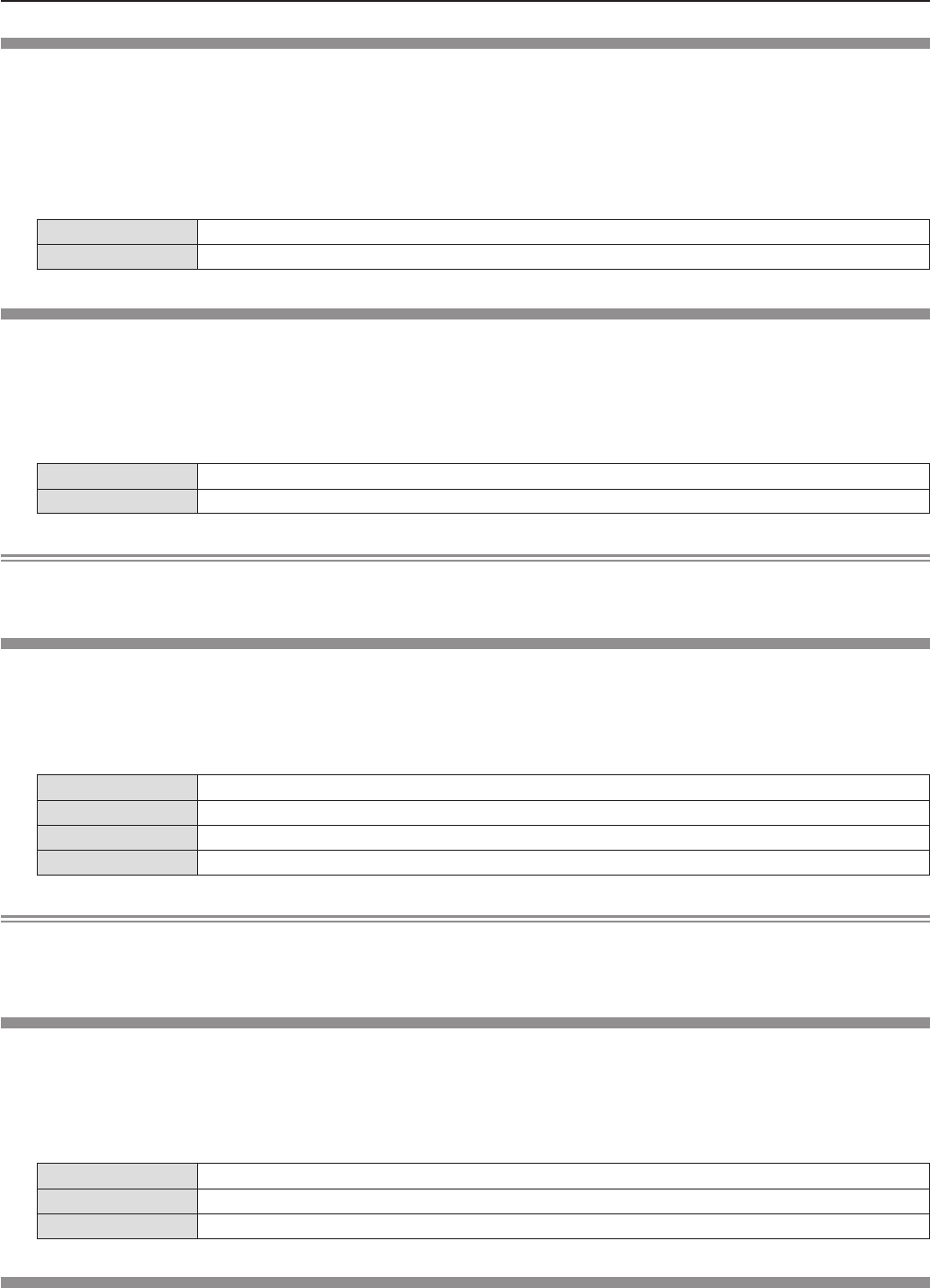
[AUTO SETUP SETTING]
Set the automatic execution of AUTO SETUP.
The screen display position or signal level can be adjusted automatically without pressing the <AUTO SETUP/CANCEL>
button on the remote control on each occasion if you input unregistered signals frequently at meetings, etc.
1) Press as to select [AUTO SETUP SETTING].
2) Press qw to switch the item.
fThe items will switch each time you press the button.
[AUTO] Enables the auto setup function when switching signals.
[BUTTON] Enables the auto setup function only when the <AUTO SETUP/CANCEL> button is pressed.
[SIGNAL SEARCH]
When the power is turned on, this function automatically detects the terminal which signals are input and sets the function to
switch.
1) Press as to select [SIGNAL SEARCH].
2) Press qw to switch the item.
fThe items will switch each time you press the button.
[ON] Enables input detection automatically.
[OFF] Disables input detection automatically.
Note
fIf the [SIGNAL SEARCH] is set to [ON] when there is no signal input, press the <AUTO SETUP/CANCEL> button on the
remote control, this function automatically detects the terminal to which signals are input and then switches.
[BACK COLOR]
Set the display of the projected screen when there is no signal input.
1) Press as to select [BACK COLOR].
2) Press qw to switch the item.
fThe items will switch each time you press the button.
[BLUE] Displays the entire projection area in blue.
[BLACK] Displays the entire projection area in black.
[DEFAULT LOGO] Displays the Panasonic logo.
[USER LOGO] Displays the image registered by the user.
Note
fTo create/register the [USER LOGO] image, use “Logo Transfer Software” included in the supplied CD-ROM.
fIf you do not register the image of the [USER LOGO], the projected image will be displayed in black even if the [BACK
COLOR] is set to [USER LOGO].
[WIDE MODE]
Using this function when displays the incorrect signals input.
1) Press as to select [WIDE MODE].
2) Press qw to switch the item.
fThe items will switch each time you press the button.
[AUTO] Displays by judging the signal automatically. Set to this mode normally.
[ON] When input the wide signal.
[OFF] When input the 4:3 signal.
[SXGA MODE]
This function is used if the whole projected image is not displayed when SXGA signal is input. Set it to [SXGA] normally.
1) Press as to select [SXGA MODE].
2) Press qw to switch the item.
ENGLISH - 73
Chapter 4 Settings - [DISPLAY OPTION] menu
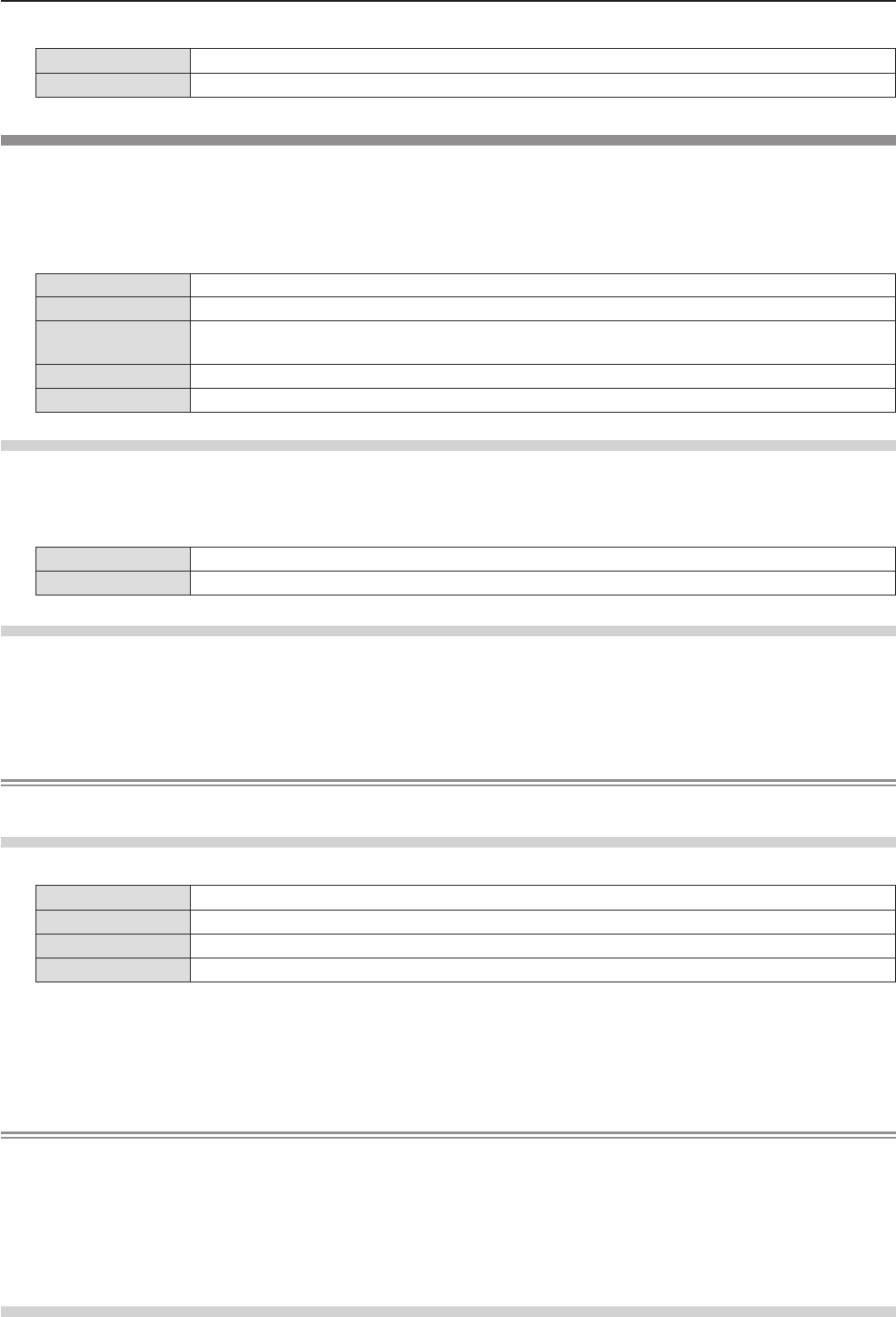
fThe items will switch each time you press the button.
[SXGA] Normal setting.
[SXGA +] Set this when the edge of the image is cropped.
[P-TIMER]
Set and operate the presentation timer function.
1) Press as to select [P-TIMER].
2) Press the <ENTER> button.
fThe [P-TIMER] screen is displayed.
[MODE] Switches the elapsed time between [COUNT UP] and [COUNT DOWN].
[TIMER] Sets the nish time of timer when [COUNT DOWN] is selected.
[START] / [STOP] /
[RESTART] Operates the timer.
[RESET] Resets the count.
[EXIT] [P-TIMER] is nished.
Setting [MODE]
1) Press as to select [MODE].
2) Press qw to switch the item.
fThe items will switch each time you press the button.
[COUNT UP] Displays the elapsed time since the count was started.
[COUNT DOWN] Displays the remaining time of the time set by [TIMER].
Setting the countdown timer
1) Press as to select [TIMER].
2) Press qw to set the timer.
fThe time can be set in 1-minute increments from 1 to 180 minutes.
fThe factory default value is 10 minutes.
Note
f[TIMER] is available only when [MODE] is set to [COUNT DOWN].
The operation of [P-TIMER]
1) Press as to select one item.
[START] The count is started.
[STOP] The count is stopped.
[RESTART] The count is resumed.
[RESET] The count is reset.
2) Press the <ENTER> button.
fWhen you select [START] or [RESTART], the remaining time or the elapsed time will be displayed in the lower right of
the projected image.
fWhen you select [STOP], the remaining time or the elapsed time while stopping the counting will be displayed in the
lower right of the projected image.
Note
fYou can also use the P-TIMER function by pressing the <P-TIMER> button on the remote control (x page 54).
fIf the elapsed time or remaining time is displaying, the text will not be displayed even when the [SECURITY] menu → [TEXT
DISPLAY] (x page 86) is set to [ON].
fThe elapsed time or remaining time will not be displayed when the menu screen is displaying.
fThe start time will be "000:00" when [MODE] is set to [COUNT UP].
fWhen [MODE] is set to [COUNT DOWN], the start time becomes the value set at [TIMER].
fThe time gauge turns clockwise when [COUNT UP] is set, and turns counterclockwise when [COUNT DOWN] is set.
Ending the presentation timer
1) Press as to select [P-TIMER].
74 - ENGLISH
Chapter 4 Settings - [DISPLAY OPTION] menu
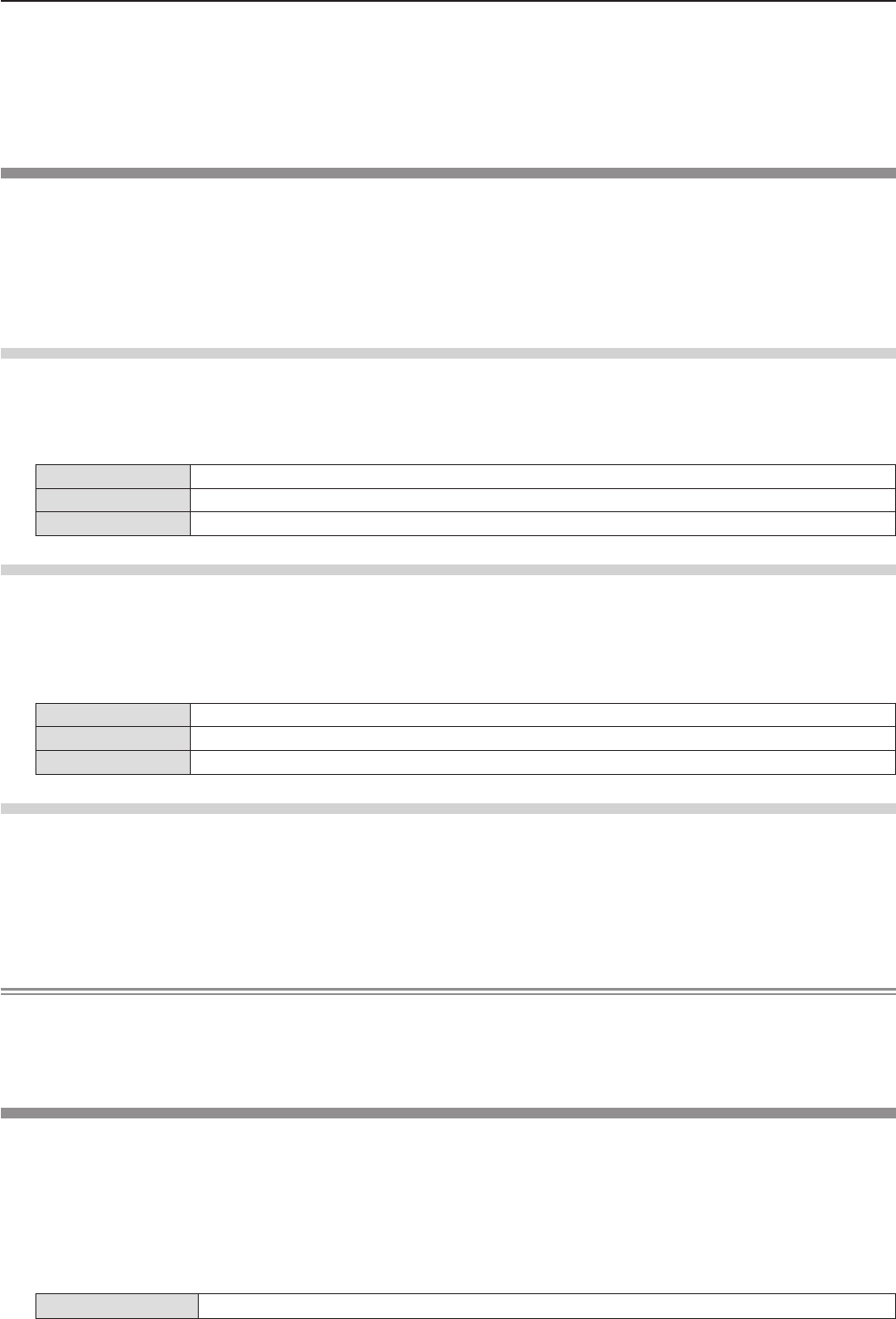
2) Press the <ENTER> button.
fThe [P-TIMER] screen is displayed.
3) Press as to select [EXIT].
4) Press the <ENTER> button.
[P IN P]
(Only for PT-VW355N)
Locate a separate, small sub screen in the main screen to project two images simultaneously.
1) Press as to select [P IN P].
2) Press the <ENTER> button.
fThe [P IN P] screen is displayed.
[MODE]
1) Press as to select [MODE].
2) Press qw to switch the item.
fThe items will switch each time you press the button.
[OFF] P IN P function is disabled.
[SIDE BY SIDE] Sub screen is displayed at the side of the main screen.
[P IN P] Sub screen is displayed in the main screen.
[SUBPICTURE SIZE]
If [MODE] is set to [P IN P], you can change the size of the sub screen.
1) Press as to select [SUBPICTURE SIZE].
2) Press qw to switch the item.
fThe items will switch each time you press the button.
[SMALL] The size of the sub screen is small (30% of the panel resolution).
[MIDDLE] The size of the sub screen is middle (40% of the panel resolution).
[LARGE] The size of the sub screen is large (50% of the panel resolution).
[SUBPICTURE POSITION]
If [MODE] is set to [P IN P], you can change the position of the sub screen.
1) Press as to select [SUBPICTURE POSITION].
2) Press qw to switch the item.
fThe items will switch each time you press the button as following:
[LOWER RIGHT] → [LOWER LEFT] → [UPPER LEFT] →[ UPPER RIGHT] → [LOWER RIGHT] →...
Note
fThe P IN P function may be unavailable for some signals being input or terminals being selected. Refer to “Two-window
display combination list” (x page 140) for details.
fThe main window setting values are applied to image adjustment values such as [PICTURE MODE] and [COLOR
TEMPERATURE].
[OTHER FUNCTIONS]
You can perform some of the remote control button operations from the sub-menu.
1) Press as to select [OTHER FUNCTIONS].
2) Press the <ENTER> button.
fThe [OTHER FUNCTIONS] screen is displayed.
3) Press as to select one item.
[AUTO SETUP] For details, refer to "Using the AUTO SETUP function" (x page 49).
ENGLISH - 75
Chapter 4 Settings - [DISPLAY OPTION] menu

[FREEZE]
The projected image is paused temporarily and the sound stopped regardless of the playback of
the external equipment. To release this function, press the <RETURN> button or the <FREEZE>
button on the remote control.
[AV MUTE] Turn off audio and image when the projector is not used for a certain period of time. To release
this function, press the <RETURN> button or the <AV MUTE> button on the remote control.
[DIGITAL ZOOM] For details, refer to "Using the DIGITAL ZOOM function" (x page 52).
4) Press the <ENTER> button.
76 - ENGLISH
Chapter 4 Settings - [DISPLAY OPTION] menu
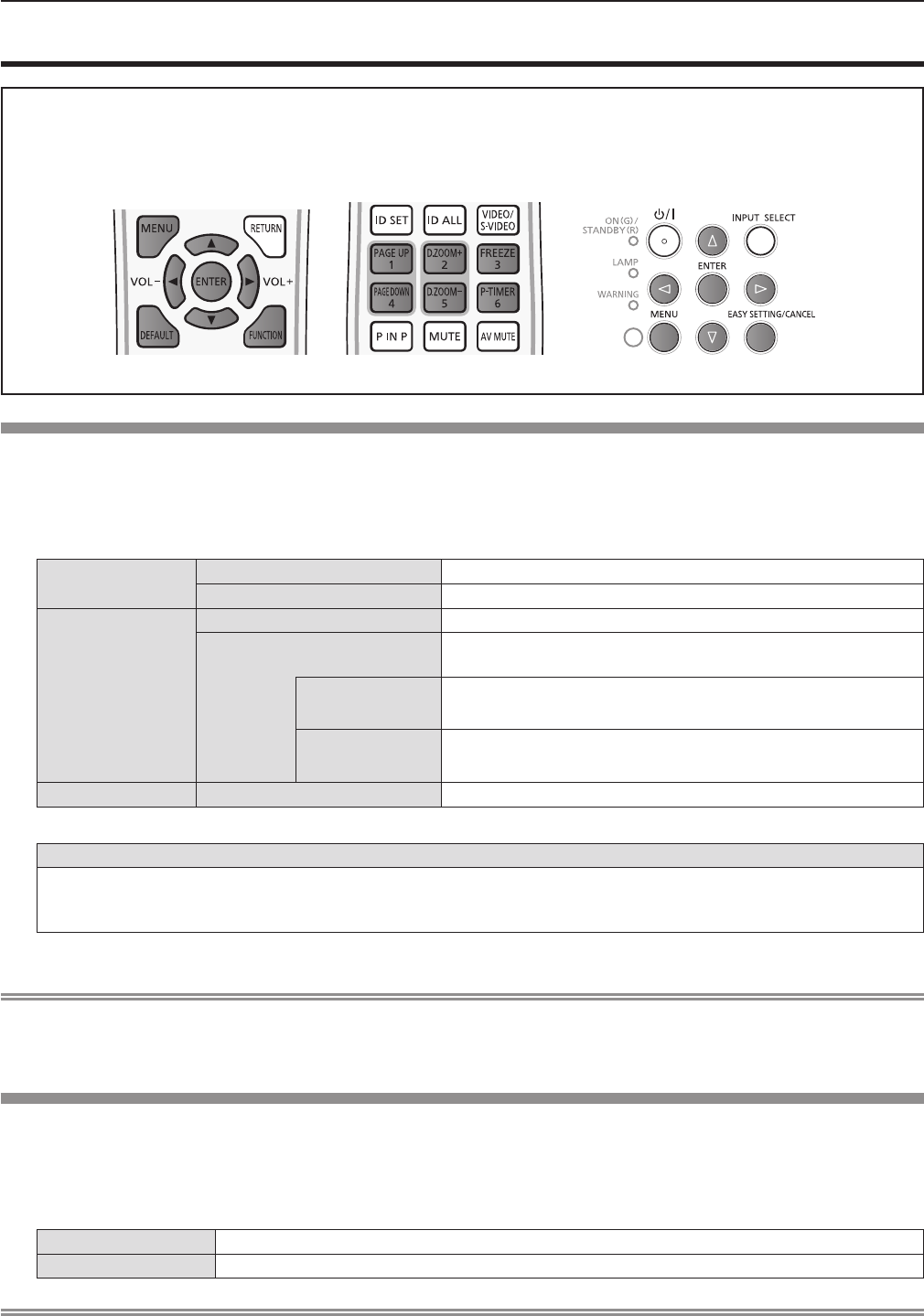
[PROJECTOR SETUP] menu
On the menu screen, select [PROJECTOR SETUP] from the main menu, and select an item from the sub-menu.
Refer to "Navigating through the menu" (x page 56) for the operation of the menu screen.
fAfter selecting the item, press asqw to set.
[STATUS]
You can check the using status of the projector.
1) Press as to select [STATUS].
2) Press the <ENTER> button.
fThe [STATUS] screen is displayed.
[SIGNAL] [NAME] Displays the name of input signal.
[FREQUENCY] Displays the scanning frequency of input signal.
[RUNTIME]*1
[PROJECTOR] Displays the current usage time of projector.
[LAMP (ET-LAV300*2)] Displays the model No. of the replacement lamp unit for this
projector.
[NORMAL] Displays the lamp runtime when [LAMP POWER] is set to
[NORMAL] by actual time.
[ECO] Displays the lamp runtime when [LAMP POWER] is set to [ECO]
by actual time.
[SERIAL NUMBER] [PROJECTOR] Displays the serial number of the projector.
*1 The following conversion is required to calculate the rough estimate for lamp replacement.
Formula for lamp replacement time (rough estimate)
A ×1 + B × 5/7
fA : Runtime which is displayed in [STATUS] screen - [RUNTIME] - [LAMP] - [NORMAL]
fB : Runtime which is displayed in [STATUS] screen - [RUNTIME] - [LAMP] - [ECO]
*2 The model No. of the optional lamp unit is subject to change without prior notice.
Note
fIf you attach a lamp unit used in a projector of a model different from the projector (PT-VW355N, PT-VX425N) to the
projector, or when the lamp unit used in the projector to a projector of a different model, the [RUNTIME] displayed in
[STATUS] may differ from the actual time.
[COMPUTER2 SELECT]
Set whether to use the <COMPUTER 2 IN/1 OUT> terminal.
1) Press as to select [COMPUTER2 SELECT].
2) Press qw to switch the item.
fThe items will switch each time you press the button.
[COMPUTER2 IN] When input the computer signal.
[COMPUTER1 OUT] Outputs the signal which have been input <COMPUTER 1 IN> terminal.
Note
fThe [COMPUTER2 SELECT] will be unavailable when [COMPUTER2] is selected as input source.
ENGLISH - 77
Chapter 4 Settings - [PROJECTOR SETUP] menu
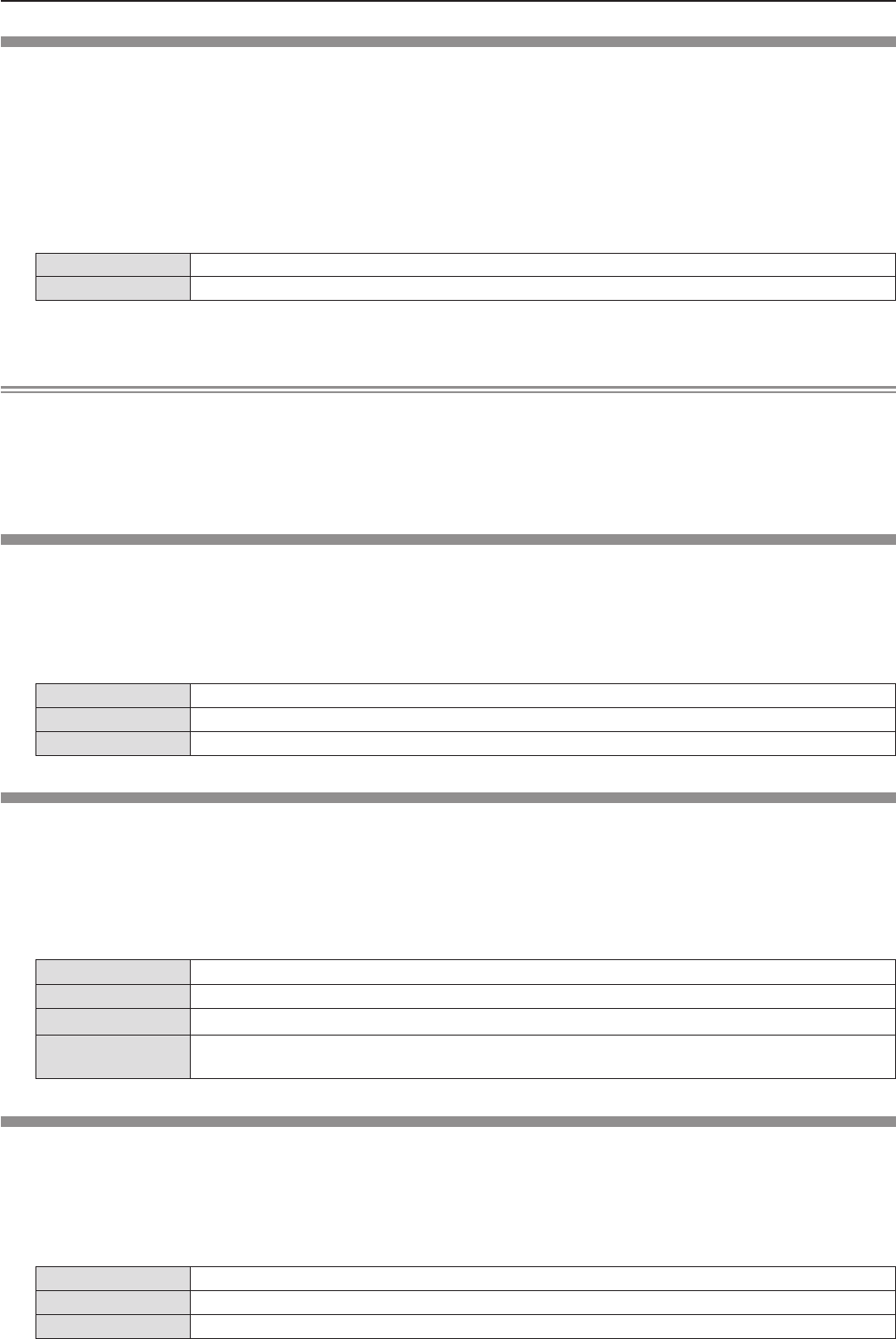
[PROJECTOR ID]
The projector has an ID number setting function that can be used when multiple projectors are used side by side to enable
simultaneous control or individual control via a single remote control.
1) Press as to select [PROJECTOR ID].
2) Press the <ENTER> button.
fThe [PROJECTOR ID] screen is displayed.
3) Press as to select a projector ID.
fSelect one from [ALL], and [1] to [6].
[ALL] Select when controlling projectors without specifying an ID number.
[1] - [6] Select when specifying an ID number to control individual projector.
4) Press the <ENTER> button to set it.
f[PROJECTOR ID] is set.
Note
fTo specify an ID number for individual control, the ID number of a remote control must match the ID number of the projector.
fWhen the ID number is set to [ALL], the projector will operate regardless of the ID number specied during remote control or
computer control.
If multiple projectors are set up side by side with ID set to [ALL], they cannot be controlled separately from the projectors
with other ID numbers.
fRefer to “Setting the ID number of the remote control” (x page 54) for how to set the ID number on the remote control.
[INITIAL START UP]
Set the method of start up when the power cord plugged into the AC outlet.
1) Press as to select [INITIAL START UP].
2) Press qw to switch the item.
fThe items will switch each time you press the button.
[LAST MEMORY] Starts in the condition that before disconnected the power cord or turn off the breaker.
[STANDBY] Starts up in the standby mode.
[ON] Starts the projection immediately.
[PROJECTION METHOD]
Set the projection method in accordance with the installation status of the projector.
Change the projection method if the screen display is upside down or inverted.
1) Press as to select [PROJECTION METHOD].
2) Press qw to switch the projection method.
fThe items will switch each time you press the button.
[FRONT/DESK] When installing the projector on the desk, etc., in front of the screen.
[FRONT/CEILING] When installing the projector in front of the screen with the Ceiling Mount Bracket (optional).
[REAR/DESK] When installing the projector on the desk, etc. behind the screen (with a translucent screen).
[REAR/CEILING] When installing the projector behind the screen (with a translucent screen) with the Ceiling Mount
Bracket (optional).
[HIGH ALTITUDE MODE]
Change the setting according to the altitude in which you use the projector.
1) Press as to select [HIGH ALTITUDE MODE].
2) Press qw to switch the item.
fThe items will switch each time you press the button.
[OFF] When using the projector in the elevation of below 1 400 m.
[HIGH1] When using the projector in the elevation of above 1 400 m and below 2 000 m.
[HIGH2] When using the projector in the elevation of above 2 000 m and below 2 700 m.
78 - ENGLISH
Chapter 4 Settings - [PROJECTOR SETUP] menu
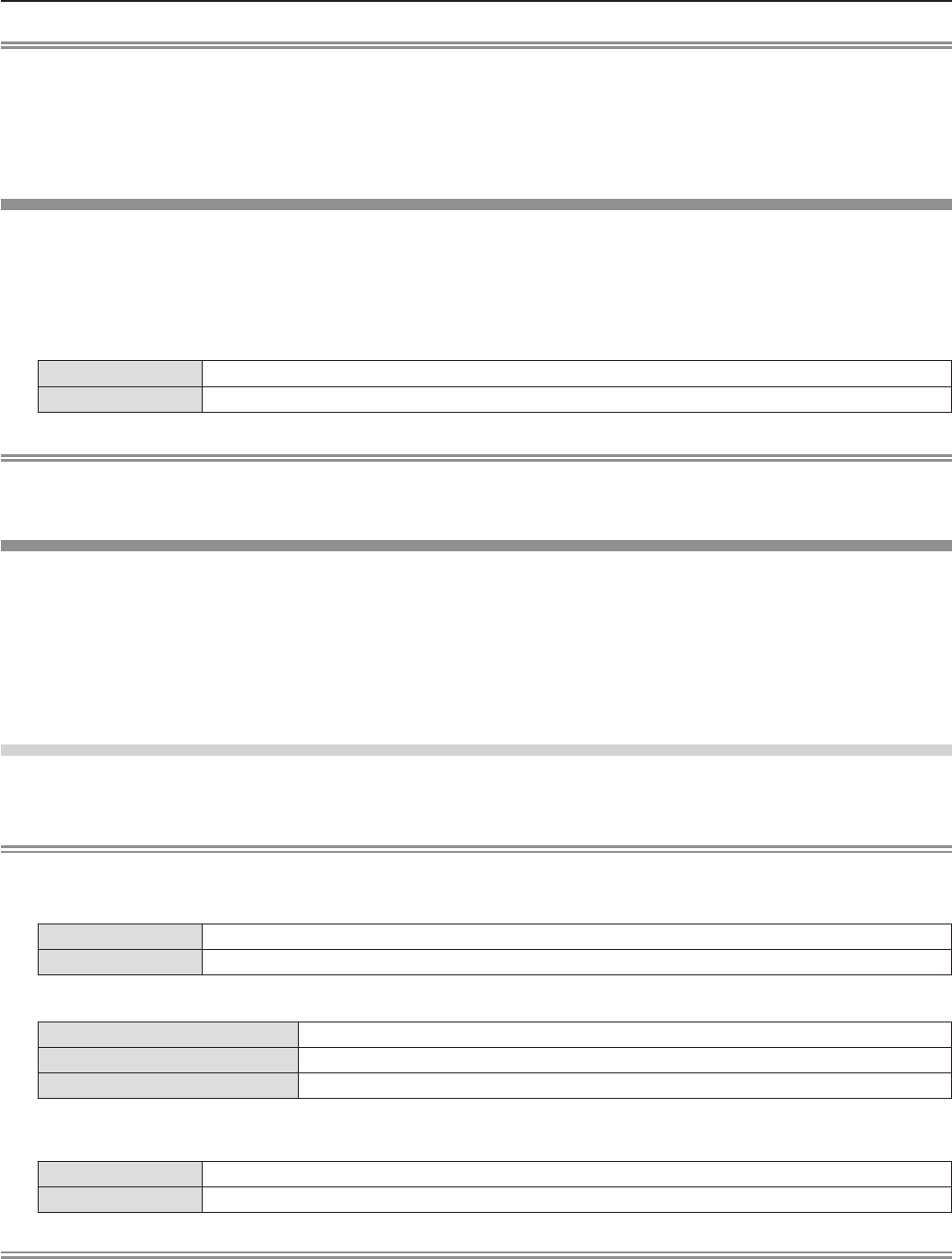
Note
fIt is set to [OFF] when using the projector in the elevation of below 1 400 m. It is set to [HIGH1] when using the projector in
the elevation of above 1 400 m and below 2 000 m. It is set to [HIGH2] when using the projector in the elevation of above
2 000 m and below 2 700 m. Failure to do so may shorten the life of the internal parts and result in malfunctions.
fDo not set the projector in the elevation of 2 700 m or above, otherwise it may shorten the life of the internal parts and result
in malfunctions.
fWhen it is set to [HIGH1] or [HIGH2], the fan noise becomes louder and fan speed increases.
[LAMP POWER]
Switch the brightness of the lamp according to the operating environment of the projector or the purpose.
1) Press as to select [LAMP POWER].
2) Press qw to switch the item.
fThe items will switch each time you press the button.
[NORMAL] Select when high luminance is required.
[ECO] Select when high luminance is not required.
Note
fSet it to [ECO] rather than [NORMAL] when you want to reduce power consumption, extend the life of lamp and reduce
operation noise.
[ECO MANAGEMENT]
This function optimizes lamp power according to the operating status to reduce power consumption.
1) Press as to select [ECO MANAGEMENT].
2) Press the <ENTER> button.
fThe [ECO MANAGEMENT] screen is displayed.
3) Press as to select one item.
Setting [AUTO POWER SAVE] in step 3)
Set whether or not to enable the three functions, [AMBIENT LIGHT DETECTION], [SIGNAL DETECTION] and [AV MUTE
DETECTION].
Note
f[AUTO POWER SAVE] cannot be set when the [LAMP POWER] is set to [ECO].
4) Press qw to switch the [AUTO POWER SAVE].
[ON] Enables power-saving mode.
[OFF] Disables power-saving mode.
5) Press as to select one item.
[AMBIENT LIGHT DETECTION] Adjusts the lamp power according to the ambient brightness.
[SIGNAL DETECTION] Drops the lamp power when no signal is input.
[AV MUTE DETECTION] Drops the lamp power in the AV mute mode.
6) Press qw to switch the item.
fThe items will switch each time you press the button.
[ON] Enables above setting.
[OFF] Disables above setting.
Note
fLamp power cannot reduced automatically in the following cases:
- When [LAMP POWER] is set to [ECO]
- When the lamp lighting is just completed or the setting of [LAMP POWER] is just completed, etc..
fWhen [AUTO POWER SAVE] is set to [OFF], [AMBIENT LIGHT DETECTION], [SIGNAL DETECTION] and [AV MUTE
DETECTION] cannot be set.
f[AMBIENT LIGHT DETECTION] will not work correctly when placing some objects on the ambient luminance sensor.
ENGLISH - 79
Chapter 4 Settings - [PROJECTOR SETUP] menu
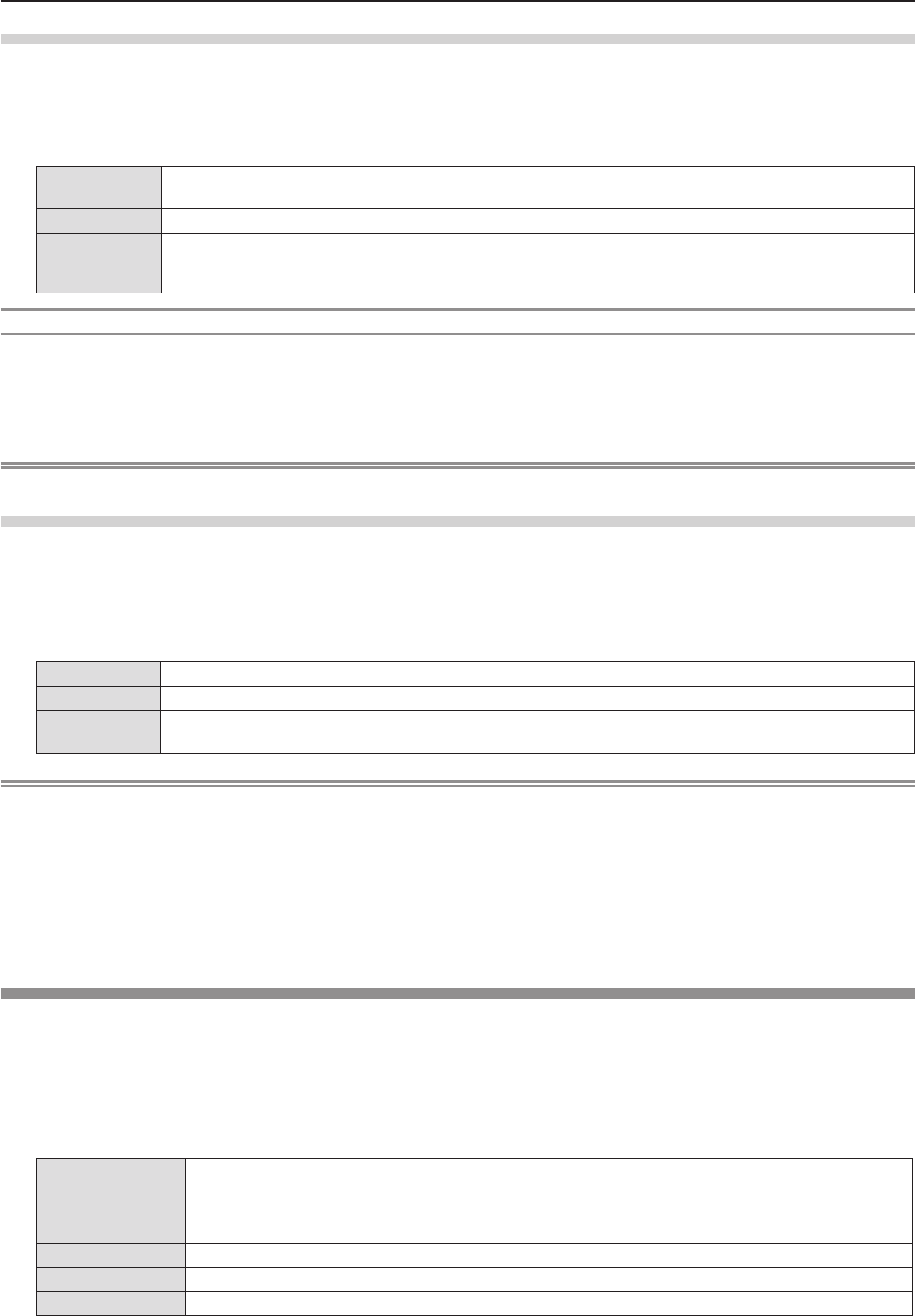
Setting [POWER MANAGEMENT] in step 3)
Set the operation as following if there is no signal input.
1) Press as to select [POWER MANAGEMENT].
2) Press qw to switch the item.
fThe items will switch each time you press the button.
[SHUT DOWN] The countdown timer is displayed after 30 seconds without input signal. The projection lamp is turned
off and cooled down when reached the set time, then the projector enter into standby status.
[OFF] Power management function is off.
[READY]
The countdown timer is displayed after 30 seconds without input signal. The projection lamp turns off
and cools down when reaching the set time, meanwhile the projector is in the power management
mode. The projection lamp will be turned on if the input signal is reconnected or any button is pressed.
Setting [TIMER]
The timer can be set to 5-120 minutes. The increment is 5 minutes.
1) Press as to select [TIMER].
2) Press qw to set the timer (5-120 MIN.).
fThe time will switch each time you press the button.
Note
fThe factory default setting for [TIMER] is [15 MIN.].
Setting [STANDBY MODE] in step 3)
Set the operation mode during standby. The default setting is [ECO] that keeps power consumption low during standby. When
the network function or the serial communication function is used during standby, set to [NORMAL].
1) Press as to select [STANDBY MODE].
2) Press qw to switch the item.
fThe items will switch each time you press the button.
[ECO] Select this item to reduce power consumption during standby.
[NORMAL] Select this item to use the network function or the serial communication function during standby.
[NETWORK] Select this item to reduce power consumption during standby, and to operate the projector via the
wired LAN or the serial communication function by using the Wake on LAN function.
Note
fIf [STANDBY MODE] is set to [ECO], you cannot use network functions when the projector is standing by. Also, you cannot
use some RS-232C protocol commands.
fWhen set to [ECO], it may take approx. 10 seconds longer before the projector starts projecting after the power is turned on,
compared with when [NORMAL] is set.
fIf [STANDBY MODE] is set to [NETWORK], it takes less power consumption than it is set to [NORMAL].
fWhen [STANDBY MODE] is set to [NETWORK], it will be no restriction for network function and serial communication
function within 60 seconds when the Wake on LAN function is working.
fThe setting of [STANDBY MODE] cannot be returned to the factory default even if the [PROJECTOR SETUP] menu →
[INITIALIZE ALL] is executed (x page 84).
[EMULATE]
When controlling the projector on a computer via the <SERIAL IN> terminal, set use of control commands on a previously
purchased Panasonic projector. This allows the control software for an existing Panasonic projector to be inherited and used.
1) Press as to select [EMULATE].
2) Press the <ENTER> button.
fThe [EMULATE] screen is displayed.
3) Press as to select one item.
[DEFAULT]
VW355N series, VX425N series, VZ575N series, VW535N series, VX605N series, VZ570 series,
VW530 series, VX600 series, EZ580 series, EW640 series, EX610 series, EW540 series,
EZ770 series, EW730 series, EX800 series, VW345N series, VX415N series, VW340Z, VX410Z,
VX42Z, RZ475 series, RZ470 series, RW430 series, RZ370 series, RW330 series
[D3500] D3500 series
[D4000] D4000 series
[D/W5k SERIES] D5700 series, DW5100 series, D5600 series, DW5000 series, D5500 series
80 - ENGLISH
Chapter 4 Settings - [PROJECTOR SETUP] menu